Biodiversity in Urban Areas: The Extraordinary Case of Appia Antica Regional Park (Rome, Italy)
Abstract
1. Introduction
2. Materials and Methods
3. Study Area
3.1. Geographical Context
- ⮚
- on the west: Terme di Caracalla street up to the Scott Park in Ardeatino district (toward the south); Ardeatina street up to the hamlet Falcognana (part of the Municipality of Rome located about 4 km from the Great Ring Junction toward the south) with the exclusion of an area around Fioranello street. In addition, the area named Tor Marancia (about 220 ha) occurs to the west of Ardeatina street (Ardeatino district, north of the park);
- ⮚
- on the south: Falcognana street between the hamlets Falcognana (to the west) and Poggio Le Mole (Municipality of Marino, to the east), with the exclusion of the hamlet Santa Maria delle Mole;
- ⮚
- on the east: Appia Nuova street from the hamlet Frattocchie (Municipality of Marino) to the Roman urban area named Arco di Travertino; Latina street (with the exclusion of part of the district Appio Latino between Antonio Coppi street and the railway) up to Numa Pompilio square. In addition, two archeological areas occur to the east of Appia Nuova street, named Acquedotti (about 240 ha) and Latin tombs (about 2 ha);
- ⮚
- on the north: Numa Pompilio square.
3.2. Geological Features
3.3. Geomorphological Features
- ⮚
- Fluvial landforms: the study area is characterized by a more or less structured hydrographic network composed mainly of channels, mostly with steady water flows, natural ponds, and freshwater springs. The most complex networks can be found in the Caffarella (north of the park) and Acquedotti (east) areas.
- ⮚
- Structural landforms: these forms are the results of the fluvial erosion cut of the flat ignimbritic plateau generated after the eruption of the Colli Albani volcano (middle Pleistocene); surfaces are often bordered by cliffs affected by various weathering and denudation processes [37]. Some structural landforms can be observed in the Caffarella valley, where the volcanic plateau was cut by the Almone River (Figure 5).
- ⮚
- Gravitational landforms: two main types were observed, i.e., falls, which occur especially in the Caffarella valley and Tor Marancia locality where there are some slopes with a high gradient (more than 80%, even vertical) (Figure 6) (no data occur in the map of the Italian landslide for the study area [47]) and sinkholes originating from the collapse of underground cavities (see below under “Man-made landforms”) and the subsequent subsidence of the shallower layers of the soil [48]. The latter gravitational landforms have dimensions ranging from 1–6 m of depth and 1–12 m of diameter (pers. obs.) (Figure 6).
- ⮚
- Man-made landforms: the study area has been affected by several human activities mostly beginning thousand years ago. The marks of these activities are often juxtaposed with those related to the natural processes [37].
- ⮚
- the first lake (locally named Laghetto della Caffarella = Caffarella’s small lake) was created in 2004 for the natural regeneration of aquatic habitats. Caffarella’s lake has one tributary and one emissary (linked with the nearby channel), covers an area of about 2000 m2 (including the surrounding humid meadows), and has a maximum depth of 1.5 m;
- ⮚
- the second lake (locally named Laghetto degli Acquedotti = Acquedotti’s small lake) was redeveloped about 10 years ago under planning for both the body of water and the adjacent channel Acqua Mariana, which serves as both tributary and emissary. The Aquedotti’s lake covers an area of about 800 m2 and has a maximum depth of 0.5 m.
3.4. Climate and Phytoclimate
- ⮚
- Mesomediterranean Subhumid-Thermomediterranean Subhumid: this subtype (area outside of the Great Ring Junction) is characterized by a mean annual precipitation of 680–820 mm, mean summer precipitation of 82.23–96.34 mm, mean annual temperature of 14.60–15.21 °C, maximum annual temperature of 19.95–21.39 °C, minimum annual temperature of 9.27–10.41 °C. The potential natural vegetation concerns four vegetation series: Turkey oak Series [Teucrio siculi-Quercion cerris Ubaldi 1988 (Crataego levigatae-Quercion cerridis Arrigoni 1997 sensu [43])], Downy and Turkey oaks Series [Ostryo-Carpinion orientalis Horvat 1959 (Fraxino orni-Ostryon Tomažič 1940 sensu [43]) and Lonicero etruscae-Quercion pubescentis Arrigoni et Foggi ex Foggi et al. 1990 (Crataego laevigatae-Quercio cerridis Arrigoni 1997 sensu [43])], Holm oak Series (Quercion ilicis Br.-Bl. ex Molinier 1934), and Hornbeam Series [Doronico-Fagion Ubaldi et al. 1990 (Geranio striati-Fagion Gentile 1970 sensu [43])]. As a meteorological reference point, the thermo-pluviometric station is that named Ciampino (129 m a.s.l.); the thermo-pluviometric diagram (Figure 10) shows mean temperatures of the coldest (January) and the hottest (August) months of, respectively, 7.3 and 24.9 °C; mean annual rainfall is 792.8 mm [maximum monthly value in November (112.6 mm), minimum in July (22.1 mm)]; aridity is about 3 months;
- ⮚
- Mesomediterranean Subhumid-Thermomediterranean Dry: this subtype (interior area to the Great Ring Junction) is characterized by a mean annual precipitation of 650–820 mm, mean summer precipitation of 56.9–76.6 mm, mean annual temperature of 14.60–15.21 °C, maximum annual temperature of 18.88–21.16 °C, minimum annual temperature of 9.27–10.41 °C. Potential natural vegetation regards three vegetation series: Turkey oak Series [Teucrio siculi-Quercion cerris (Crataego laevigatae-Quercio cerridis sensu [43])], Downy and Turkey oak Series [Ostryio-Carpinion orientalis (Fraxino orni-Ostryon sensu [43]) and Lonicero-Quercion pubescentis (Crataego laevigatae-Quercio cerridis sensu [43])], and Holm oak Series (Quercion ilicis). The meteorological reference point is the thermo-pluviometric station of Monte Mario (143 m a.s.l.); the thermo-pluviometric diagram (Figure 10) shows mean temperatures of the coldest (January) and the hottest (July) months of, respectively, 7.4 and 24.0 °C; mean annual rainfall is 766.0 mm [maximum monthly value in November (113.0 mm), minimum value in July (17.0 mm)]; aridity is about 2 months.
3.5. Landscape Remarks and Actual Vegetation Physiognomies
- ⮚
- Zonal vegetation:
- Vegetation of the nemoral forest zone:
- >
- Zonal temperate broad-leaved forests:
- Quercetea pubescentis Doing-Kraft ex Scamoni et Passarge 1959 (Figure 16): mixed forest communities of deciduous species mainly occurring in northern areas of the park; common species are: Quercus ilex L. subsp. ilex, Q. pubescens, Q. petraea (Matt.) Liebl., Fraxinus ornus L., Acer campestre L. among trees, and Crataegus monogyna Jacq., Euonymus europaeus L., Cornus sanguinea L. subsp. sanguinea, and Viburnum tinus L. among shrubs;
- Quercetea robori-petraeae Br.-Bl. et Tx. ex Oberd. 1957: a small forest dominated by Quercus robur L. subsp. robur occurs in the northern area of the park (Cartiera Latina locality);
- >
- Intrazonal scrub and woodlands of the nemoral zone:
- 3.
- Robinietea Jurko ex Hadac et Sofron 1980: it comprises anthropogenic woody vegetation (Figure 17) characterized by an high presence of Robinia pseudoacacia L. and or Ailanthus altissima (Mill.) Swingle. Other common species are: Sambucus nigra L., Ulmus minor Mill. subsp. minor (among trees), Rubus ulmifolius Schott (among shrubs); herb layer is dominated by nitrophilous taxa, e.g., Galium aparine L. and Urtica dioica L. These types of vegetation occur sparsely throughout the study area;
- 4.
- Crataego-Prunetea Tx. 1962: scrub vegetation occurring as patches among the cultivated fields or along the margins of the forests. The main communities occurring in the study area are those with Cornus sanguinea subsp. sanguinea, Crataegus monogyna, Euonymus europaeus, Prunus spinosa L. subsp. spinosa, Rhamnus alaternus L. subsp. alaternus, Rosa canina L., Rubus ulmifolius, etc. (Figure 18), whereas in the areas more affected by human pressures, monophytic communities with Rubus ulmifolius occur (Figure 18). Further shrub communities are those dominated by Paliurus spina-christi Mill. (which can be found in Caffarella valley in areas that are not or only marginally affected by pasture; Figure 19), Spartium junceum L. (often on the top of cliffs; Figure 19), and groups of species (Cornus sanguinea subsp. sanguinea, Ligustrum vulgare L., Euonymus europaeus, Crataegus monogyna, Ulmus minor subsp. minor) that occupy the anthropic sinkholes originating from the collapse of underground cavities;
- >
- Intrazonal boreo-temperate grasslands and heath:
- 5.
- Molinio-Arrhenatheretea Tx. 1937: anthropogenic managed pastures, meadows and tall-herb meadow fringes on fertile deep soils at low and mid-altitudes.
- ■
- Cool Temperate Group of Alliances:
- ⮚
- Cynosurion cristati Tx. 1947 (Arrhenatheretalia elatioris Tx. 1931): mesophilous grasslands, grazed and mown once, growing on well-drained mineral/nutrient-rich soils. These communities are common throughout the park, particularly in the areas affected by human recreational use (Figure 20).
- Vegetation of the mediterranean zone:
- >
- Zonal mediterranean forests and scrub:
- 6.
- Quercetea ilicis Br.-Bl. ex A. Bolós et O. de Bolós in A. Bolós y Vayreda 1950: thermo-mesomediterranean oak forests and associated Mediterranean macchia. Small forest patches with Quercus ilex subsp. ilex (Figure 21) or Q. suber L. and Mediterranean macchia occur. Holm oak forests are present in Caffarella and Tor Marancia localities. Only one patch of corn oak forest remains (the so-called Boschetto Farnese = Farnese’s wood, included in the private farmstead “Farnesiana”); this forest is represented by a mixed evergreen/deciduous species where Q. suber grows together with Q. pubescens and Q. ilex subsp. ilex, whereas the shrub layer is composed by Ulmus minor subsp. minor, Rubus ulmifolius, Crataegus monogyna, Prunus spinosa subsp. spinosa, Euonymus europaeus, Rhamnus alaternus subsp. alaternus, Cornus sanguinea subsp. sanguinea, and C. mas L. Finally, the residual patches of Mediterranean macchia, which are dominated by Arbutus unedo L., Phillyrea latifolia L., and Quercus ilex subsp. ilex (Figure 21).
- Azonal vegetation:
- >
- Alluvial forests and scrub:
- 7.
- Alno glutinosae-Populetea albae P. Fukarek et Fabijanic 1968: Mediterranean riparian communities on soils with high water table; this type is well represented in the park along rivers and channels, especially in the central and north zones of Caffarella valley and Tor Marancia locality, where forests are dominated by Populus nigra L., Salix alba L. subsp. alba, and Fraxinus angustifolia Vahl. subsp. oxycarpa (M.Bieb ex Willd.) Franco & Rocha Afonso (Figure 22).
- Vegetation of rock crevices and screes:
- >
- Adiantetea Br.-Bl. et al. 1952: communities dominated by Adiantum capillus-veneris L. and bryophytes that grow on siliceous dripping cliffs; they are common along deeper channels and springs (Figure 23).
- 8.
- Cymbalario-Parietarietea diffusae Oberd. 1969: thermo-nitrophilous Mediterranean chasmophytic vegetation of walls and cliffs; quite distributed on both natural (volcanic cliffs) and anthropic (aqueducts, walls) surfaces. Frequent species are: Antirrhinum majus L., Capparis orientalis Veill., Cymbalaria muralis G.Gaertn., B.Mey. & Schreb. subsp. muralis, Ficus carica L., Fumaria capreolata L., Parietaria judaica L., Reichardia picroides Roth, Sonchus tenerrimus L., Umbilicus rupestris (Salisb.) Dandy (Figure 24).
- Freshwater aquatic vegetation:
- 9.
- Lemnetea O. de Bolos et Masclans 1955: pleustophytic vegetation that colonizes fresh waters; in the territory of the park, these communities mainly occur on weakly flowing waters (channels or lakes) where the alien Lemna minuta Kunth dominates the autochthonous L. minor L. (Figure 25).
- Vegetation of freshwater springs, shorelines and swamps.
- 10.
- Phragmito-Magnocaricetea Klika in Klika et Novak 1941: perennial helophytic communities colonizing lacustrine and fluvial areas on eu- to mesotrophic soils of freshwater bodies; the communities mostly occur in the northern sector of the park along channels or around ponds and artificial lakes (Figure 26). Common species are: Alisma plantago-aquatica L., Apium nodiflorum (L.) Lag., Arundo donax L. (which often forms monophytic communities; Figure 27), Equisetum telmateja Ehrh., Lymniris pseudacorus (L.) Fuss., Nasturtium officinalis R.Br., Phragmites australis (Cav.) Tin. ex Steud., Symphytum officinale L., Typha latifolia L. (which sometimes forms monophytic communities; Figure 28), Veronica anagallis-aquatica L.
- Anthropogenic vegetation: secondary vegetation communities that derive from direct or indirect results of human action; they are represented by several types occurring throughout the study area; most of these types are meadow for-mations. The main types observed are listed as follows:
- 11.
- Papaveretea rhoeadis S. Brullo et al. 2001 (= Secalinetea Br.-Bl. In Br.-Bl. et al. 1952 = Stellarietea mediae Tx. et al. in Tx. 1950): annual weed segetal vegetation of arable crops on base-rich soils; it is widely distributed in Appia Antica Regional Park since crops represent the landscape matrix (Figure 29).
- 12.
- Sisymbrietea Gutte et Hilbig 1975: anthropogenic vegetation of animal shelters and disturbed ruderal sites (Figure 30).
- 13.
- Polygono-Poetea annuae Rivas-Mart. 1975: nitrophilous pioneer vegetation of trampled habitats. This type of vegetation is common, especially on roadsides and crevices of paved roads (Figure 31).
- 14.
- Artemisietea vulgaris Lohmeyer et al. in Tx. ex von Rochow 1951: perennial meso-xerophilous ruderal vegetation. The most common communities found in the park are dominated by Silybum marianum (L.) Gaertn. (margins of fields and uncultivated lands; Figure 32), Conium maculatum L. (banks of water courses; Figure 32), and Sambucus ebulus L. (humid and disturbed soils near rivers and channels; Figure 32).
- 15.
- Chenopodietea Br.-Bl. in Br.-Bl. et al., 1952: weed segetal and ruderal vegetation of man-made habitats. This group includes many types in the park, the most common are the Mediterranean annual grasslands of Hordeion murini Br.-Bl. in Br.-Bl. et al. 1936 and Securigero securidacae-Dasypyrion villosi Cano-Ortiz, Biondi et Cano in Cano-Ortiz et al. ex Di Pietro in Di Pietro et al., 2015. The former is represented by ruderal grasslands occurring in nutrient-rich soils characterized by a high presence of humans (Figure 33). The second group (Securigero securidacae-Dasypyrion villosi) includes the therophytic anthropogenic grasslands in fallow-land habitats of the central regions of the Apennine Peninsula; this type of vegetation is dominated by Dasypyrum villosum (L.) P.Candargy (Figure 33), representing one of the most widespread anthropogenic steppe formations in the Roman countryside [54].
- 16.
- Epilobietea angustifolii Tx. et Preising ex von Rochow 1951 (=Galio-Urticetea Passarge 1967): tall-herb semi-natural perennial vegetation on disturbed forest edges and nutrient-rich riparian fringes (Figure 34).
4. Results
4.1. General Statistics of the Flora
4.2. Life Form Analysis
4.3. Geographical Analysis
4.4. Floristic Notes
4.4.1. New Record for Europe and First One Out of the Native Range
- ⮚
- D. bessac (Choiv.) E. Gagnon & G.P. Lewis (≡ Caesalpinia bessac Chiov.): Chiovenda described this species (sub Caesalpinia bessac) in his Flora Somala [58], providing a detailed description that matches the plants found in Caffarella valley. The same author described also C. eriantherum Chiov. (see below) as morphologically similar to C. bessac. These two species differ from each other by the size of their leaflets, which are longer in C. bessac (basal leaflets 9–12 mm long vs. 4–5 mm long in C. eriantherum; distal leaflets 10–20 mm long vs. 7–8 mm long in C. eriantherum).
- ⮚
- D. buchii (Urb.) E. Gagnon & G.P. Lewis (≡ Denisophytum buchii Urb.): this species displays the calyx as 7–8 mm long according to the protologue [59], whereas plants found in Caffarella have a calyx 3–5 mm long; furthermore, the leaflets are emarginate at the apex in D. buchii (“foliolis... apice emarginatis”), while leaflets in my specimens are obtuse to rounded.
- ⮚
- D. eriantherum (Chiov.) E. Gagnon & G.P. Lewis (≡ Caesalpinia eriantherum Chiov.): on the basis of the original description by Chiovenda ([58] sub Caesalpinia eriantherum), plants found in Caffarella valley differ by both the size of leaflets [those basal 4–5 mm long (protologue) vs. 8–12 mm long (Caffarella plants); those distal 7–8 mm long (protologue) vs. 15–20 mm long (Caffarella plants) and the number of flowers per inflorescence, i.e., 10 (protologue) vs. up to 30 (Caffarella plants)]. Further, a var. pubescens (Brenan) E. Gagnon & G.P. Lewis (≡ Caesalpinia erianthera var. pubescens Brenan) is currently accepted, but it is characterized in having leaflets that are densely pubescent [60], whereas Roman plants have leaves that are glabrous.
- ⮚
- D. madagascariense R. Vig.: it is the only unarmed species in Denisophytum [57] pag. 45, while Caffarella plants have curved thorns along the shoot.
- ⮚
- D. pauciflorum (Griseb.) E. Gagnon & G.P. Lewis (≡ Libidibia pauciflora Griseb.): this species is different from all other species in having few flowers per raceme (“recemis simplicibus laxis paucifloris (v. pedunculis 1floris)" in the protologue [61]) and corolla slightly longer than the calyx (“calycis... corolla paullo superantibus”), whereas my specimens have many flowers per raceme (up to 30, never less than 20), and corollas are 5–7 times longer than the calyx.
- ⮚
- D. rosei (Urb.) E. Gagnon & G.P. Lewis (≡ Caesalpinia rosei Urb.): it has leaflets glaucous in the abaxial surface (“foliole... in siccu supra obscure viridia, subtus valde pallida, glaucescentia” in the protologue [62]). Plants found in Rome show leaves green on both surfaces.
- ⮚
- D. sessilifolium (S.Watson) E. Gagnon & G.P. Lewis (≡ Caesalpinia sessilifolia S.Watson): it is characterized in having sessile leaves, each one with two or three pairs of pinnae according to the protologue [63]. Caffarella plants have leaves that are petiolate with mostly five pairs of pinnae (rarely four).
- ⮚
- D. stuckertii (Hassl.) E. Gagnon & G.P. Lewis (≡ Caesalpinia stuckertii Hassl.): the diagnosis and description given in the protologue [64] are congruent with the morphology of the plants found in Caffarella valley, except for the fruit, which was described as “oblongum basi et apice acutum”, whereas fruits in Caffarella’s plants have apexes that are obtuse-rounded (Figure 41); also, the illustration given by Gagnon and collaborators [57] pag. 44, Figure 12 displays a typical fruit of D. stuckertii, confirming that Roman plants cannot be assigned to this Denisophytum species. Further, Gagnon and collaborators’ illustration shows stipules that are clearly different from those of the Roman plants (foliaceous with two lobes vs. narrow, not lobed).
4.4.2. New Records or Changes in Alien Status for Italy
4.4.3. New Records or Confirmations for Latium
4.4.4. Changes or Confirmation of Alien Status for Latium
4.4.5. New Records or Confirmations for Rome
4.4.6. Species No Longer Recorded
4.4.7. Species Having Loci Classici and/or Nomenclatural Types Collected in Appia Antica Regional Park
4.4.8. Other Notable Species
5. Discussion and Conclusions
- >
- Robinia psudoacacia and Ailathuts altissima: these two trees (both invasive in the park) are common along edges of forests and into shrubby mantels, as well as in human-made habitats and on ruins. In various cases, R. psudoacacia and A. altissima even form more or less dense woody communities (Figure 17 and Figure 83);
- >
- >
- Lonicera japonica Thumb.: this species is considered to be a naturalized alien in the park, occurring in several sites. In some cases (e.g., along banks of channel Acqua Mariana, in the Acquedotti locality), it forms dense populations that cover shrubby native vegetation communities of Rubus ulmifolius Schott, Cornus sanguinea L., Crataegus monogyna Jacq., Phillyrea latifolia L. and Viburnum tinus L. (Figure 85), or climbs on young trees of Populus nigra L.;
- >
- Fallopia baldschuanica (Regel) Holub: this climbing species is naturalized in the park, where it forms often dense populations growing on shrubs (Figure 86) and competing with autochthonous liana taxa, e.g., Clematis vitalba L., Humulus lupulus L., or Lonicera etrusca Santi.
Funding
Institutional Review Board Statement
Informed Consent Statement
Data Availability Statement
Acknowledgments
Conflicts of Interest
References
- Knapp, S.; Aronson, M.F.J.; Carpenter, E.; Herrera-Montes, A.; Jung, K.; Kotze, D.J.; La Sorte, F.A.; Lepczyk, C.A.; Macgregor-Fors, I.; Macivor, J.S.; et al. A Research Agenda for Urban Biodiversity in the Global Extinction Crisis. Bioscience 2021, 71, 268–279. [Google Scholar] [CrossRef]
- Fineschi, S.; Loreto, F. A Survey of Multiple Interactions Between Plants and the Urban Environment. Front. For. Glob. Change 2020, 3, 30. [Google Scholar] [CrossRef]
- Gaertner, M.; Wilson, J.R.U.; Cadotte, M.W.; Maclvor, J.S.; Zeni, R.D.; Richardson, D.M. Non-native species in urban environments: Patterns, processes, impacts and challenges. Biol. Invasions 2017, 19, 3461–3469. [Google Scholar] [CrossRef]
- Corlett, R.T. Plant diversity in a changing world: Status, trends, and conservation needs. Plant Divers. 2016, 38, 10–16. [Google Scholar] [CrossRef]
- United Nations. Department of Economic and Social Affairs, Population Division. World Population Prospects 2019; United Nations, Department of Economic and Social Affairs, Population Division: New York, NY, USA, 2019. [Google Scholar]
- Wang, M.; Li, J.; Kuang, S.; He, Y.; Chen, G.; Huang, Y.; Song, C.; Anderson, P.; Łowicki, D. Plant Diversity Along the Urban–Rural Gradient and Its Relationship with Urbanization Degree in Shanghai, China. Forests 2020, 11, 171. [Google Scholar] [CrossRef]
- Jovanović, S.; Glišić, M. Review of research on urban flora and vegetation in Southeast Europe. Acta Bot. Croat. 2021, 80, 74–81. [Google Scholar] [CrossRef]
- Talal, M.L.; Santelmann, M.V. Plant Community Composition and Biodiversity Patterns in Urban Parks of Portland, Oregon. Front. Ecol. Evol. 2019, 7, 201. [Google Scholar] [CrossRef]
- Celesti-Grapow, L.; Capotorti, G.; Del Vico, E.; Lattanzi, E.; Tilia, A.; Blasi, C. The vascular flora of Rome. Plant Biosyst. 2013, 147, 1059–1087. [Google Scholar] [CrossRef]
- Kowarik, I. Novel urban ecosystems, biodiversity, and conservation. Environ. Pollut. 2011, 159, 1974–1983. [Google Scholar] [CrossRef]
- Sharrock, S. GSPC, Global Strategy for Plant Conservation. A Guide to the GSPC. All the Targets, Objectives and Facts; Botanic Gardens Conservation International: Richmond, VA, USA, 2011. [Google Scholar]
- Ricotta, C.; Di Nepi, M.; Guglietta, D.; Celesti-Grapow, L. Exploring taxonomic filtering in urban environments. J. Veg. Sci. 2008, 19, 229–238. [Google Scholar] [CrossRef]
- Ziller, S.R.; de Sá Dechoum, M.; Silveira, R.A.D.; da Rosa, H.M.; Motta, M.S.; da Silva, L.F.; Oliveira, B.C.M.; Zenni, R.D. A priority-setting scheme for the management of invasive non-native species in protected areas. NeoBiota 2020, 62, 591–606. [Google Scholar] [CrossRef]
- Banfi, E.; Galasso, G. La flora spontanea della città di Milano alle soglie del terzo millennio e i suoi cambiamenti a partire dal 1700. Mem. Soc. Ital. Sci. Nat. Mus. Civ. Stor. Nat. Milano 1998, 27, 267–387. [Google Scholar]
- Martini, F. La flora vascolare spontanea della città di Trieste (Italia nordorientale). Webbia 2006, 61, 57–94. [Google Scholar] [CrossRef]
- De Natale, A.; La Valva, V. The Urban Flora of Naples. Webbia 2000, 54, 271–375. [Google Scholar] [CrossRef]
- Sebastiani, A. Romanarum Plantarum Fasciculus Primus; Typis De Romanis: Roma, Italy, 1813. [Google Scholar]
- Sebastiani, A. Romanarum Plantarum Fasciculus Alter. Accedit Enumeratio Plantarum Sponte Nascentium in Ruderibus Amphitheatri Flavii; Typis Pauli Salviucci et Filii: Roma, Italy, 1815. [Google Scholar]
- Sebastiani, A.; Mauri, E. Florae Romanae Prodromus Exhibens Centuriae xii Plantarum Circa Romam et in Cisapenninis Pontificiae Ditionis Provinciis Sponte Nascentium Sexuali Systemate Digestas; Vincenzo Poggioli, Reverendae Camerae ApostolicaeTypographum: Roma, Italy, 1818. [Google Scholar]
- Blasi, C.; Frondoni, R. Modern perspectives for plant sociology: The case of eco-logical land classification and the ecoregions of Italy. Plant Biosyst. 2011, 145, 30–37. [Google Scholar] [CrossRef]
- Iamonico, D.; Lorenzetti, R. La Flora vascolare della Riserva Naturale di Monte Mario (Roma): Studio di base ed analisi comparativa con la flora di altre aree verdi di Roma. Riv. Piemont. Stor. Nat. 2008, 29, 141–168. [Google Scholar]
- Iamonico, D.; Lorenzetti, R. La Flora vascolare della Riserva Naturale del Laurentino–Acqua Acetosa (Roma). Ecol. Urbana 2008, 20, 3–20. [Google Scholar]
- Iamonico, D.; Lorenzetti, R. Il Parco Urbano di Aguzzano (Roma): Studio floristico e considerazioni preliminari sul ruolo nella rete ecologica romana. Ecol. Urbana 2010, 22, 19–32. [Google Scholar]
- Buccomino, G.; Lerzio, M.; Leporatti, M.G. Contributo alla conoscenza della Flora vascolare della Riserva naturale di Nomentum (Lazio). Acta Plant. Notes 2017, 5, 86–102. [Google Scholar]
- Buccomino, G.; Stanisci, A. Contributo alla conoscenza floristica della valle della Caffarella (Roma). Inform. Bot. Ital. 2000, 32, 3–15. [Google Scholar]
- Abbate, G.; Bonacquisti, S.; Giovi, E.; Iamonico, D.; Iberite, M.; Lorenzetti, R. The vascular flora of the Castelli Romani Regional Park (Rome, Central Italy): Recent observations and early herbarium surveys. Webbia 2009, 64, 47–74. [Google Scholar] [CrossRef]
- Thiers, B. Index Herbariorum: A Global Directory of Public Herbaria and Associated Staff. New York Botanical Garden’s Virtual Herbarium. Available online: http://sweetgum.nybg.org/ih/ (accessed on 8 April 2022).
- Pignatti, S.; Guarino, R.; La Rosa, M. Flora d’Italia, 2nd ed.; Edagricole: Milano, Italy, 2017–2019; Volume 1–4. [Google Scholar]
- Iamonico, D. Taxonomic revision of the genus Amaranthus (Amaranthaceae) in Italy. Phytotaxa 2015, 199, 1–84. [Google Scholar] [CrossRef]
- Ardenghi, N.M.G.; Galasso, G.; Banfi, E.; Zoccola, A.; Foggi, B.; Lastrucci, L. A taxonomic survey of the genus Vitis L. (Vitaceae) in Italy, with special referenceto Elba Island (Tuscan Archipelago). Phytotaxa 2014, 166, 163–198. [Google Scholar] [CrossRef]
- Bartolucci, F.; Peruzzi, L.; Galasso, G.; Albano, A.; Alessandrini, A.; Ardenghi, N.M.G.; Astuti, G.; Bacchetta, G.; Ballelli, S.; Banfi, E.; et al. An updated checklist of the vascular flora native to Italy. Plant Biosyst. Int. J. Deal. All Asp. Plant Biol. 2018, 152, 556–592. [Google Scholar] [CrossRef]
- Galasso, G.; Conti, F.; Peruzzi, L.; Ardenghi, N.M.G.; Celesti-Frapow, L.; Albano, A.; Alessandrini, A.; Bacchetta, G.; Ballelli, S.; Bandini Mazzanti, M.; et al. An updated checklist of the vascular flora alien to Italy. Plant Biosyst. 2018, 152, 556–592. [Google Scholar] [CrossRef]
- Portal to the Flora of Italy. Available online: http:/dryades.units.it/floritaly (accessed on 8 April 2022).
- Pyšek, P.; Richardson, D.M.; Rejemánek, M.; Webster, G.L.; Williamson, M.; Kerschner, J. Alien plants in checklists and floras: Towards better communication between taxonomists and ecologists. Taxon 2004, 53, 131–143. [Google Scholar] [CrossRef]
- Faccenna, C.; Funiciello, R.; Marra, F. Inquadramento geologico strutturale dell’area romana. In La Geologia di Roma; Funiciello, R., Ed.; Istituto Poligrafico e Zecca di Stato: Roma, Italy, 1995; pp. 31–47. [Google Scholar]
- Funiciello, R.; Giordano, G.; De Rita, D. The Albano maar lake (Colli Albani Volcano Italy): Recent volcanic activity and evidence of pre-Roman Age catastrophic lahar events. J. Volcanol. Geotherm. Res. 2003, 123, 43–46. [Google Scholar] [CrossRef]
- Del Monte, M. Geomorphology of Rome; Sapienza Università Editrice: Roma, Italy, 2020. [Google Scholar]
- Del Monte, M.; D’Orefice, M.; Luberti, G.M.; Marini, R.; Pica, A.; Vergari, F. Geomorphological classification of urban landscapes: The case study of Rome (Italy). J. Maps 2016, 12, 178–189. [Google Scholar] [CrossRef]
- Zepner, L.; Karrasch, P.; Wiemann, F.; Bernard, L. ClimateCharts.net–an interactive climate analysis web platform. Int. J. Digit. Earth 2021, 14, 338–356. [Google Scholar] [CrossRef]
- Blasi, C.; Michetti, L. Carta del Fitoclima dell’area romana. Inform. Bot. Ital. 2001, 33 (Suppl. 1), 14–18. [Google Scholar]
- Iamonico, D. Multitemporal analysis of landscape of the Appia Antica Regional Park (Rome). Eur. J. Remote Sens. 2008, 40, 27–37. [Google Scholar] [CrossRef]
- Iamonico, D.; Piccari, F.; Bonamico, A. Carta della vegetazione del Parco Regionale dell’Appia Antica (Lazio, Roma). In Proceedings of the 11a Conferenza Italiana Utenti Esri, Roma, Auditorium del Massimo, Via Massimiliano Massimo 1, Roma, Italy, 21–22 Maggio 2008; 2008; Volume 30. [Google Scholar]
- Mucina, L.; Bultmann, H.; Dierßen, K.; Theurillat, J.-P.; Raus, T.; Carni, A.; Sumberov, K.; Willner, W.; Dengler, J.; Gavil, R.; et al. Vegetation of Europe: Hierarchical floristic classification system of vascular plant, bryophyte, lichen, and algal communities. Appl. Veg. Sci. 2016, 19 (Suppl. 1), 3–264. [Google Scholar] [CrossRef]
- Chiocchini, U. The Roman cistern of road Cristoforo Colombo, Rome, Italy: Operating mode and connection with the old Appian Way. Archaeol. Anthropol. Sci. 2018, 11, 321–336. [Google Scholar] [CrossRef]
- Capelli, G. La Marrana dell’acqua Mariana. Un corso d’acqua al servizio dei Papi. Ital. J. Groundw. 2015, 2015, 79–82. [Google Scholar] [CrossRef][Green Version]
- Funiciello, R.; Giordano, G.; De Rita, D.; Carapezza, M.L.; Barberi, F. L’attività recente del cratere del Lago Albano di Castelgandolfo. Rend. Lincei. Sci. Fis. e Nat. 2002, 13, 113–143. [Google Scholar] [CrossRef]
- IFFI. Inventario dei Fenomeni Franosi in Italia. Cartografia on Line. Available online: https://www.progettoiffi.isprambiente.it/cartografia-on-line/ (accessed on 14 April 2022).
- Ciotoli, G.; Nisio, S.; Serafini, R. Analisi della suscettibilità ai sinkholes antropogenici nel centro urbano di Roma. Mem. Descr. Carta Geol. It. 2015, XCIX, 167–188. [Google Scholar]
- Cifani, G. Architettura Romana Arcaica: Edilizia e Società Tra Monarchia e Repubblica; L’Erma di Bretschneider: Roma, Italy, 2008. [Google Scholar]
- Chiocchini, U. Le voragini connesse all’attività estrattiva nella valle del Fosso Almone, Roma. Mem. Descr. Carta Geol. It. 2015, XCIX, 111–138. [Google Scholar]
- Fredi, P.; Ciccacci, S. A Route of Fire in Central Italy: The Latium Ancient Volcanoes. In Landscapes and Landforms of Italy; Soldati, M., Marchetti, M., Eds.; World Geomorphological Landscapes; Springer: Cham, Switzerland, 2017; pp. 303–315. [Google Scholar] [CrossRef]
- Forman, R.T.T.; Godron, M. Patches and Structural Components for a Landscape Ecology. Bioscience 1981, 31, 733–740. [Google Scholar]
- Blasi, C.; Milone, M.; Guida, D.; De Filippo, G.; Di Gennaro, A.; La Valva, V.; Nicoletti, D. Ecologia del paesaggio e qualità ambientale del Parco Nazionale del Cilento e Vallo di Diano. Doc. Del Territ. 2000, 45, 20–30. [Google Scholar]
- Fanelli, G. Dasypyrum villosum vegetation in the territory of Rome. Rend. Lincei. Sci. Fis. Nat. 1998, 9, 149–170. [Google Scholar] [CrossRef]
- Fanfarillo, E.; Latini, M.; Iberite, M.; Bonari, G.; Nicolella, G.; Rosati, L.; Salerno, G.; Abbate, G. The segetal flora of winter cereals and allied crops in Italy: Species inventory with chorological, structural and ecological features. Plant Biosyst. 2020, 154, 935–946. [Google Scholar] [CrossRef]
- Gagnon, E.; Lewis, G.P.; Solnge Sotuyo, J.; Hughes, C.E.; Bruneau, A. A molecular phylogeny of Caesalpinia sensu lato: Increased sampling reveals new insights and more genera than expected. S. Afr. J. Bot. 2013, 89, 111–127. [Google Scholar] [CrossRef]
- Gagnon, E.; Bruneau, A.; Hughes, C.E.; De Queiroz, L.P.; Lewis, G.P. A new generic system for the pantropical Caesalpinia group (Leguminosae). PhytoKeys 2016, 71, 1–160. [Google Scholar] [CrossRef] [PubMed]
- Chiovenda, E. Flora Somala; Arti Grafiche: Roma, Italy, 1929; Volume 1. [Google Scholar]
- Urban, I. Symbolae Antillanae, Seu, Fundamenta Florae Indiae Occidentalis; Fratres Borntraeger: Lipsiae, Germany, 1911–1913; Volume 7. [Google Scholar]
- Brenan, J.P.M. Notes on African Caesalpinioïdeae. Kew Bull. 1963, 17, 197–218. [Google Scholar] [CrossRef]
- Grisebach, G. Catalogus Plantarum Cubensium Exhibens Collectionem Wrightianam Aliasque Minores ex Insula Cuuba Missas; Gulielmum Engelmann: Lipsiae, Germany, 1866. [Google Scholar]
- Fedde, F. Repertorium Specierum Novarum Regni Vegetabilis; Fasc, X.V., Ed.; Selbstverlag des Herausgebers: Berlin, Germany, 1919. [Google Scholar]
- Watson, S. Contributions to american botany. Proc. Amer. Acad. Arts 1886, 21, 414–468. [Google Scholar] [CrossRef]
- Hassler, E. Novitates Argentinae. I. Repert. Spec. Nov. Regni Veg. 1913, 12, 201–202. [Google Scholar]
- POWO. Denisophytum Bessac (Choiv.) E.Gagnon & G.P.Lewis. Plant of the World Online. Available online: https://powo.science.kew.org/taxon/urn:lsid:ipni.org:names:77158013-1 (accessed on 21 June 2022).
- Iamonico, D.; Iberite, M.; Nicolella, G. Aggiornamento alla flora esotica del Lazio (Italia centrale). II. Inorfm. Bot. Ital. 2014, 46, 331–368. [Google Scholar]
- Lucchese, F. Atlante Della Flora Vascolare Del Lazio. Cartografia, Ecologia e Biogeografia. Parte Generale e Flora Alloctona; DigitaliaLab: Roma, Italy, 2017; Volume 1. [Google Scholar]
- Del Guacchio, E. Integrazioni, aggiornamenti e note alla flora esotica della Campania. Inform. Bot. Ital. 2015, 47, 147–154. [Google Scholar]
- Motti, R.; Esposito, A.; Stinca, A. New additions to the exotic vascular flora of Campania (southern Italy). Ann. Bot. 2018, 8, 75–85. [Google Scholar]
- Bendahmane, M.; Dubois, A.; Raymond, O.; Le Bris, M. Genetics and genomics of flower initiation and development in roses. J. Exp. Bot. 2013, 64, 847–857. [Google Scholar] [CrossRef]
- Ku, T.C.; Robertson, C.R. Rosa, L. Flora of China; Wu, Z.Y., Raven, P.H., Eds.; Science Press: Beijing, China, 2003; Volume 9, pp. 339–381. [Google Scholar]
- Cullen, J.; Alexander, J.C.M.; Brady, A.; Brickell, C.D.; Green, P.S.; Heywood, V.H.; Jorgensen, P.-M.; Jury, S.L.; Knees, S.G.; Leslie, A.C.; et al. (Eds.) The European Grande Flora. A Manual for the Identification of Plants Ciultivated in Europe, Boyh Out-Doors and Under Glass; Cambridge University Press: Cambridge, UK, 1995. [Google Scholar]
- POWO. Rosa Chinensis Jacq. Plant of the World Online. Available online: https://powo.science.kew.org/taxon/urn:lsid:ipni.org:names:732029-1 (accessed on 16 June 2022).
- Medvecká, J.; Kliment, J.; Májeková, J.; Halada, Ľ.; Zaliberová, M.; Gojdičová, E.; Feráková, V.; Jarolímek, I. Inventory of the alien flora of Slovakia. Preslia 2012, 84, 257–309. [Google Scholar]
- Waarnemingen.be. Rosa Chinese Jacq. Available online: https://waarnemingen.be/observation/98646133/ (accessed on 21 June 2022).
- Zieliński, J.; Biel, B.; Tan, K. The Roses of Amorgos (Kiklades, Greece): Garden escapes. Phytol. Balc. 2016, 22, 351–353. [Google Scholar]
- Delipavlov, D.; Cheshmedzhiev, I. (Eds.) Opredelitel na Rasteniiata v Bulgariia; Akademy of the Agrarian University: Plovdiv, Bulgaria, 2011. [Google Scholar]
- Carta, A.; Forbicioni, L.; Frangini, G.; Pierini, B.; Peruzzi, L. An updated inventory of the vascular flora of Elba island (Tuscan Archipelago, Italy). Ital. Bot. 2018, 6, 1–22. [Google Scholar] [CrossRef]
- Criscuoli, M.; Pierini, B.; La Rosa, M.; Peruzzi, L. Heliotropium amplexicaule Vahl. In Notulae Alla Flora Esotica D’italia 5 (90–114); Barberis, G., Nepi, C., Peccenini, S., Peruzzi, L., Eds.; Società Botanica Italiana: Firenze, Italy, 2011; Volume 43, pp. 374–375. [Google Scholar]
- Del Guacchio, E.; La Valva, V. The non-native vascular flora of Campania (southern Italy). Plant Biosyst. 2017, 152, 767–779. [Google Scholar] [CrossRef]
- Cecchi, L.; Selvi, F. A synopsis of Boraginaceae subfam. Hydrophylloideae and Heliotropioideae in Italy. Plant Biosyst. 2014, 148, 2–12. [Google Scholar] [CrossRef]
- Ohba, H.; Akiyama, S. A Revision of the Species of Hydrangea (Hydrangeaceae) Described by Siebold and Zuccarini, Part 2. Bull. Natl. Mus. Nat. Sci. Ser. B Bot. 2014, 40, 29–45. [Google Scholar]
- Uemachi, T.; Mizhuara, Y.; Degchi, K.; Shinjo, Y.; Kajino, E.; Ohba, H. Phylogenetic Relationship of Hydrangea macrophylla (Thunb.) Ser. and H. serrata (Thunb.) Ser. Evaluated Using RAPD Markers and Plastid DNA Sequences. J. Jpn. Soc. Hort. Sci. 2014, 83, 163–171. [Google Scholar] [CrossRef]
- POWO. Hydrangea macrophylla (Thunb.) Ser. Plant of the World Online. Available online: https://powo.science.kew.org/taxon/urn:lsid:ipni.org:names:791637-1 (accessed on 23 June 2022).
- McClintock, E. A monograph of the genus Hydrangea. Proc. Calif. Acad. Sci. 1957, 29, 14–256. [Google Scholar]
- Ohba, H.; Akiyama, S. A Revision of the Species of Hydrangea (Hydrangeaceae) Described by Siebold and Zuccarini, Part 1. Bull. Natl. Mus. Nat. Sci. Ser. B Bot. 2013, 39, 17–194. [Google Scholar]
- De Smet, Y.; Granados Mendoza, C.; Wanke, S.; Gowtghebeur, P.; Samain, M.-S. Molecular phylogenetics and new (infra)generic classification to alleviate polyphyly in tribe Hydrangeeae (Cornales: Hydrangeaceae). Taxon 2015, 64, 741–753. [Google Scholar] [CrossRef]
- Galasso, G.; Domina, G.; Adorni, M.; Ardenghi, N.M.G.; Banfi, E.; Bedini, G.; Bertolli, A.; Brundu, G.; Calbi, M.; Cecchi, L.; et al. Notulae to the Italian alien vascular flora: 1. Ital. Bot. 2016, 1, 17–37. [Google Scholar] [CrossRef][Green Version]
- Lazzeri, V.; Sammartino, F.; Campus, G.; Caredda, A.; Mascia, F.; Mazzoncini, V.; Testa, N.; Gestri, G. Note floristiche tosco-sarde ii: Novità regionali e locali e considerazioni tassonomiche per le regioni Sardegna e Toscana. Ann. Del Mus. Civ. Di Rovereto. Sez. Archeol. Stor. Sci. Natutali 2015, 30, 331–368. [Google Scholar]
- Banfi, E.; Galasso, G. La Flora Esotica Lombarda; Museo di Storia Naturale di Milano: Milano, Italy, 2010. [Google Scholar]
- Stinca, A.; Musarella, C.M.; Rosati, L.; Laface, V.L.A.; Licht, W.; Fanfarillo, E.; Wagensommer, R.P.; Galasso, G.; Fascetti, S.; Esposito, A.; et al. Italian Vascular Flora: New Findings, Updates and Exploration of Floristic Similarities between Regions. Diversity 2021, 13, 600. [Google Scholar] [CrossRef]
- Anzalone, B.; Iberite, M.; Lattanzi, E. La flora vascolare del Lazio. Inorfm. Bot. Ital. 2010, 42, 187–317. [Google Scholar]
- Galasso, G. Notulae to the Italian alien vascular flora: 10. Ital. Bot. 2020, 10, 57–71. [Google Scholar] [CrossRef]
- Iamonico, D. Polycnemum heuffelii Láng. Willdenowia 2011, 41, 314. [Google Scholar]
- Stafleu, F.A.; Cowan, R.S. Taxonomic Literature, 2nd ed.; The Hague: Utrecht, The Netherlands, 1981; Volume 3. [Google Scholar]
- Stafleu, F.A.; Cowan, R.S. Taxonomic Literature, 2nd ed.; The Hague/Boston: Utrecht, The Netherlands; Antwerpen, Belgium, 1985; Volume 4. [Google Scholar]
- Linnaeus, C. Species Plantarum; Impensis Laurentii Salvii: Holmiae, Cilicia, 1753; Volume 2. [Google Scholar] [CrossRef]
- Iamonico, D. Linnaean names in Arum (Araceae): Typification of A. arisarum (≡Arisarum vulgare) and A. tenuifolium (≡ Biarum tenuifolium). Taxon 2020, 69, 578–581. [Google Scholar] [CrossRef]
- Boyce, P.C. A taxonomic revision of Biarum Araceae. Bot. Mag. 2008, 209, 2–119. [Google Scholar] [CrossRef]
- Iamonico, D.; Millozza, A.; Iberite, M. Typification of the names Epilobium lanceolatum, Lotus requienii, Orchis romana, and Romulea columnae described from Rome (Italy). Phytotaxa 2020, 454, 203–212. [Google Scholar] [CrossRef]
- Iamonico, D. A conspectus of Silene sect. Lasiocalycinae (Caryophyllaceae). Phyton 2018, 57, 113–127. [Google Scholar] [CrossRef]
- Iamonico, D.; Iberite, M. Nomenclatural remarks on Linnaean names of aquatic plants. Taxon 2022, 71, 674–678. [Google Scholar] [CrossRef]
- Iamonico, D.; Fortini, P.; Hussain, A.N. On the occurrence and naturalization of Amaranthus hypochondriacus (Amaranthaceae) in some European countries, with notes on its climatic features. Hacquetia 2022, 21, 211–222. [Google Scholar] [CrossRef]
- Iamonico, D. First record of a naturalized population of the tropical Colocasia esculenta (Araceae) in Italy, and clarifications about its occurrence in southeastern Europe. Acta Bot. Croat. 2021, 80, 169–175. [Google Scholar] [CrossRef]
- Iberite, M.; Abati, S.; Abbate, G.; Iamonico, D.; Pelliccioni, I. Lemna minuta Kunth. 1428. Notulae alla checklist della flora vascolare italiana 5 (1420–1474). Inform. Bot. Ital. 2008, 40, 100–101. [Google Scholar]
- Buccomino, G.; Meschini, P.; Monterosso, G.; Verucci, P. Aggiornamento sulla distribuzione di Lupinus albus L. subsp. graecus (Boiss. & Spruner) Franco & P.Silva (Fabaceae) nel Lazio. Not. Soc. Bot. Ital. 2019, 3, 99–102. [Google Scholar]
- Galasso, G.; Domina, G.; Ardenghi, N.M.G.; Arrigoni, P.; Banfi, E.; Bartolucci, F.; Bonari, G.; Buccomino, G.; Ciaschetti, G.; Conti, F.; et al. Notulae to the Italian alien vascular flora: 2. Ital. Bot. 2016, 2, 55–71. [Google Scholar] [CrossRef]
- Bartolucci, F.; Galasso, G.; Peruzzi, L.; Conti, F. Report 2020 on plant biodiversity in Italy: Native and alien vascular flora. Nat. Hist. Sci. Atti Della Soc. Ital. Di Sci. Nat. Del Mus. Civ. Di Stor. Nat. Di Milano 2021, 8, 41–54. [Google Scholar] [CrossRef]
- Preston, C.D.; Sheail, J.; Armitage, P.D.; Davy-Bowker, J. The long-term impact of urbanisation on aquatic plants: Cambridge and the River Cam. Sci. Total Environ. 2003, 314–316, 67–87. [Google Scholar] [CrossRef]
- Hansen, A.J.; Knight, R.L.; Marzluff, J.M.; Powell, S.; Brown, K.; Gude, P.H.; Jones, K. Effects of exurban development on biodiversity: Patterns, mechanisms, and research needs. Ecol. Appl. 1893, 15, 1893–1905. [Google Scholar] [CrossRef]
- Fanelli, G. Analisi fitosociologica dell’area metropolitana di Roma. Braun-Blanquetia 2002, 27, 1–276. [Google Scholar]
- Muratet, A.; Machon, N.; Jiguet, F.; Moret, J.; Porcher, E. The role of urban structures in the distribution of wasteland flora in the greater Paris area, France. Ecosystems 2007, 10, 661–671. [Google Scholar] [CrossRef]
- Lonati, M.; Probo, B.; Gorlier, A.; Pittarello, M.; Scariot, V.; Lombardi, G.; Ravetto Enri, S. Plant diversity and grassland naturalness of differently managed urban areas of Torino (NW Italy). Acta Hortic. 2018, 1215, 247–253. [Google Scholar] [CrossRef]
- Perrino, E.V.; Wagensommer, R.P. Crop wild relatives (CWR) priority in Italy: Distribution, ecology, in situ and ex situ conservation and expected actions. Sustainability 2021, 13, 1682. [Google Scholar] [CrossRef]
- Perrino, E.V.; Wagensommer, R.P. Crop wild relatives (CWRs) threatened and endemic to Italy: Urgent actions for protection and use. Biology 2022, 11, 193. [Google Scholar] [CrossRef] [PubMed]
- Ceschin, S.; Abati, S.; Leacche, I.; Iamonico, D.; Iberite, M.; Zuccarello, V. Does the alien Lemna minuta show an invasive behavior outside its original range? Evidence of antagonism with the native L. minor in central Italy. Int. Rev. Hydrobiol. 2016, 101, 173–181. [Google Scholar] [CrossRef]
- Abbate, G.; Cicinelli, E.; Iamonico, D.; Iberite, M. Floristic analysis of the weed communities in wheat and corn crops: A case study in western-central Italy. Ann. Bot. 2013, 3, 97–105. [Google Scholar]
- Celesti Grapow, L.; Pignatti, S.; Pignatti, E. Analisi della flora dei siti archeologici di Roma. Allionia 1993, 32, 113–118. [Google Scholar]
- Minissale, P.; Sciandrello, S. The wild vascular flora of the Archaeological Park of Neapolis in Syracuse and surrounding areas (Sicily, Italy). Biodivers. J. 2017, 8, 87–104. [Google Scholar]
- Ceschin, S.; Cutini, M.; Caneva, G. Contributo alla conoscenza della vegetazione delle aree archeologiche romane (Roma). Fitosociologia 2006, 43, 97–139. [Google Scholar]
- Pavesi, A.; Giangreco, L. Osservazioni sulla distribuzione di Parietaria lusitanica L. subsp. (Urticaceae) nel Lazio. Infrm. Bot. Ital. 2006, 38, 79–86. [Google Scholar]
- Celesti-Grapow, L.; Ricotta, C. Plant invasion as an emerging challenge for the conservation of heritage sites: The spread of ornamental trees on ancient monuments in Rome, Italy. Biol. Invasions 2021, 23, 1191–1206. [Google Scholar] [CrossRef]
- Celesti-Grapow, L.; Abbate, G.; Baccetti, N.; Capizzi, D.; Carli, E.; Copiz, R.; Frondoni, R.; Giunti, M.; Gotti, C.; Iberite, M.; et al. Control of invasive species for the conservation of biodiversity in Mediterranean islands. The LIFE PonDerat project in the Pontine Archipelago, Italy. Plant Biosyst. 2017, 151, 795–799. [Google Scholar] [CrossRef]
- Blasi, C.; Capotorti, G.; Marchese, M.; Marta, M.; Bologna, M.A.; Bombi, P.; Bonaiuto, M.; Bonnes, M.; Carrus, G.; Cifelli, F.; et al. Interdisciplinary research for the proposal of the Urban Biosphere Reserve of Rome Municipality. Plant Biosyst. 2008, 142, 305–312. [Google Scholar] [CrossRef]
- Capotorti, G.; Alós Ortí, M.M.; Copiz, R.; Fusaro, L.; Mollo, B.; Salvatori, E.; Zavattero, L. Biodiversity and ecosystem services in urban green infrastructure planning: A case study from the metropolitan area of Rome (Italy). Urban For. Urban Green. 2019, 37, 87–96. [Google Scholar] [CrossRef]
- Munasinghe, M. Environmental Economics and Sustainable Development; Word Bank: Washington, WA, USA, 1993. [Google Scholar]
- Capotorti, G.; De Lazzari, V.; Alós Ortí, M.M. Local Scale Prioritisation of Green Infrastructure for Enhancing Biodiversity in Peri-Urban Agroecosystems: A Multi-Step Process Applied in the Metropolitan City of Rome (Italy). Sustainability 2019, 11, 3322. [Google Scholar] [CrossRef]
- Wang, Y.; Chang, Q.; Fan, P.; Shi, X. From urban greenspace to health behaviors: An ecosystem services-mediated perspective. Environ. Res. 2022, 213, 113664. [Google Scholar] [CrossRef]
Appendix A
Appendix B
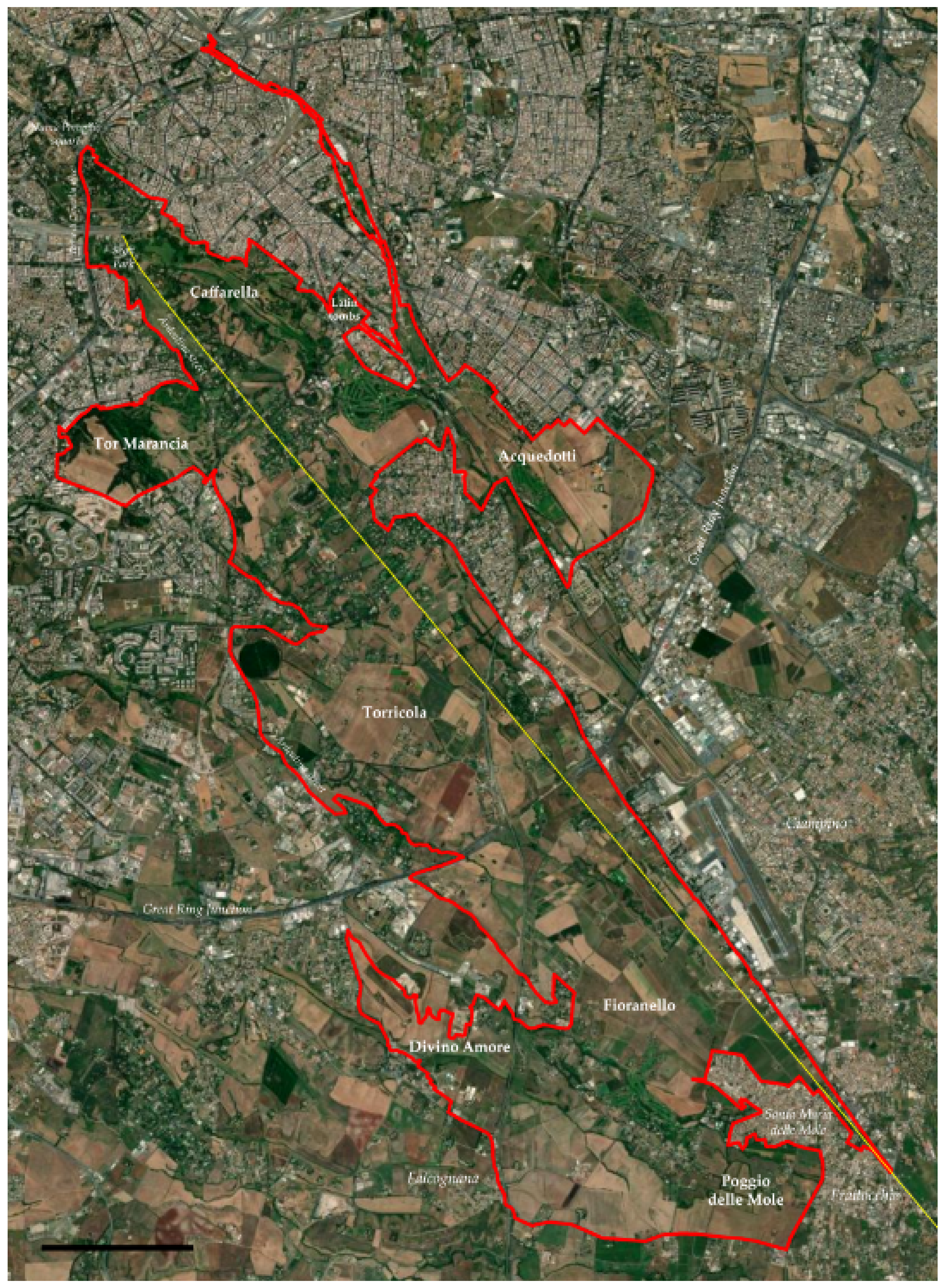

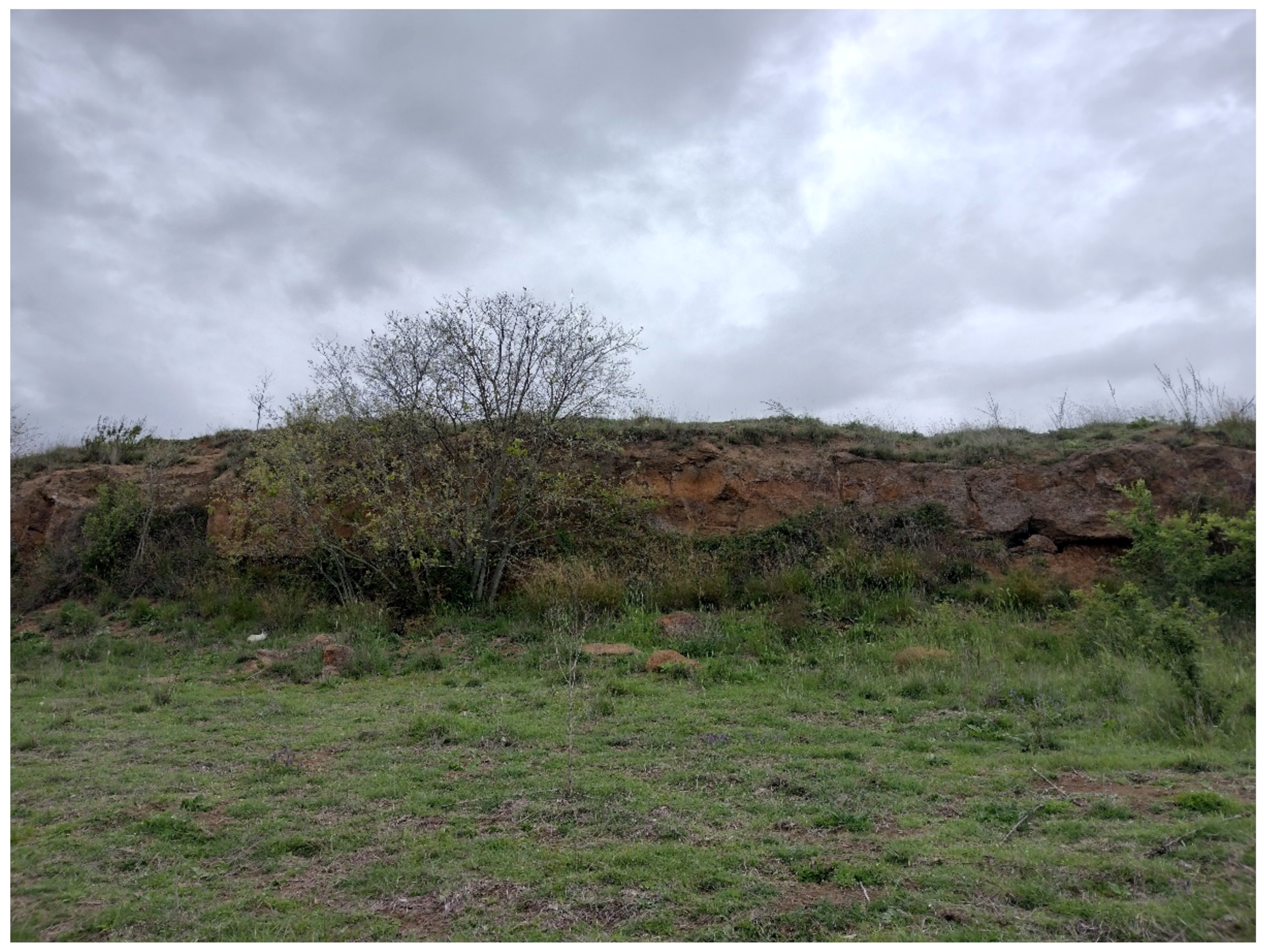
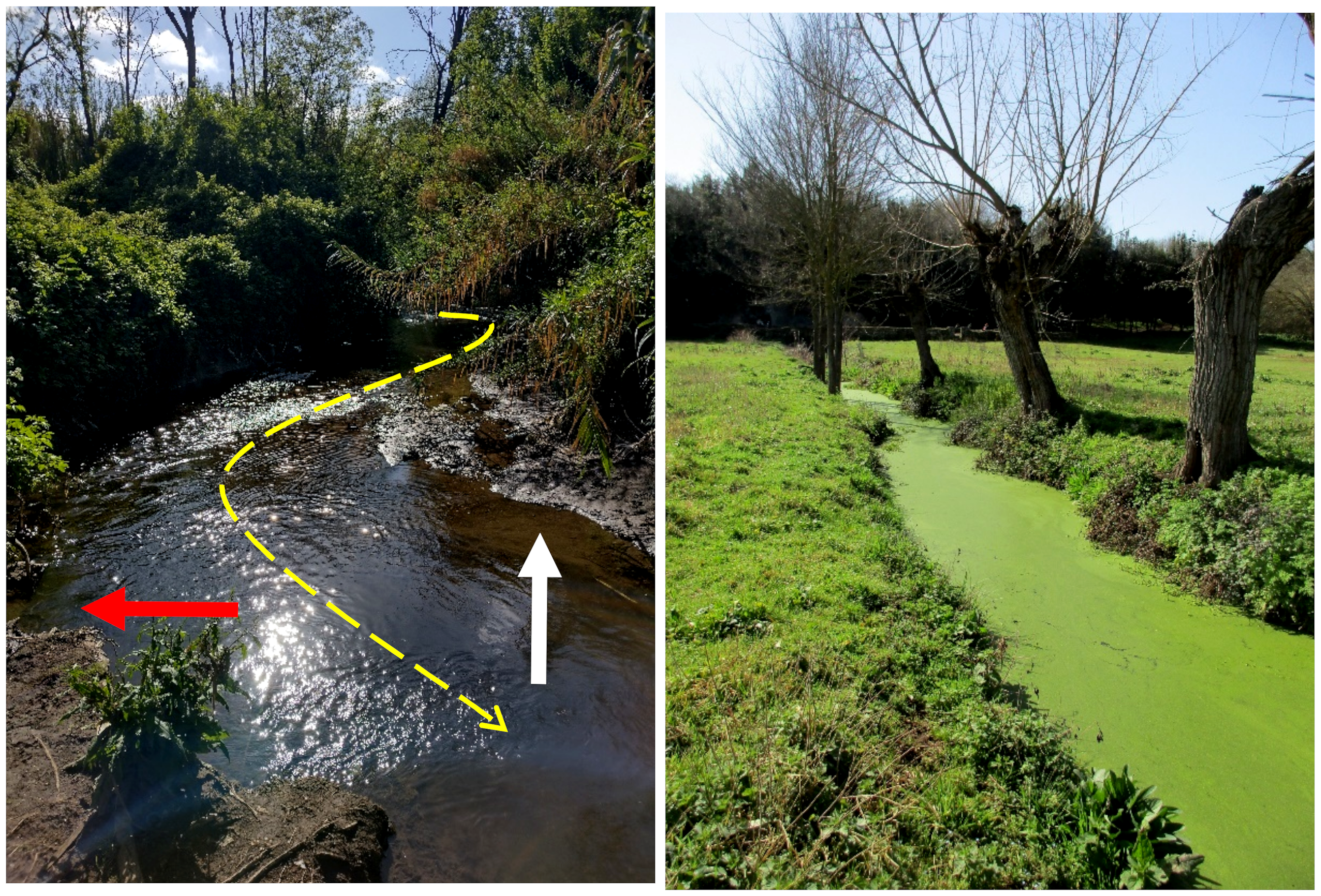
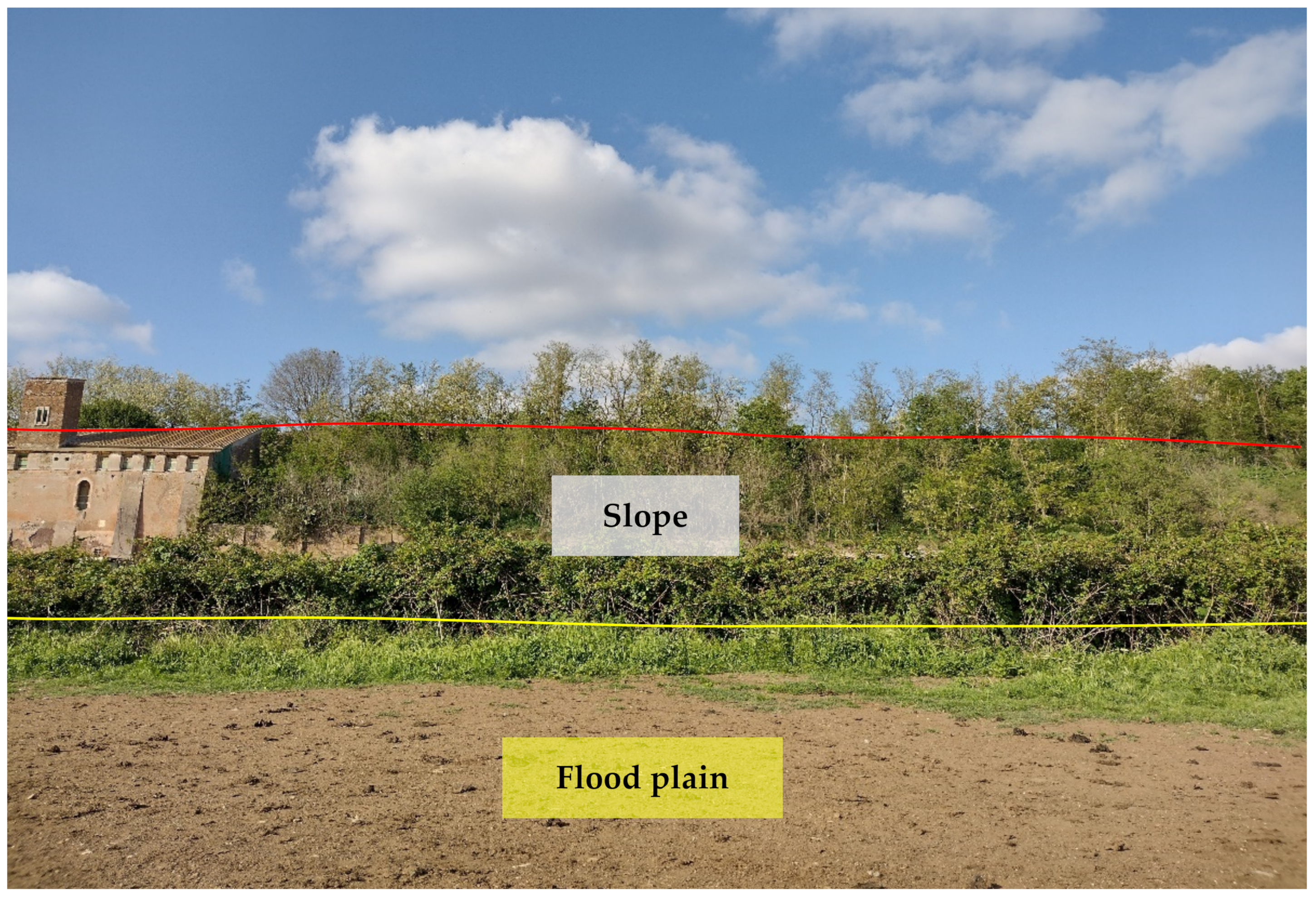
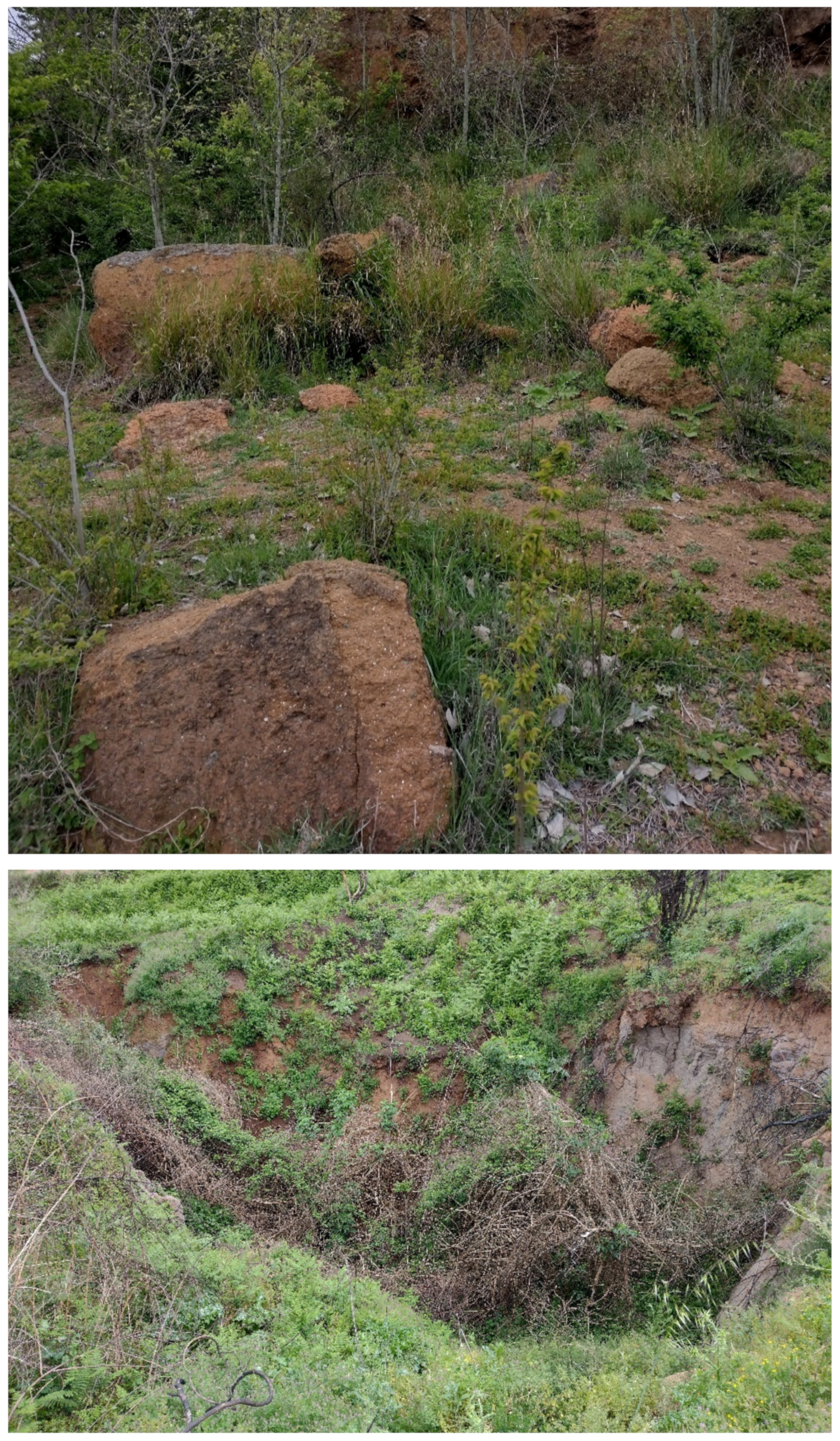
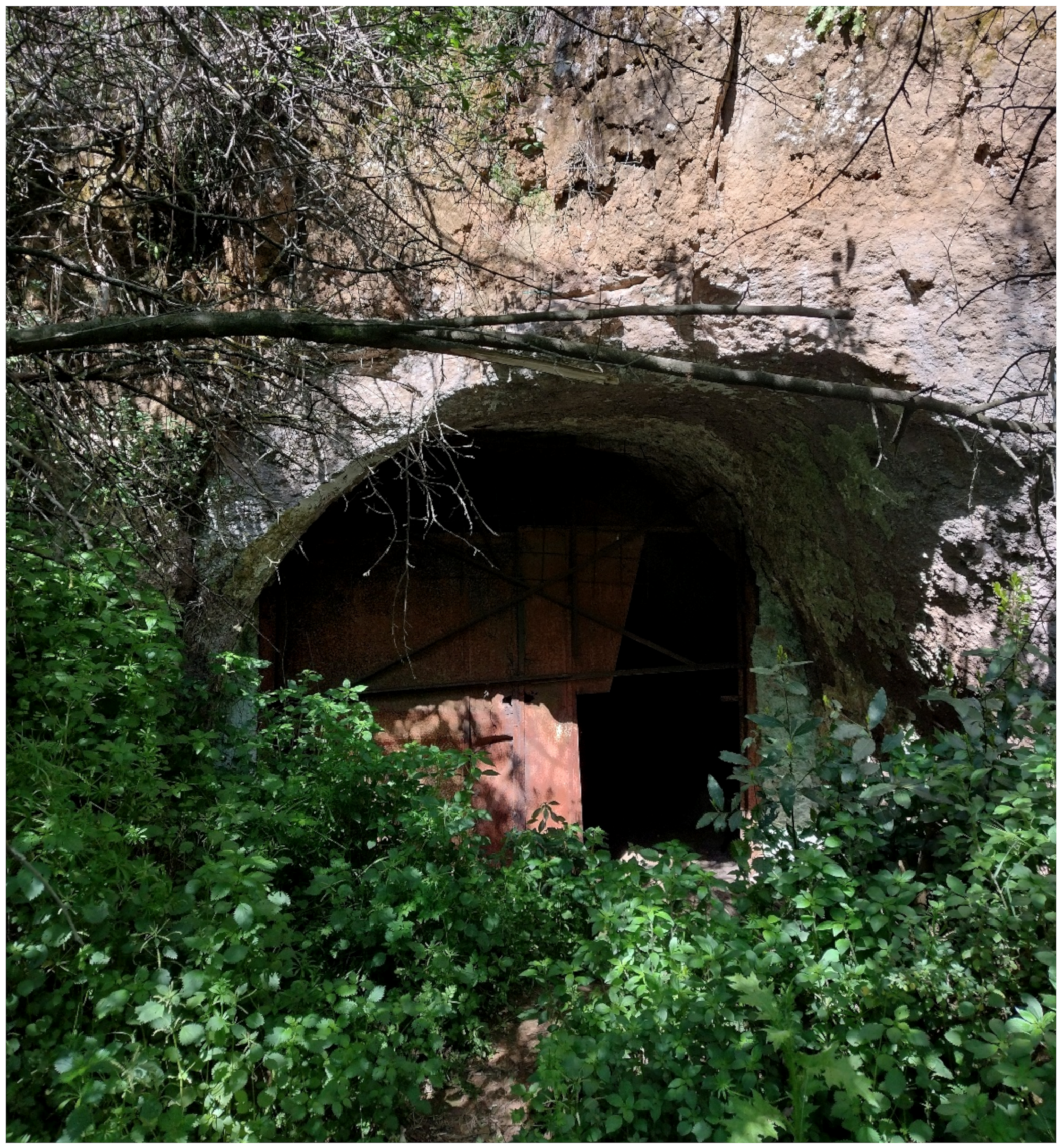
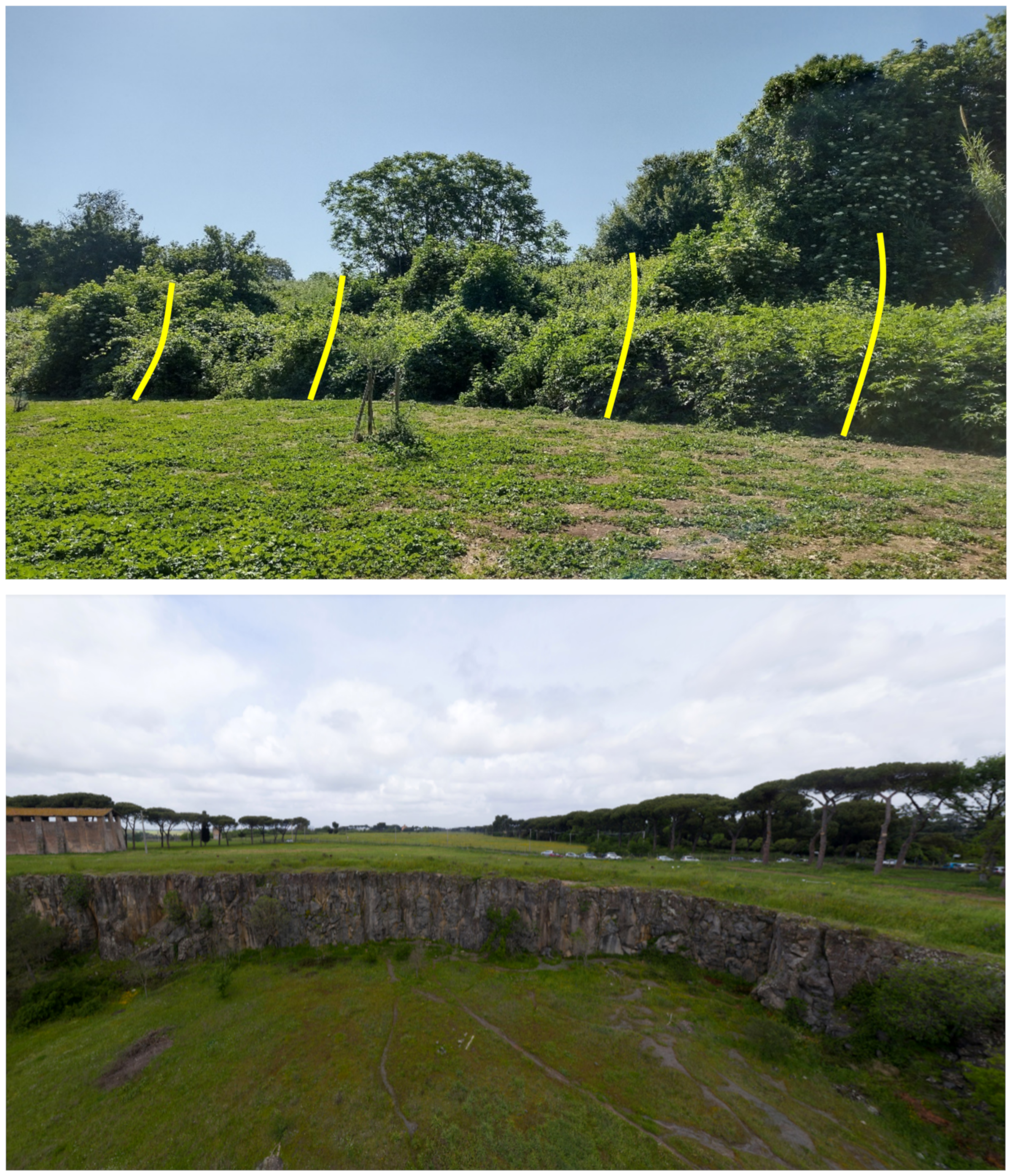
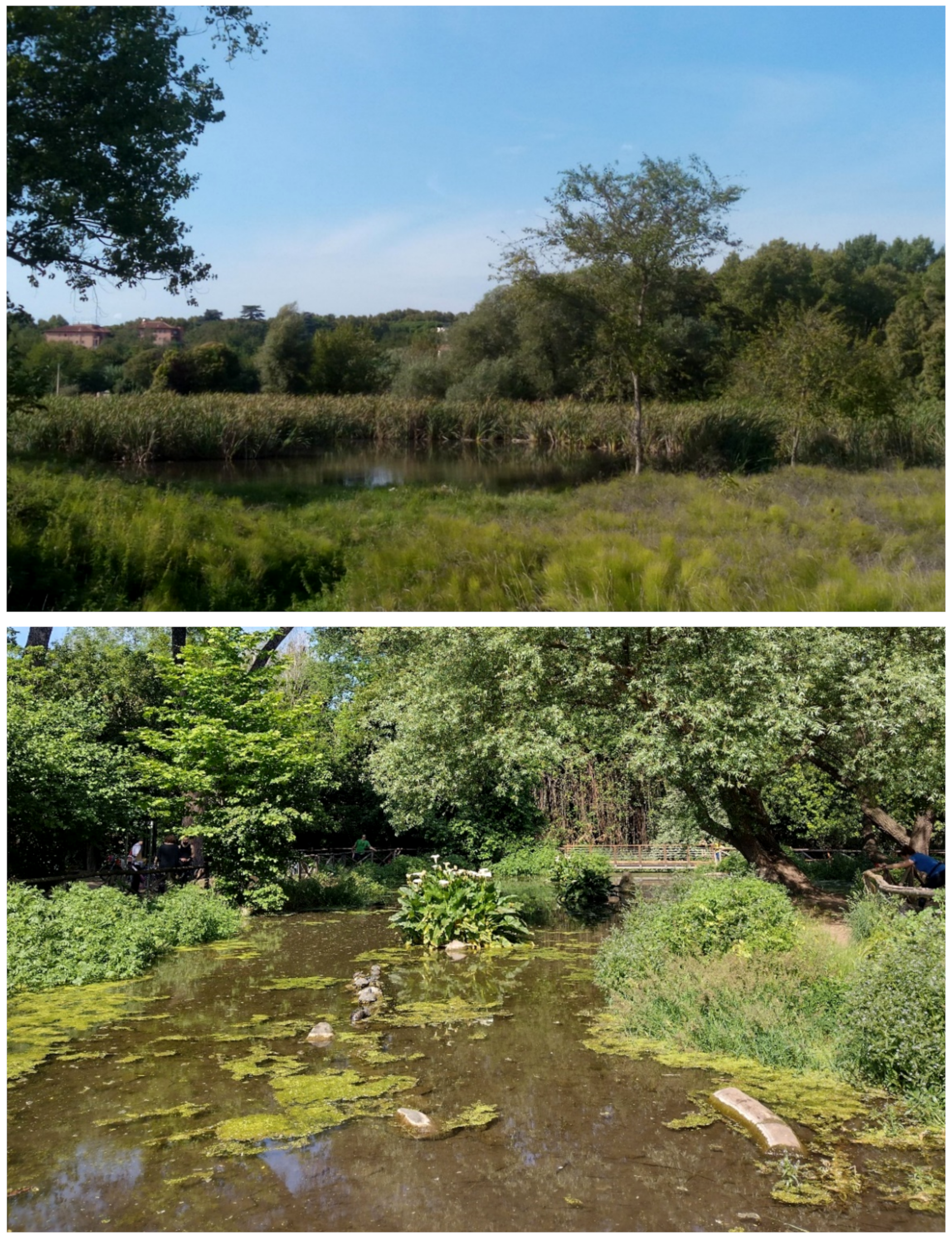
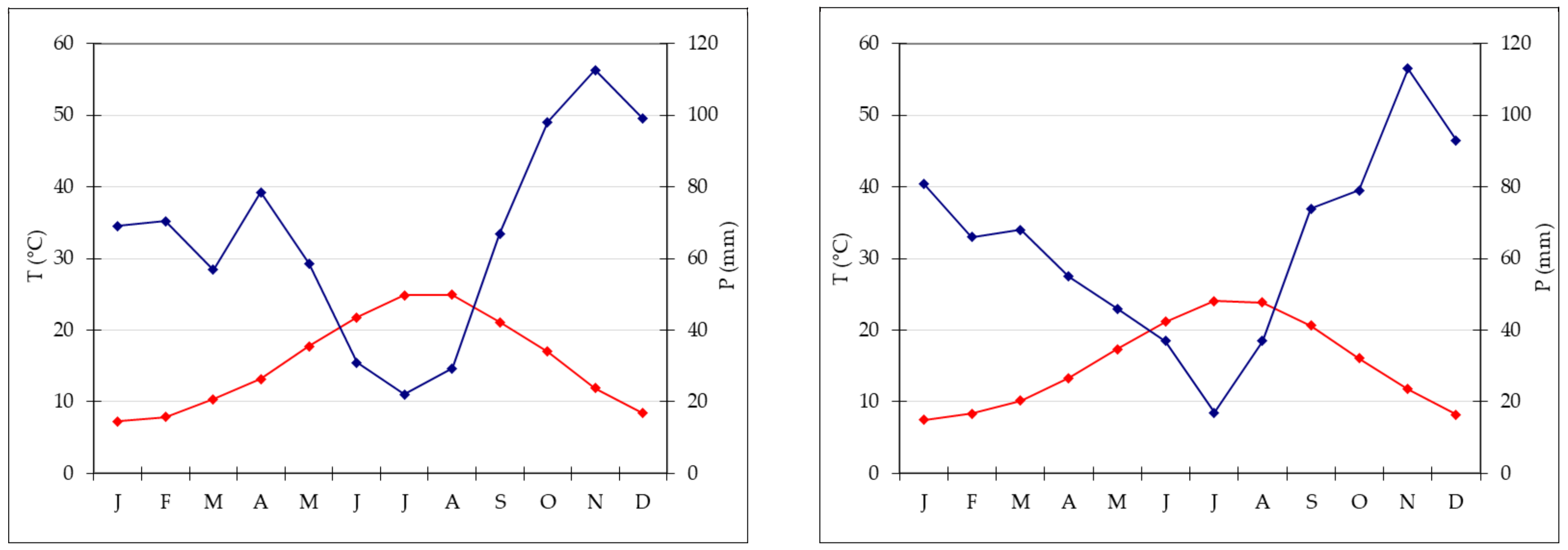
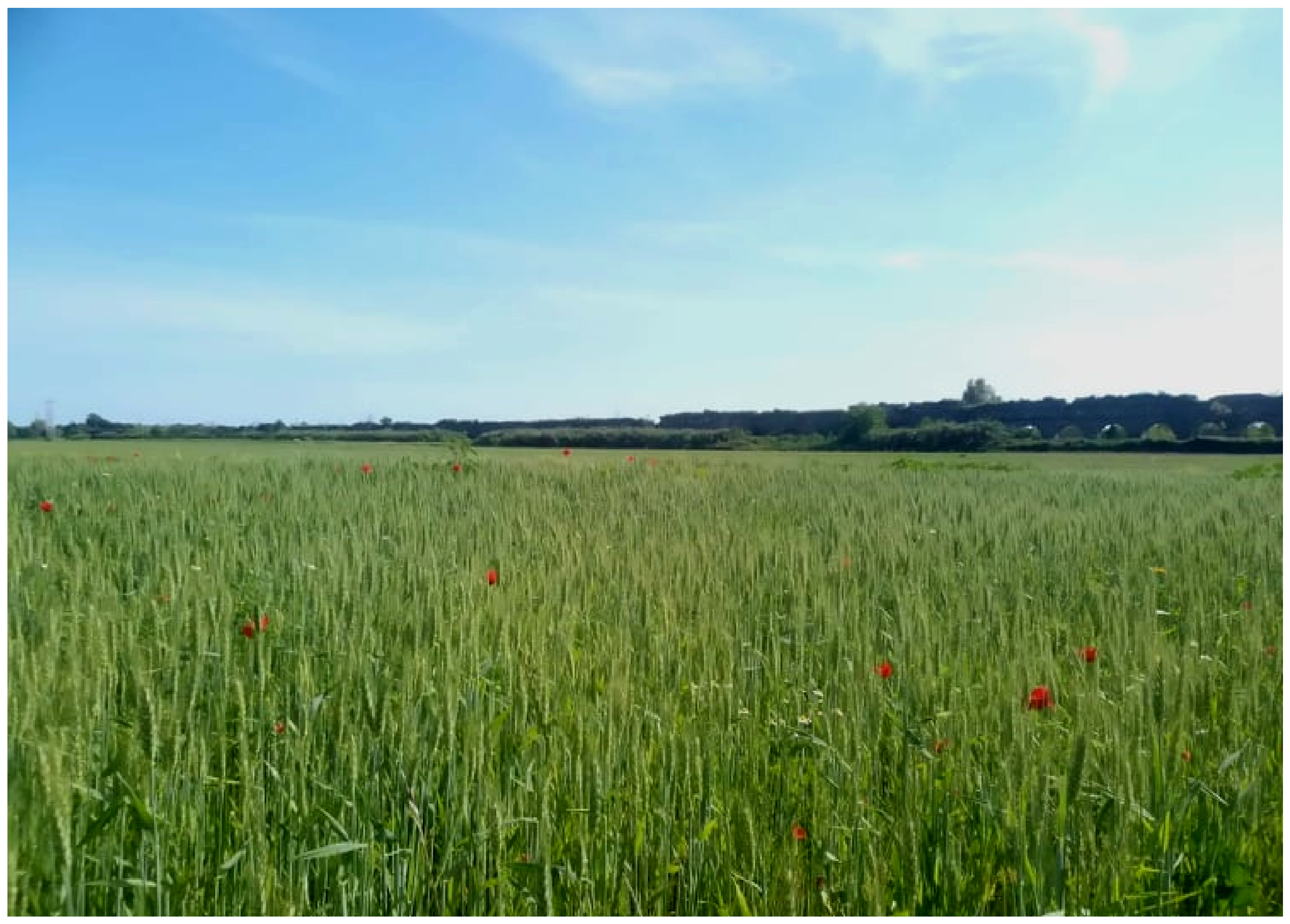
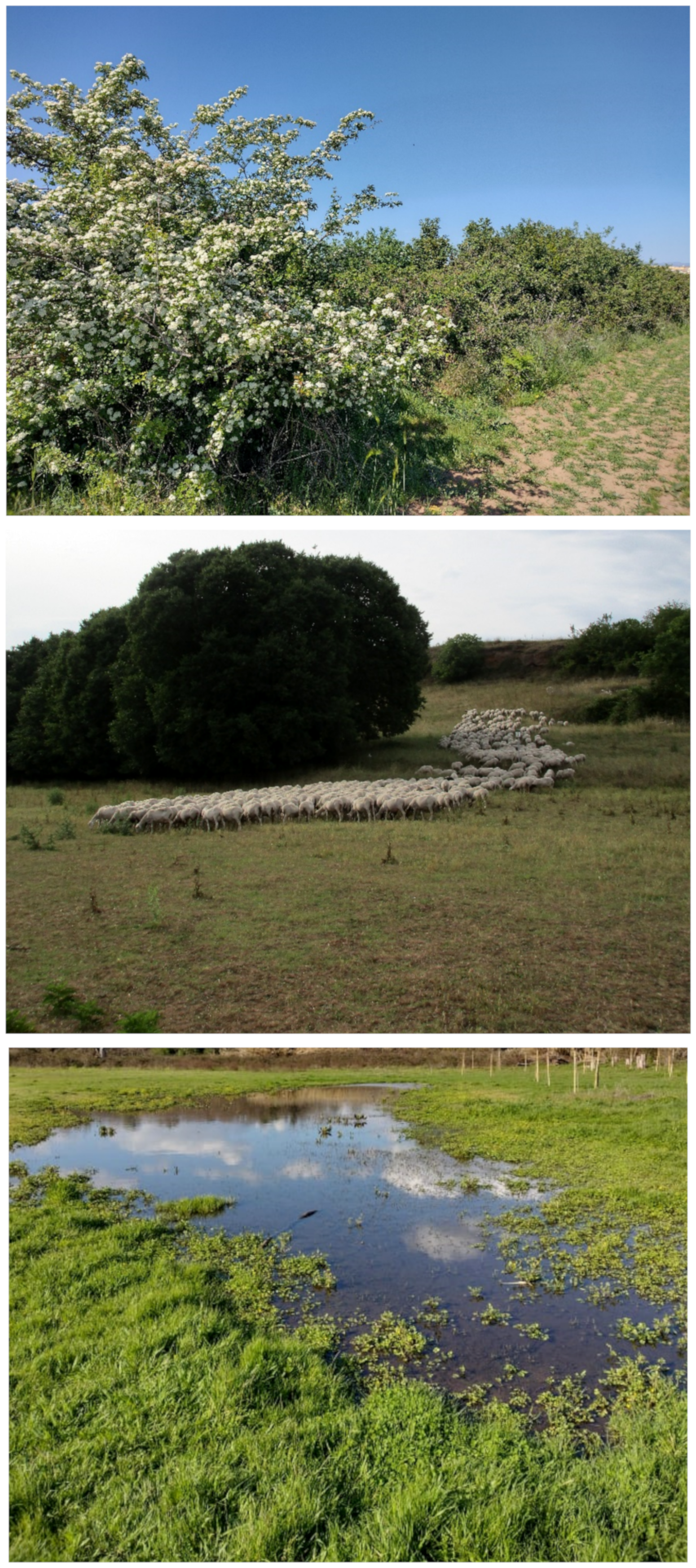
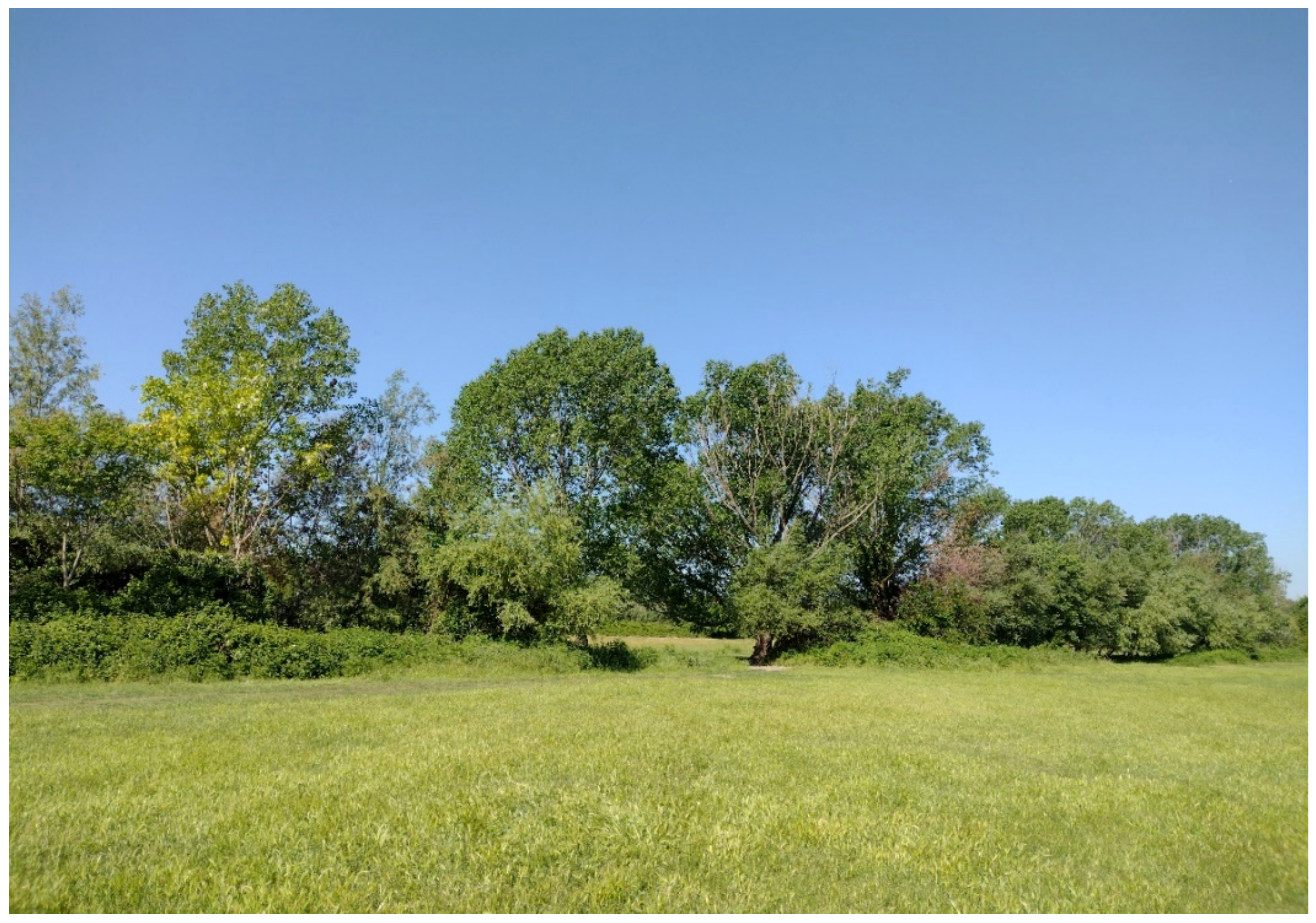
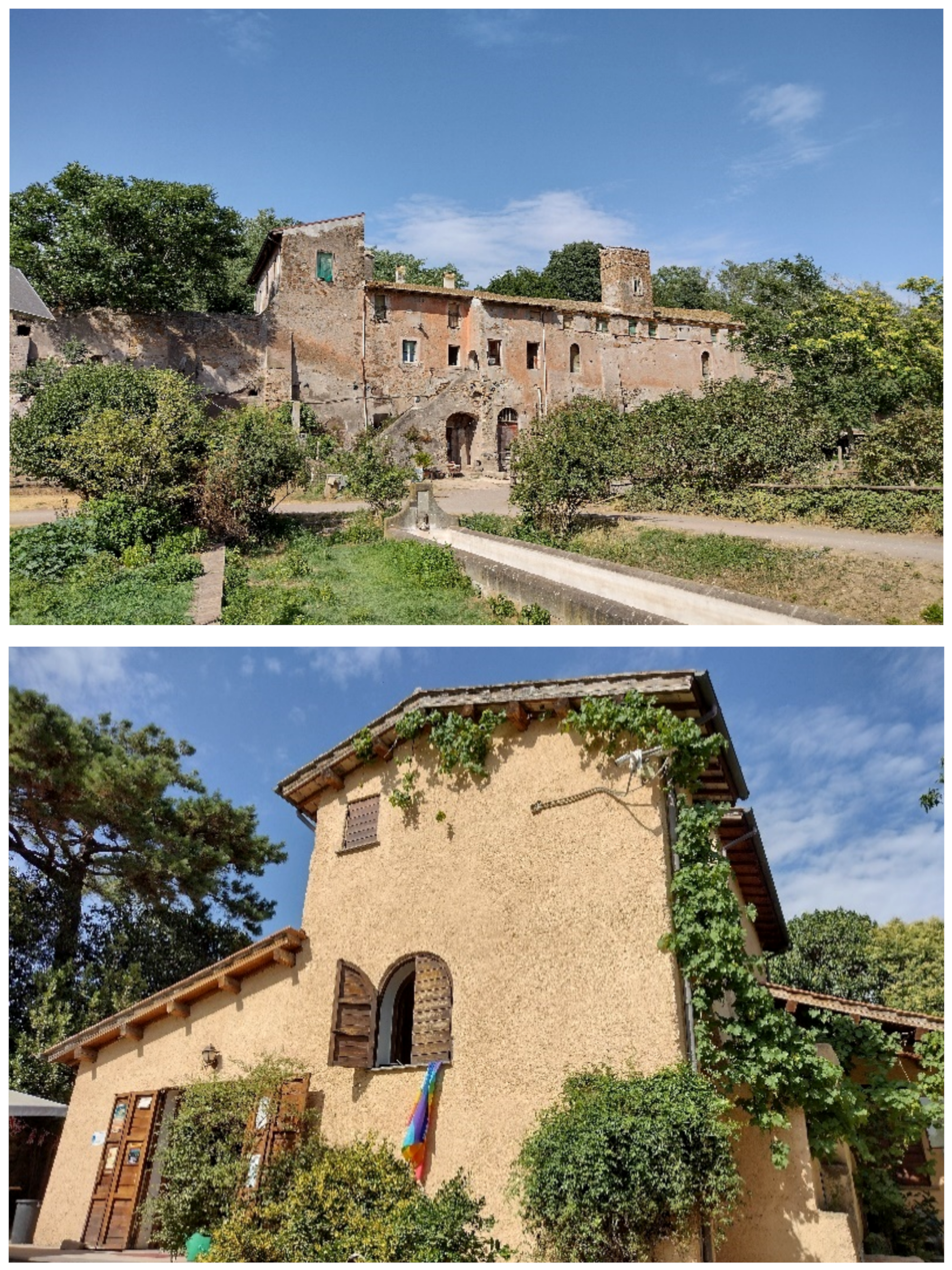
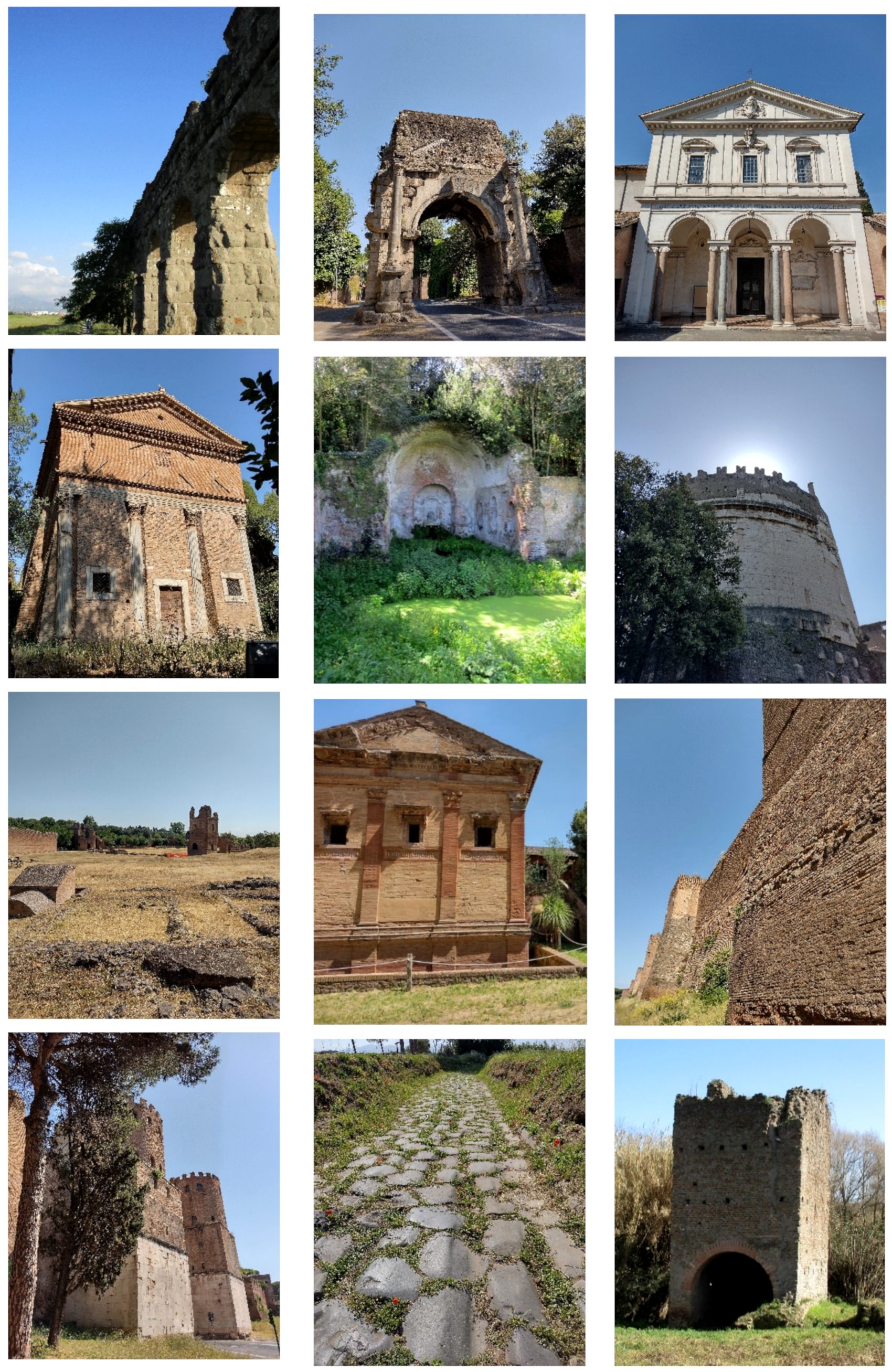
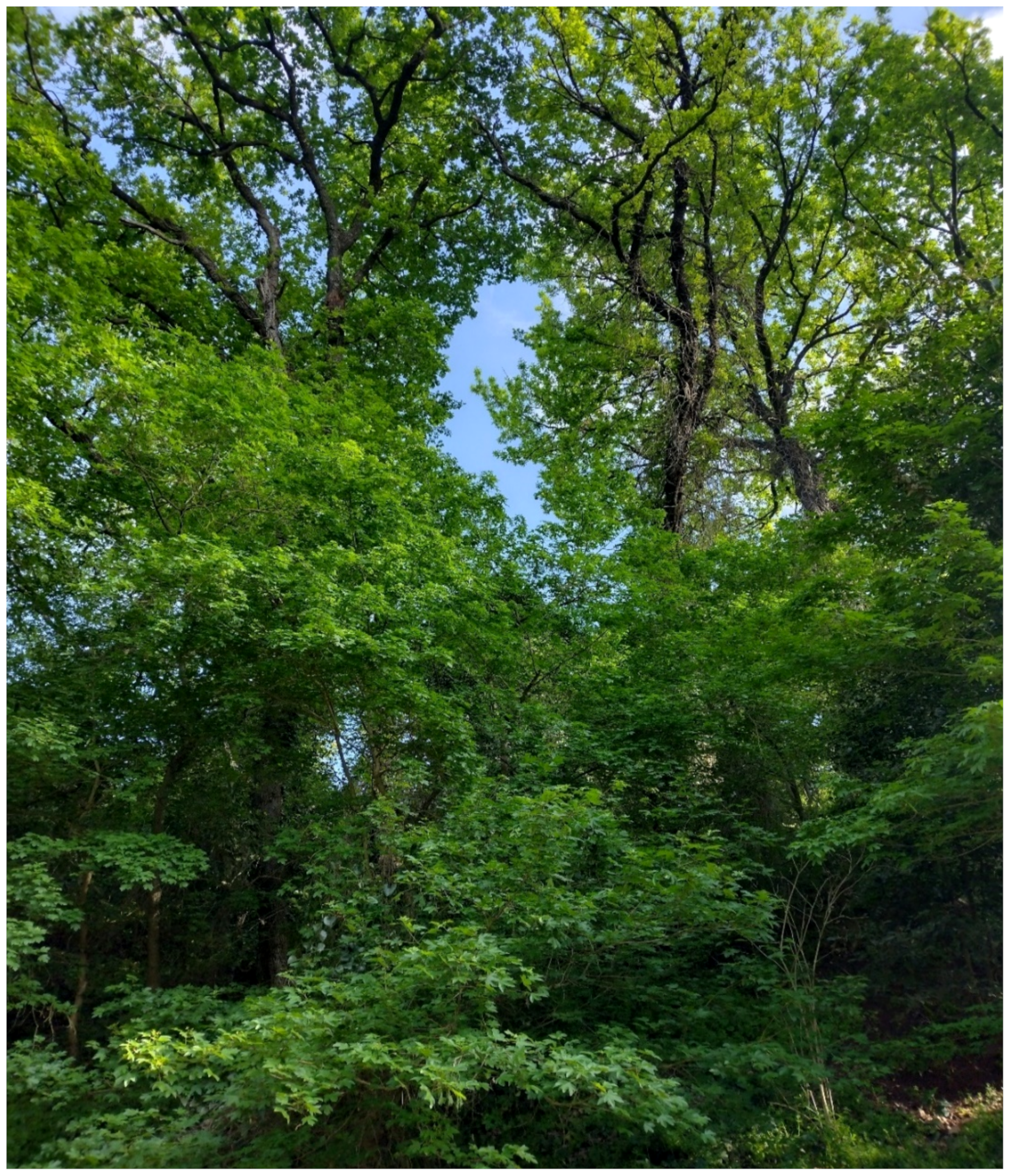
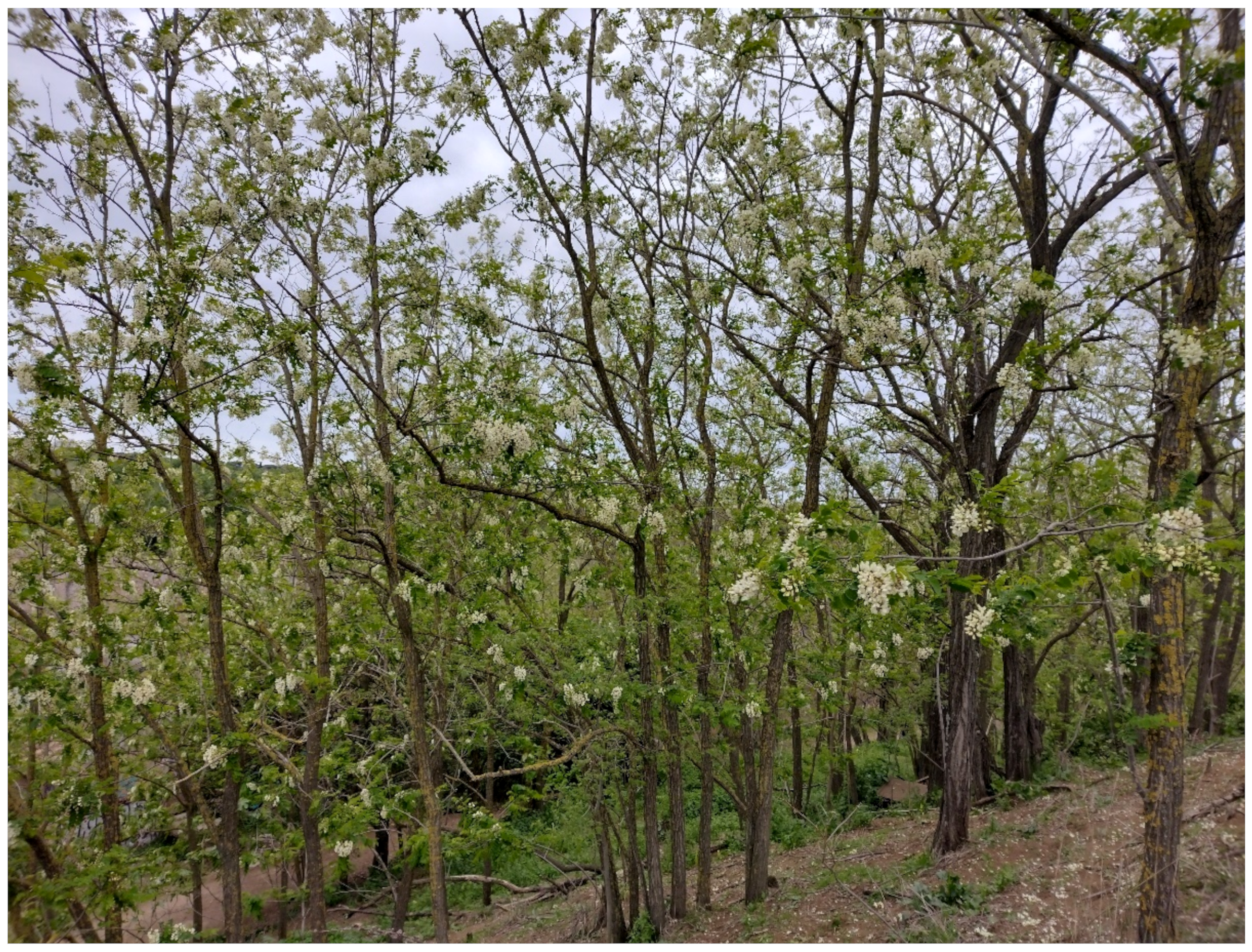

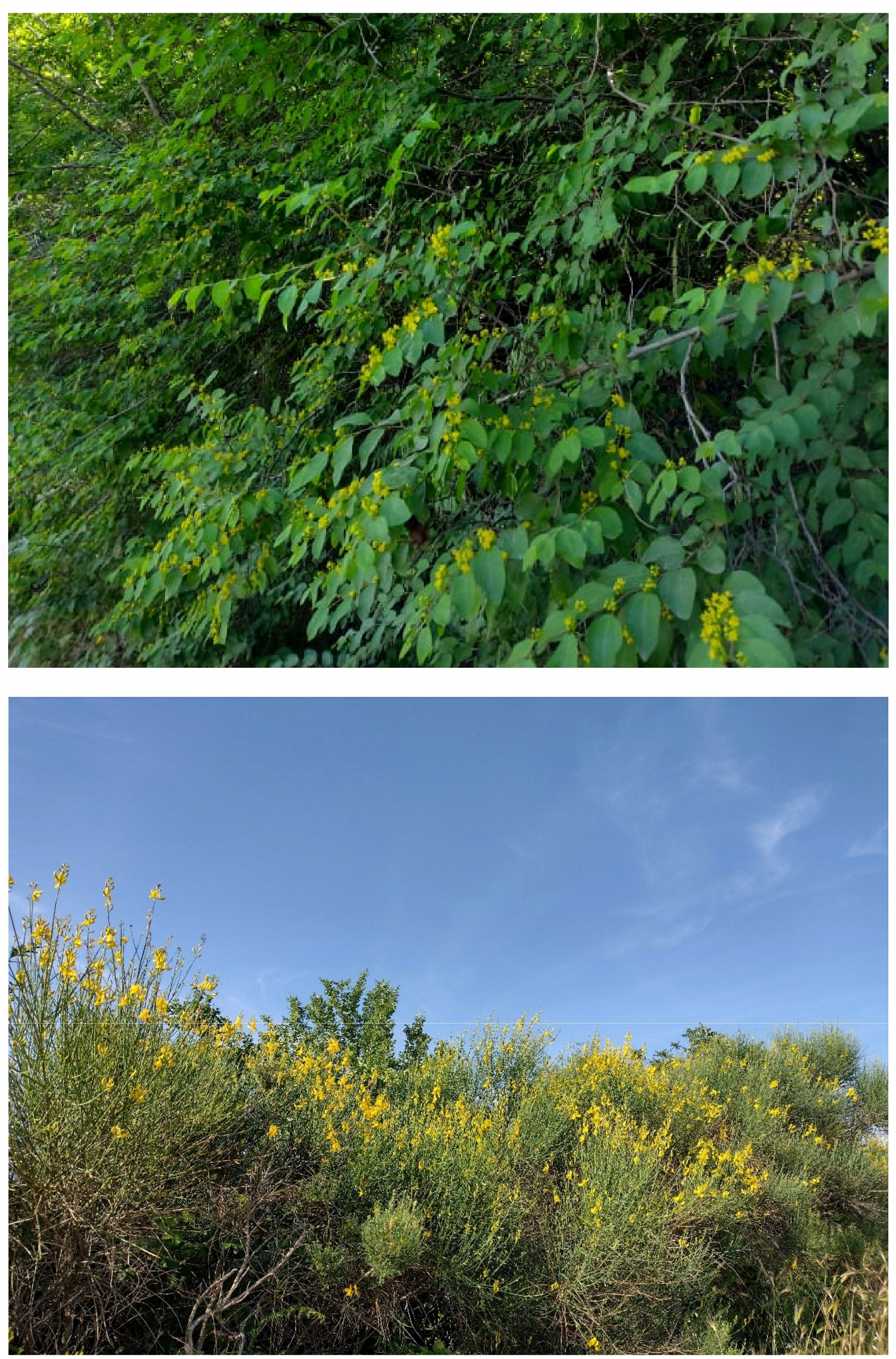
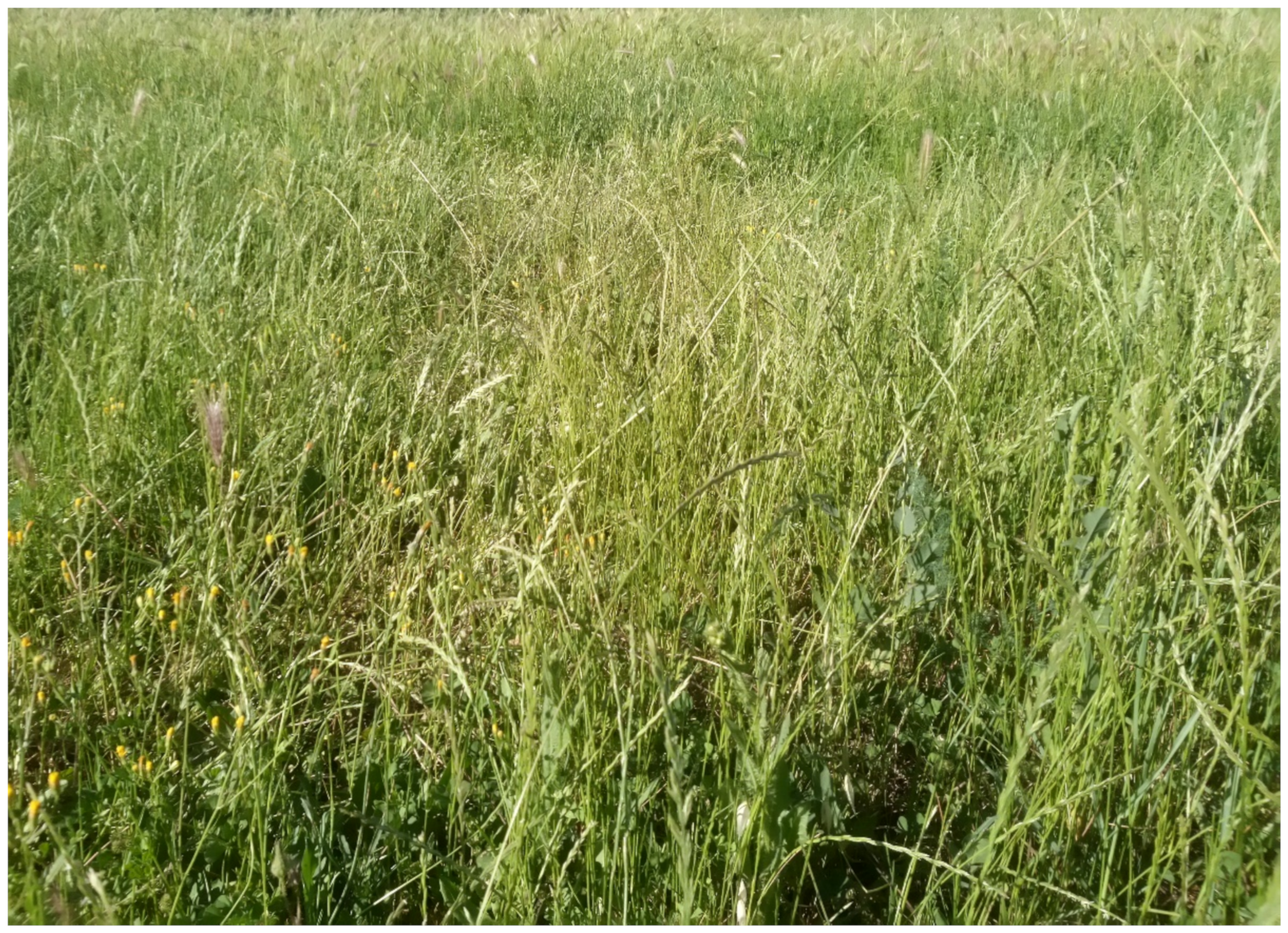
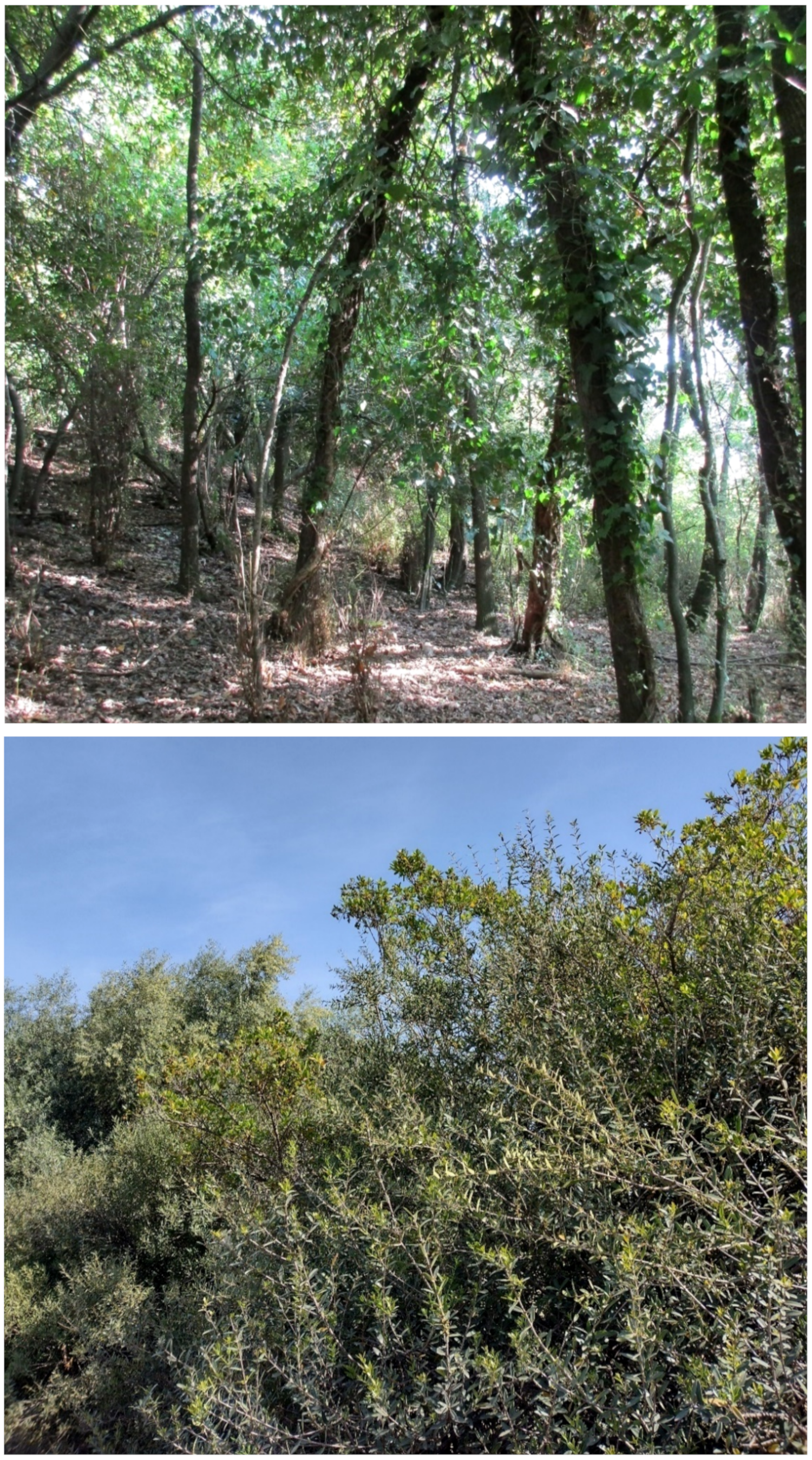
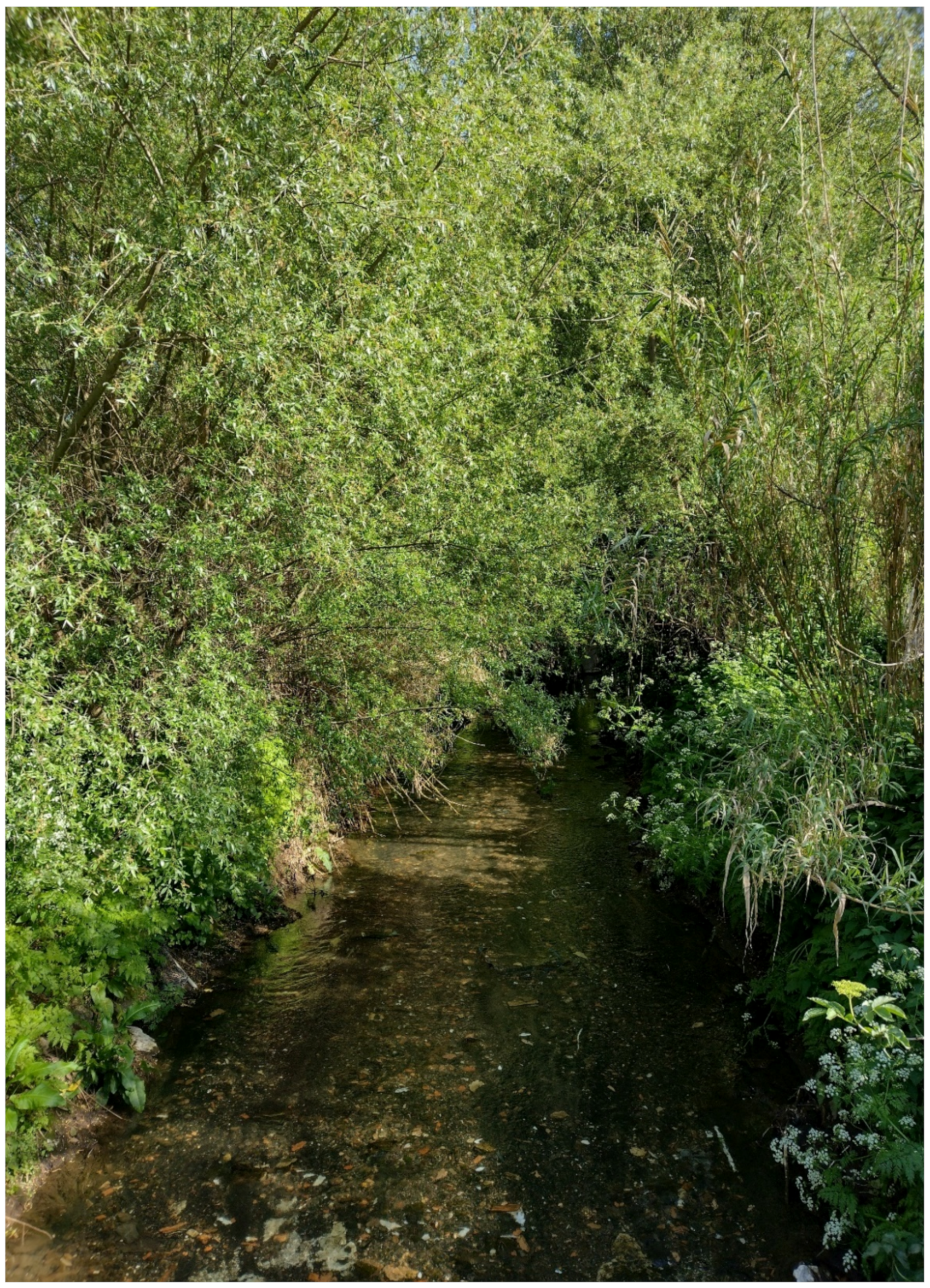
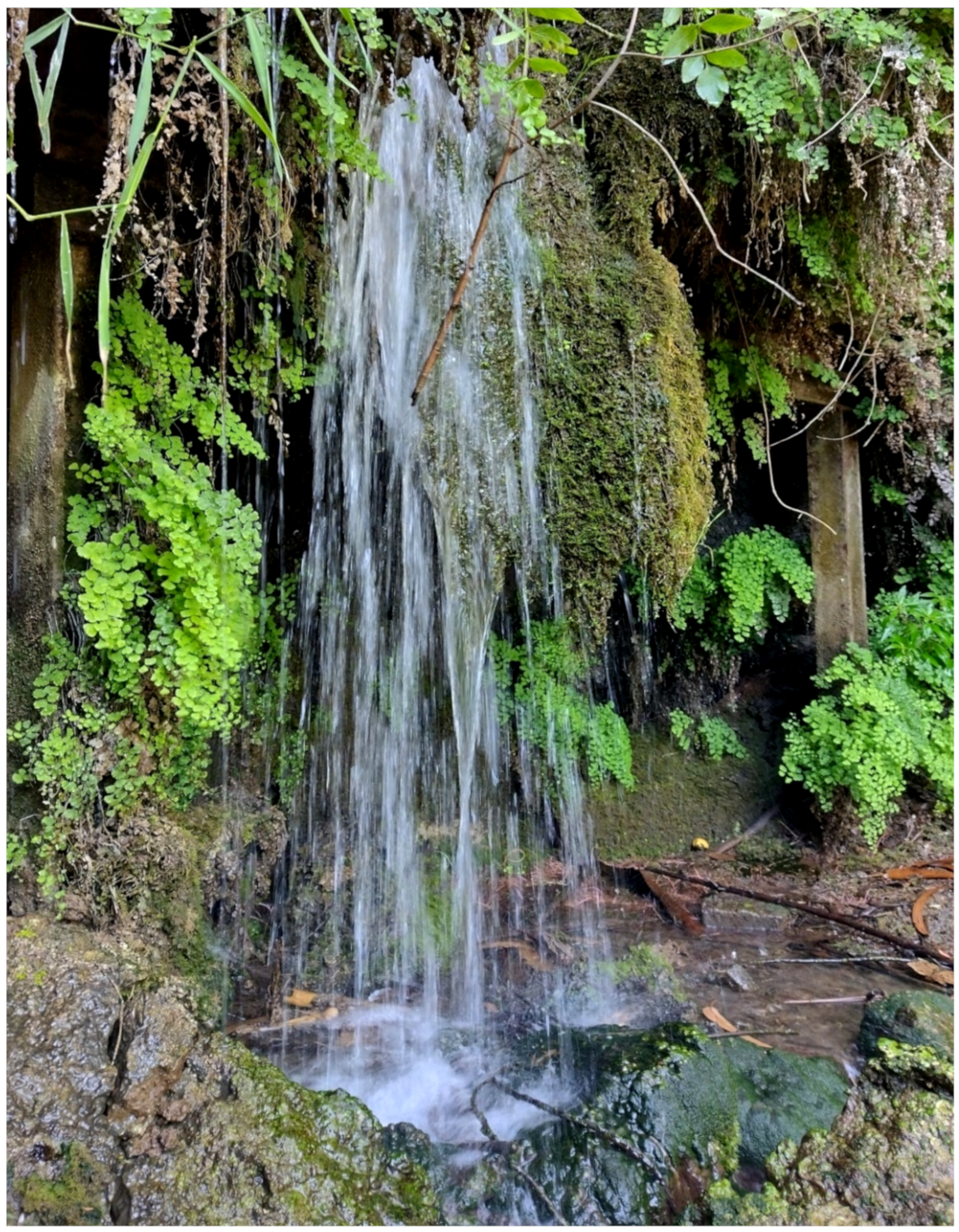

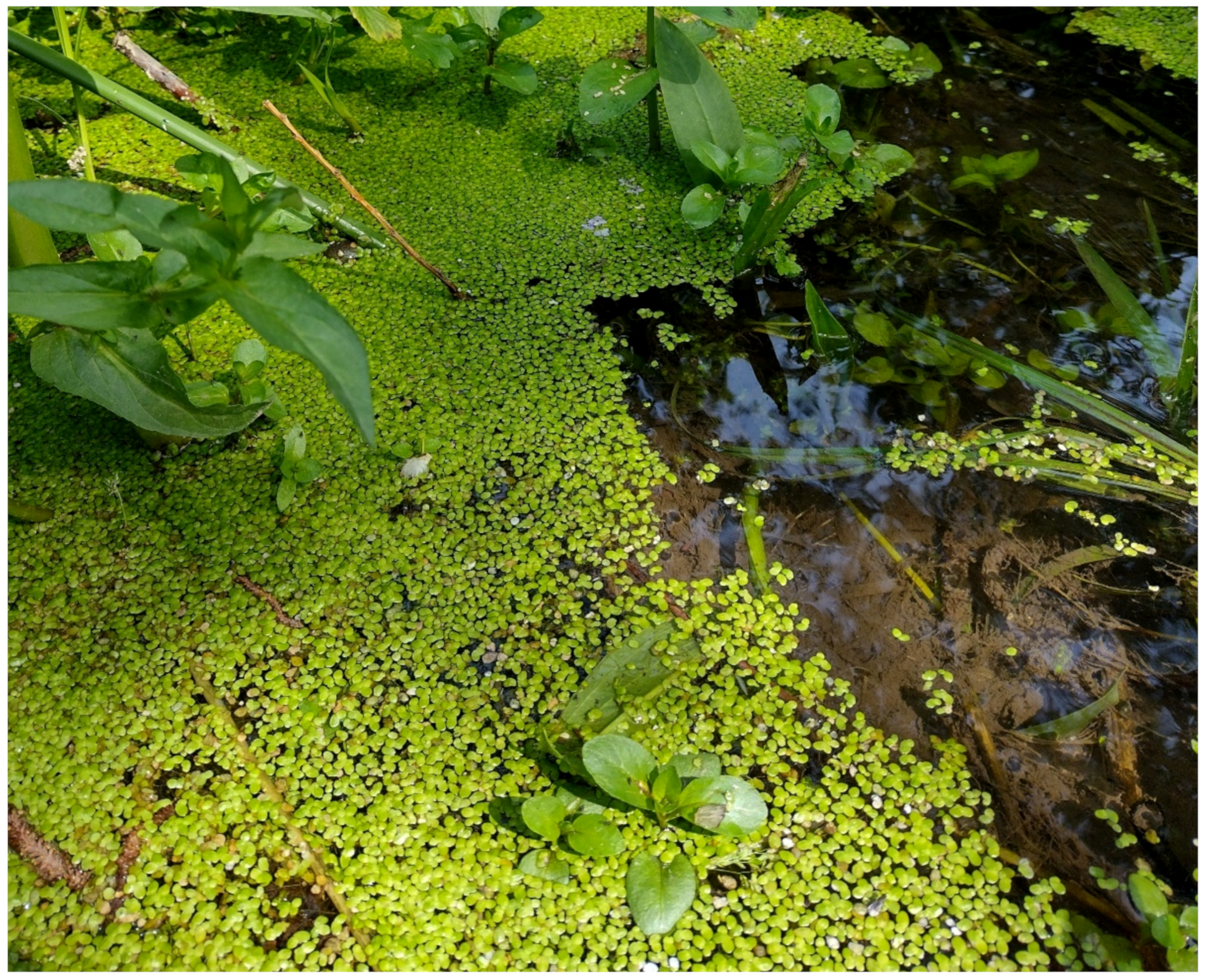
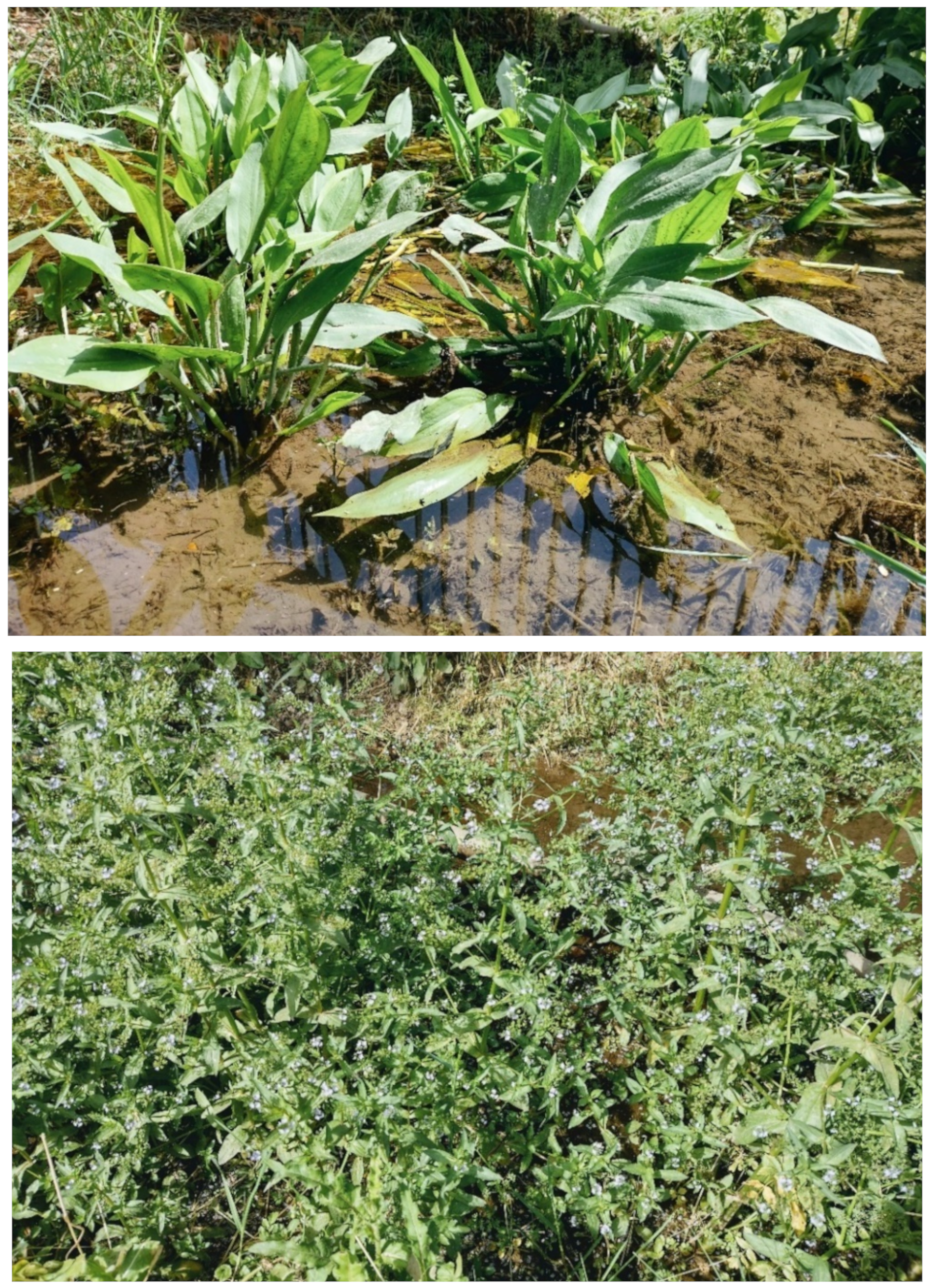
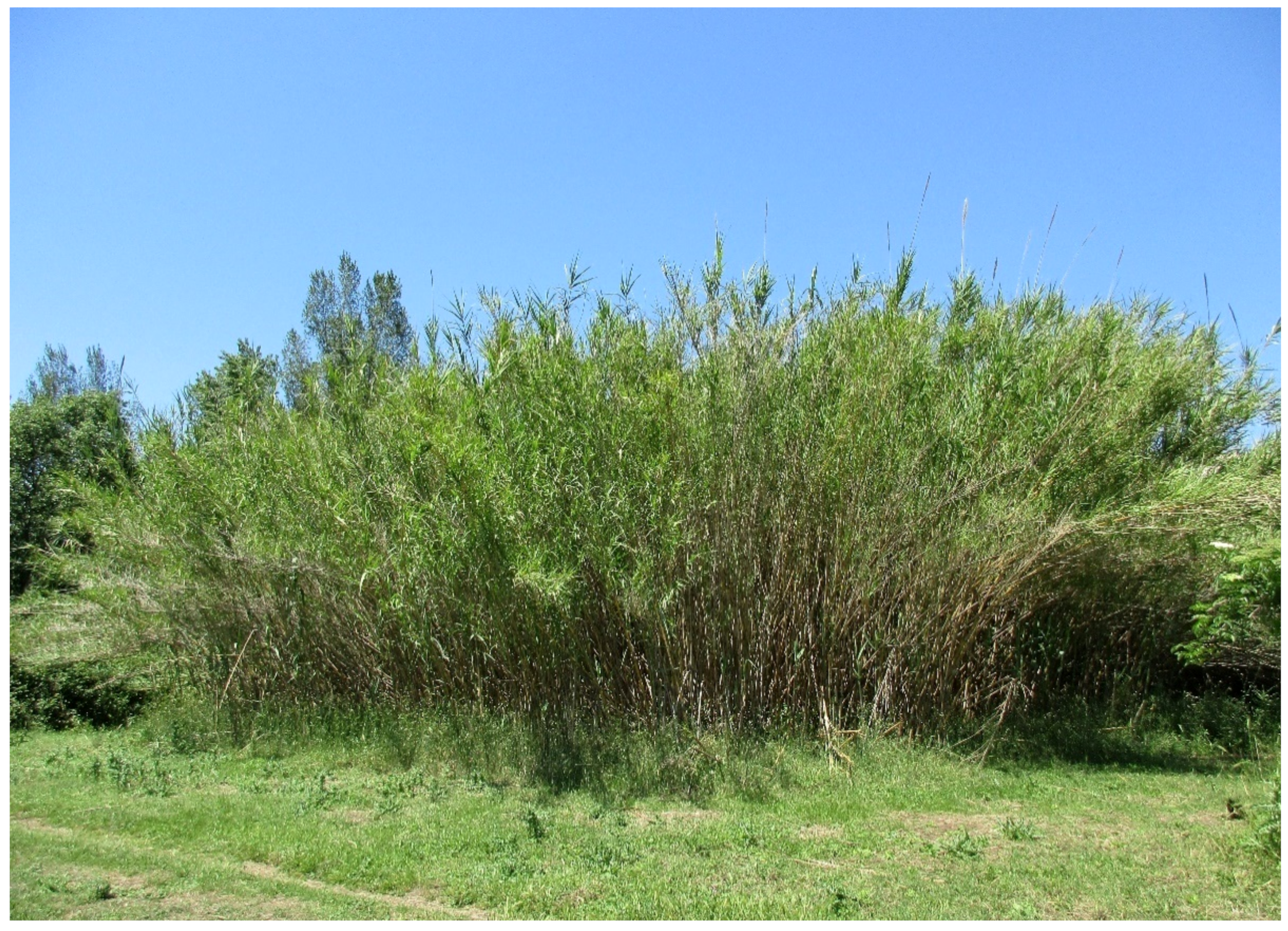
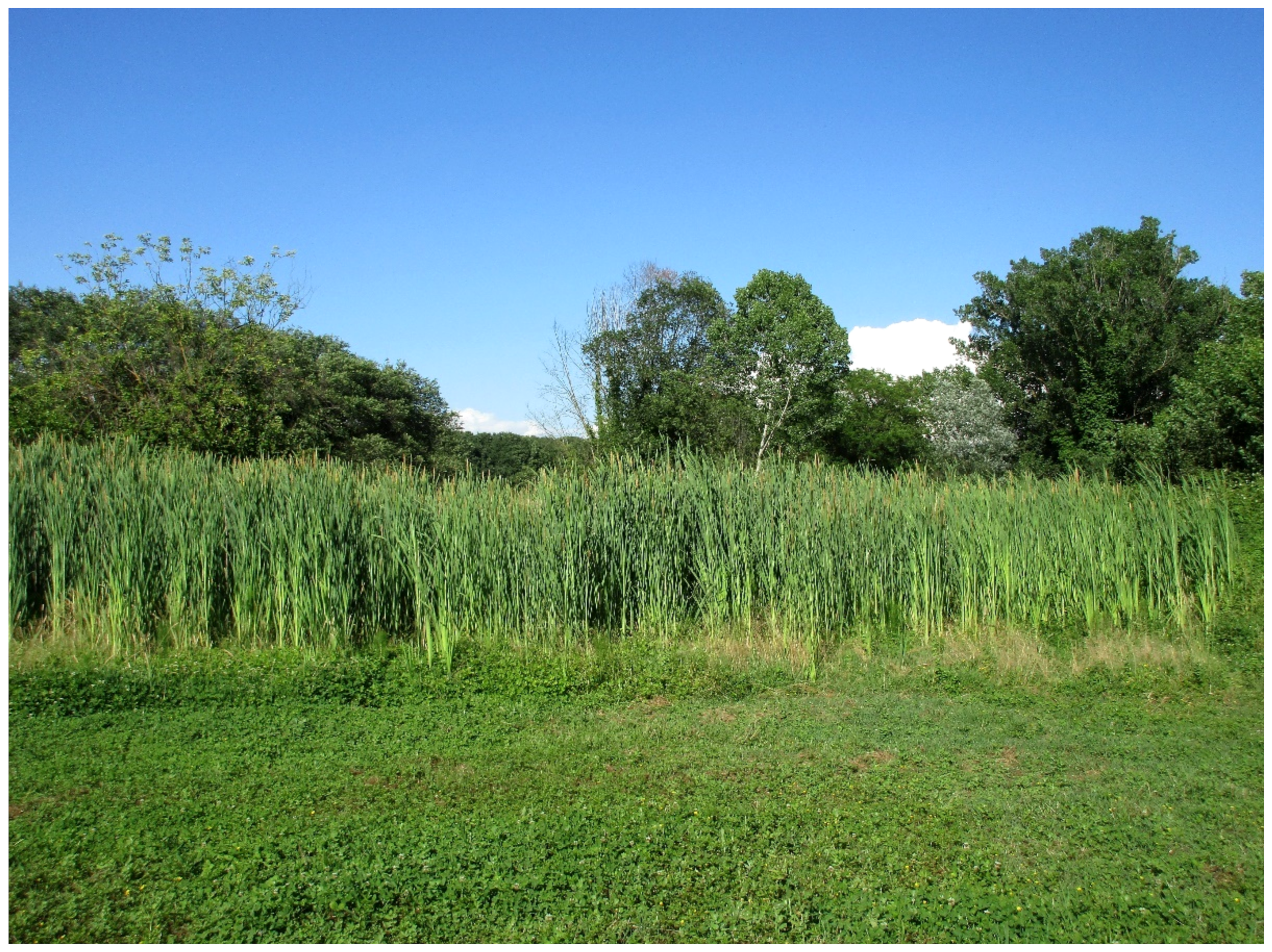
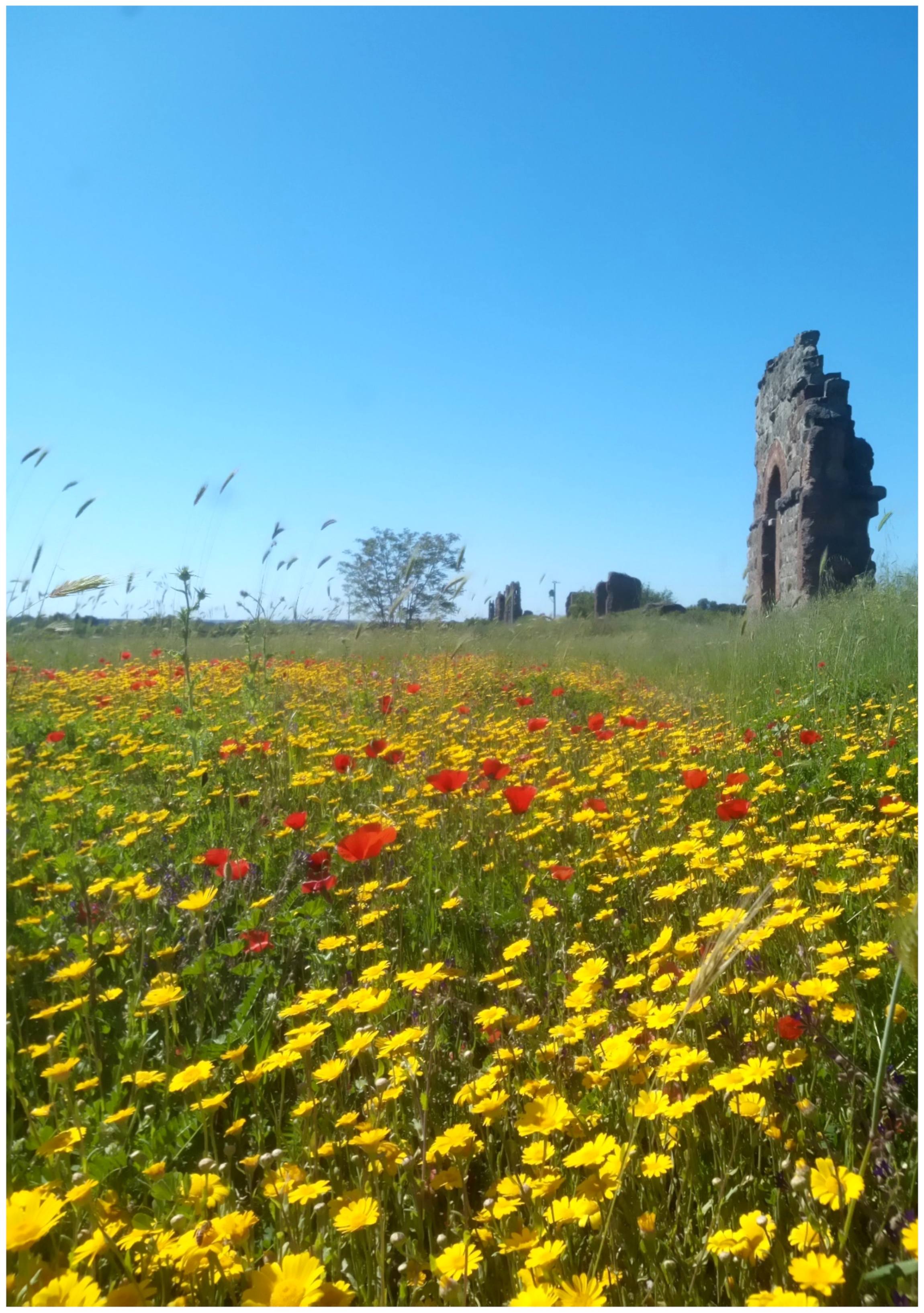
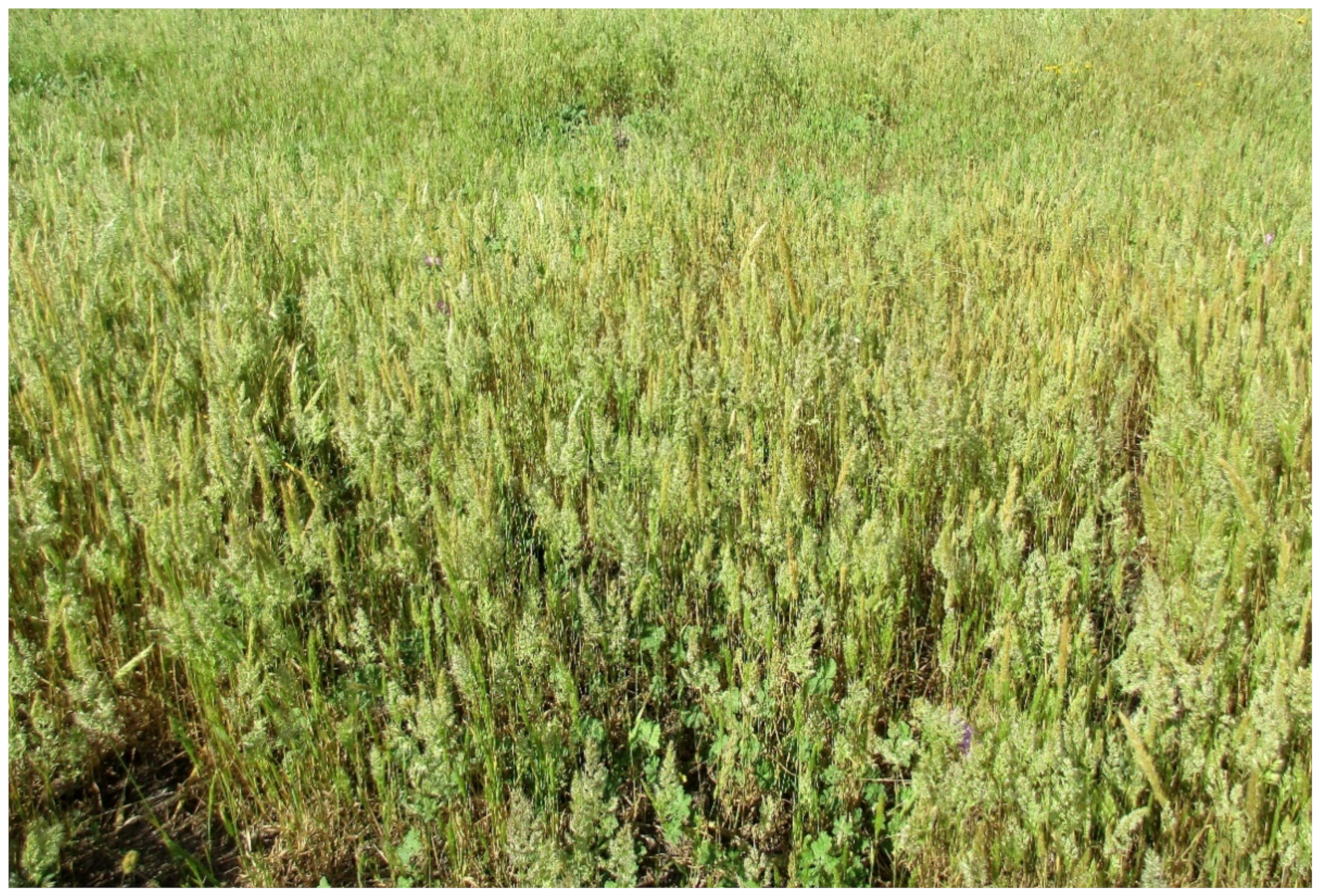
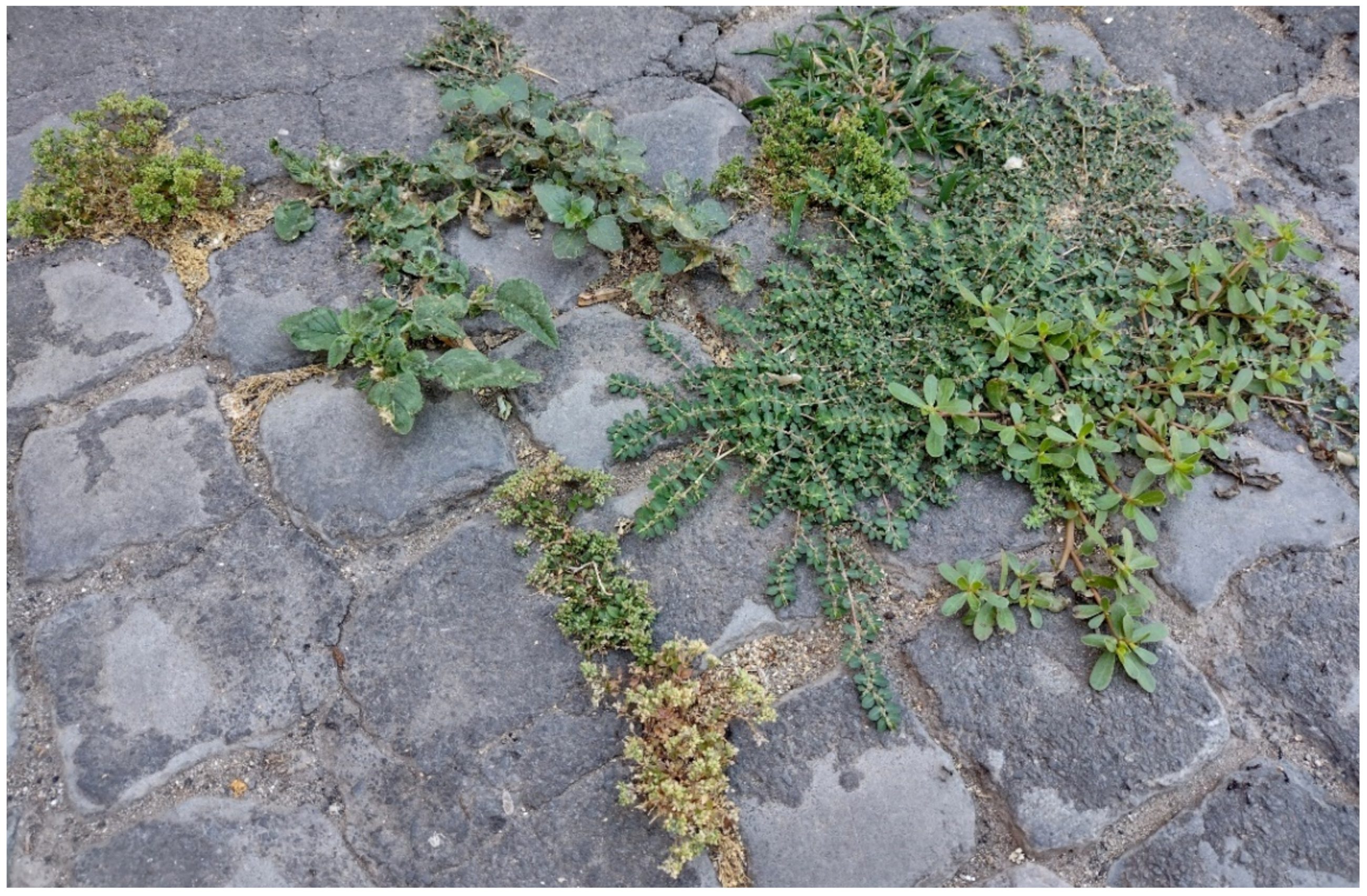

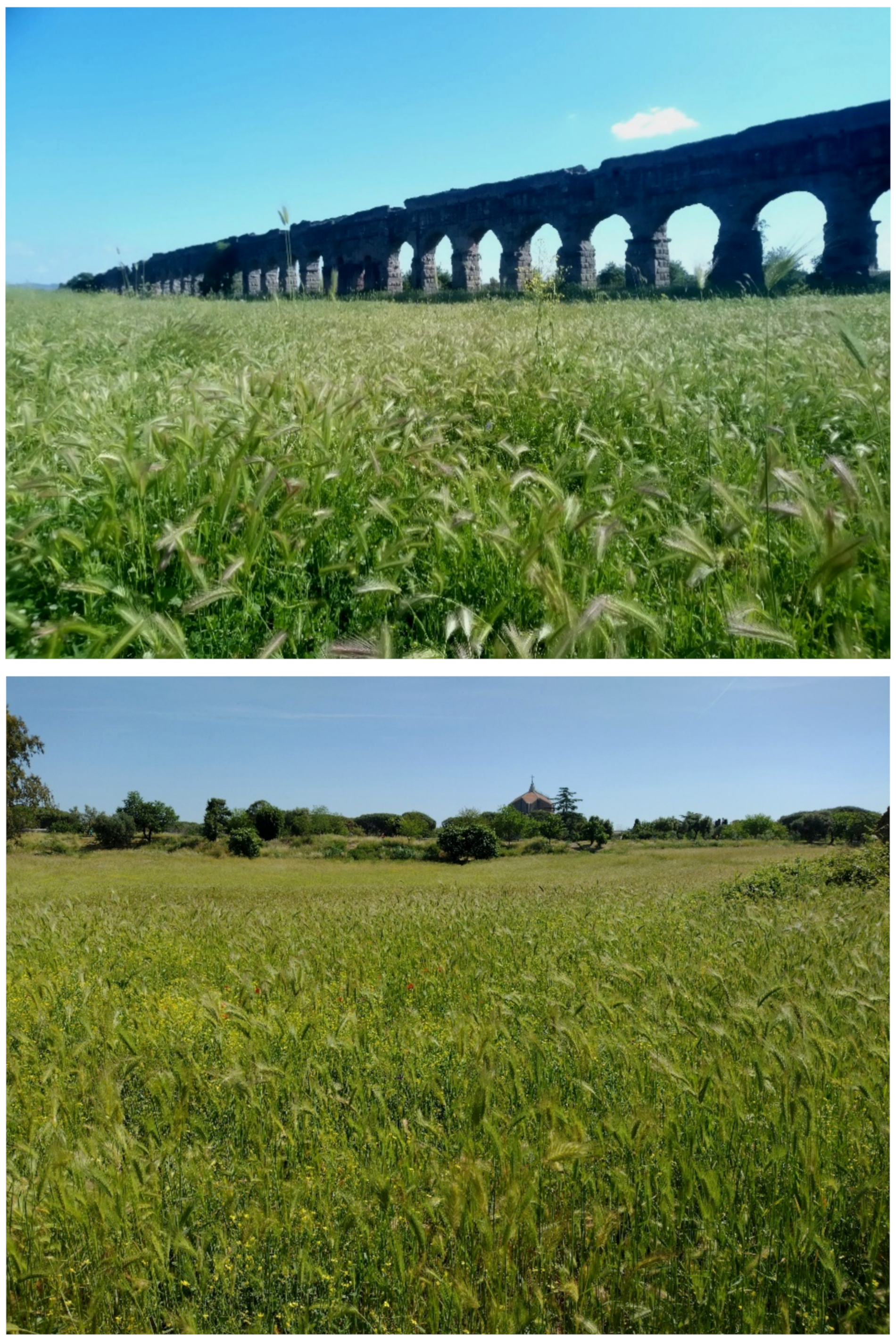
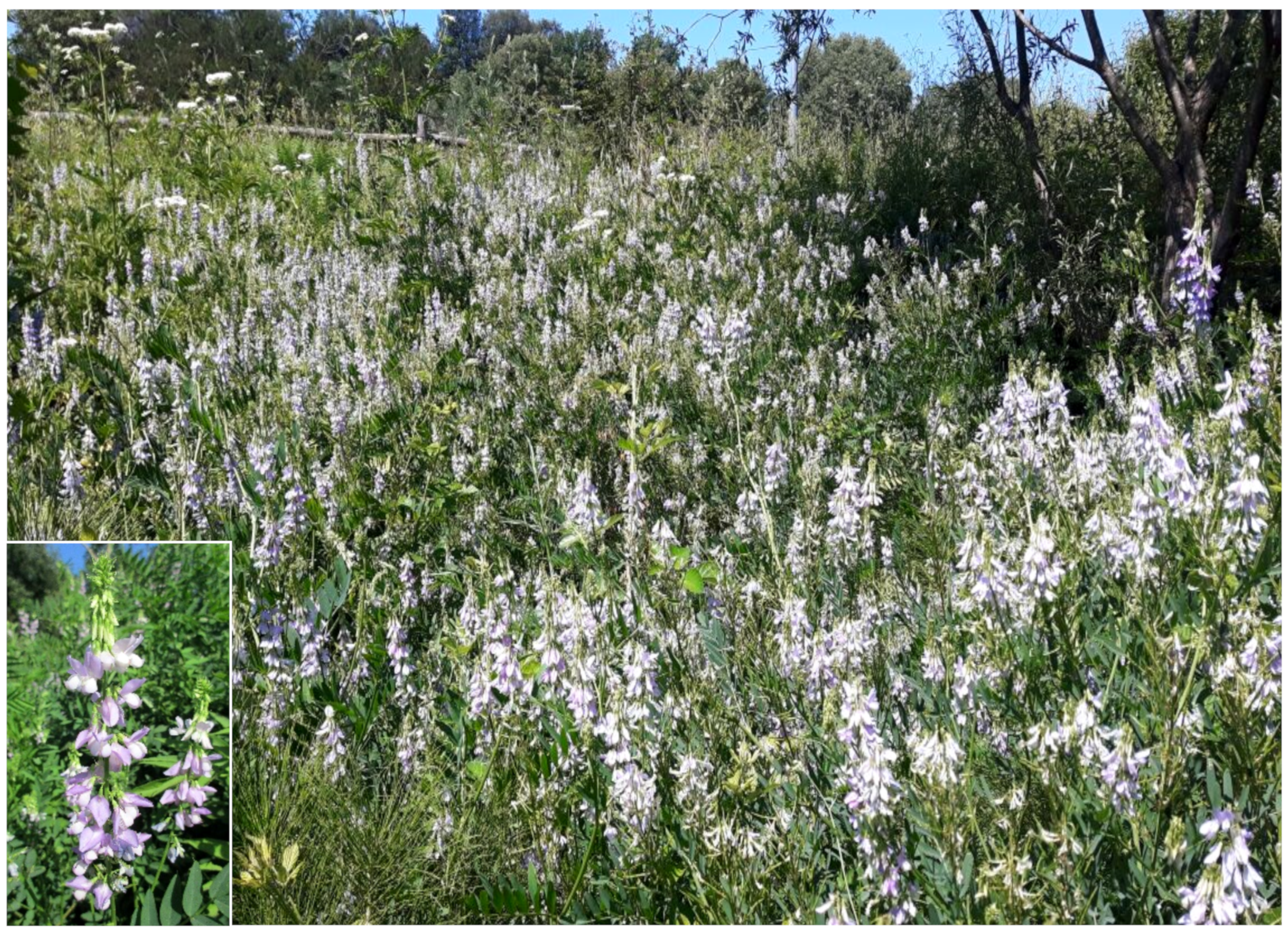

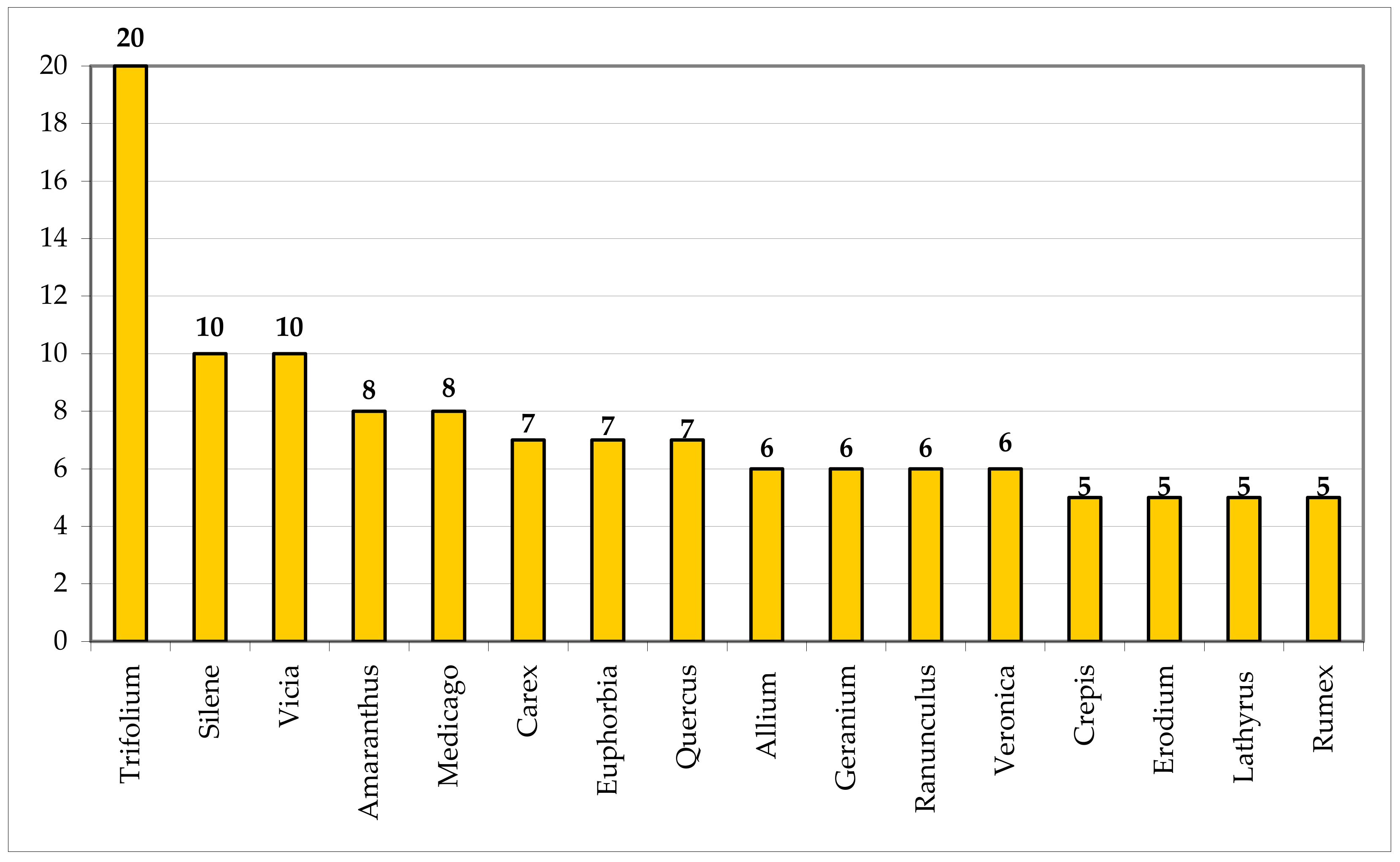
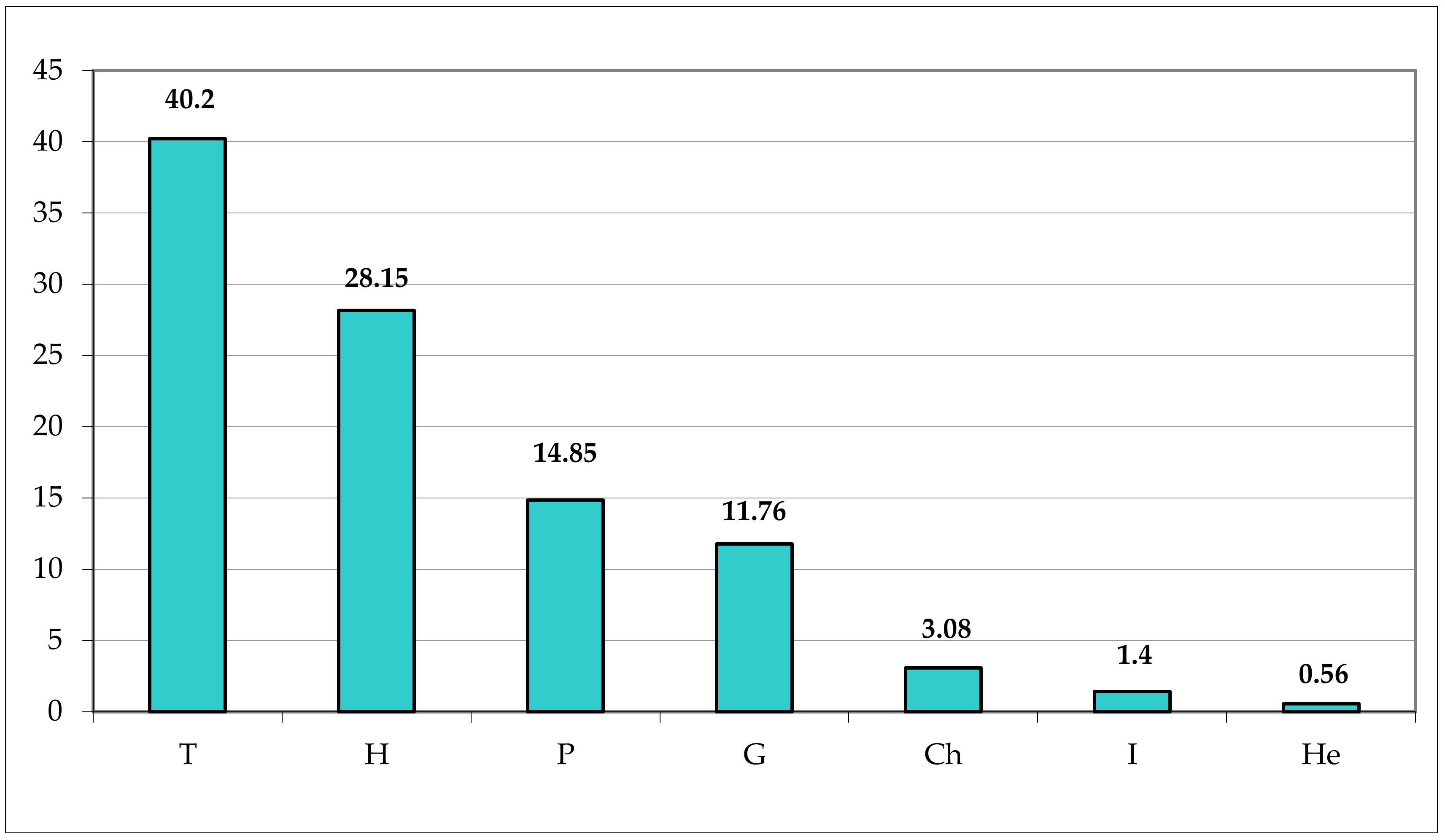
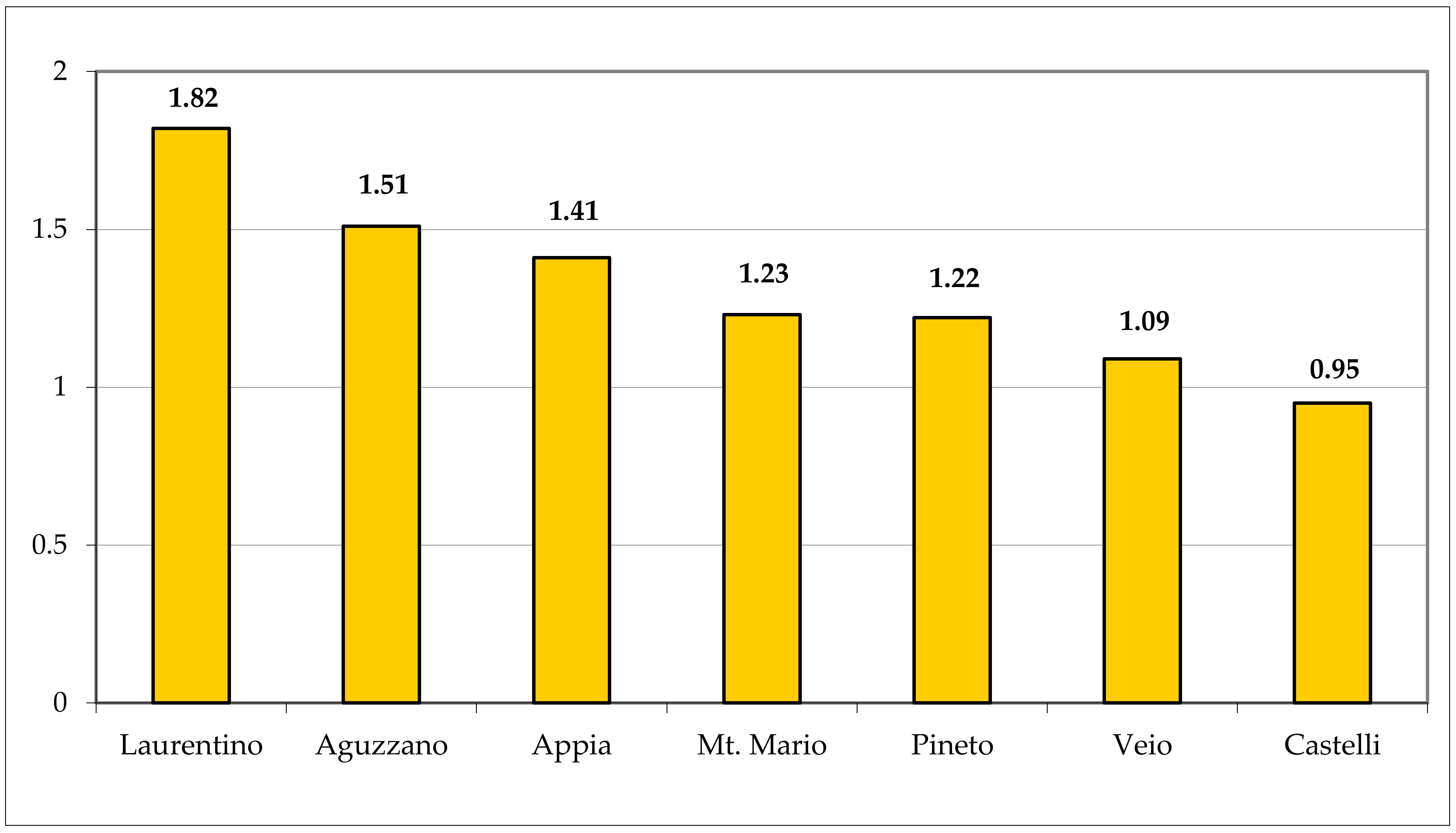
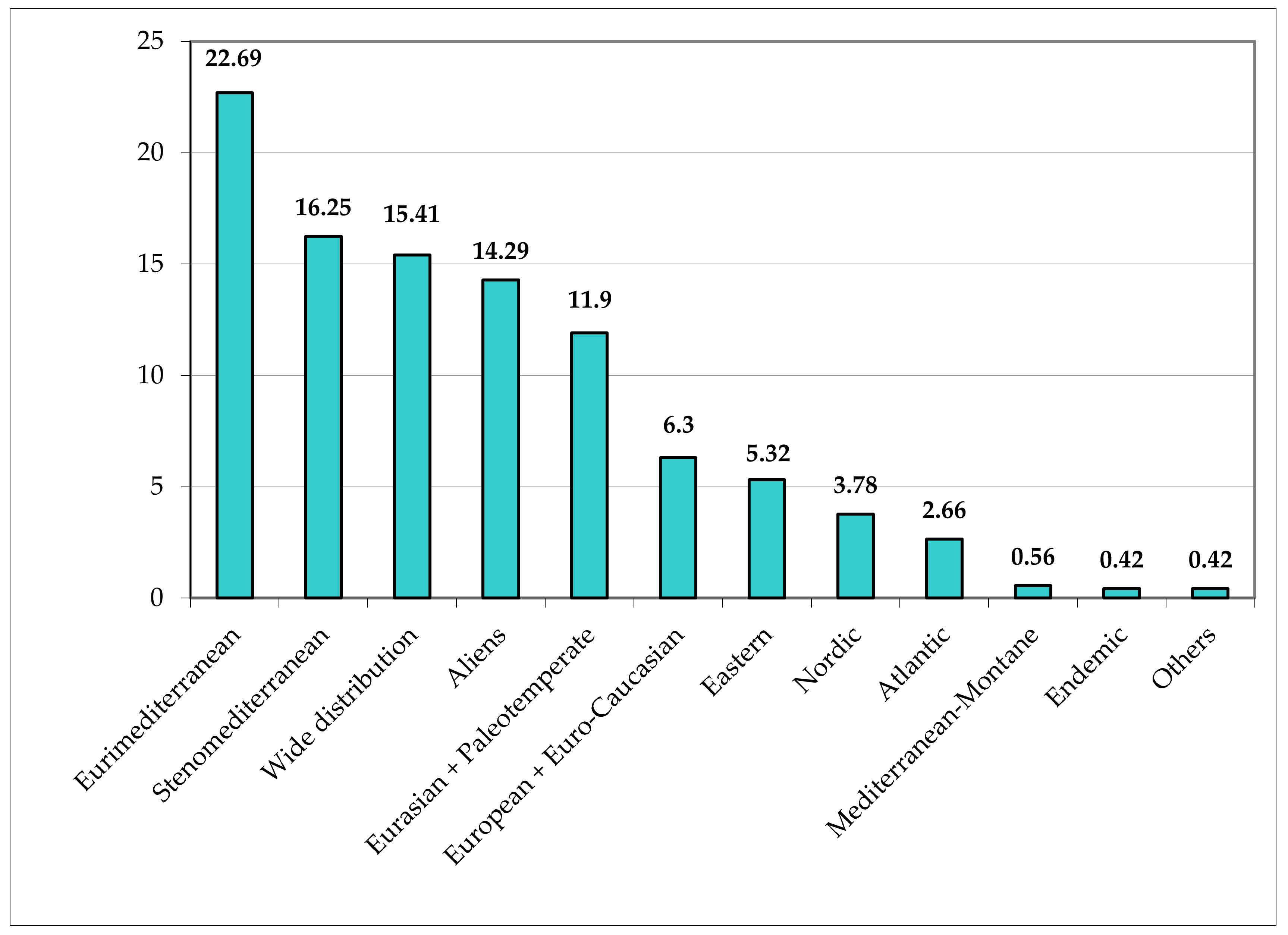
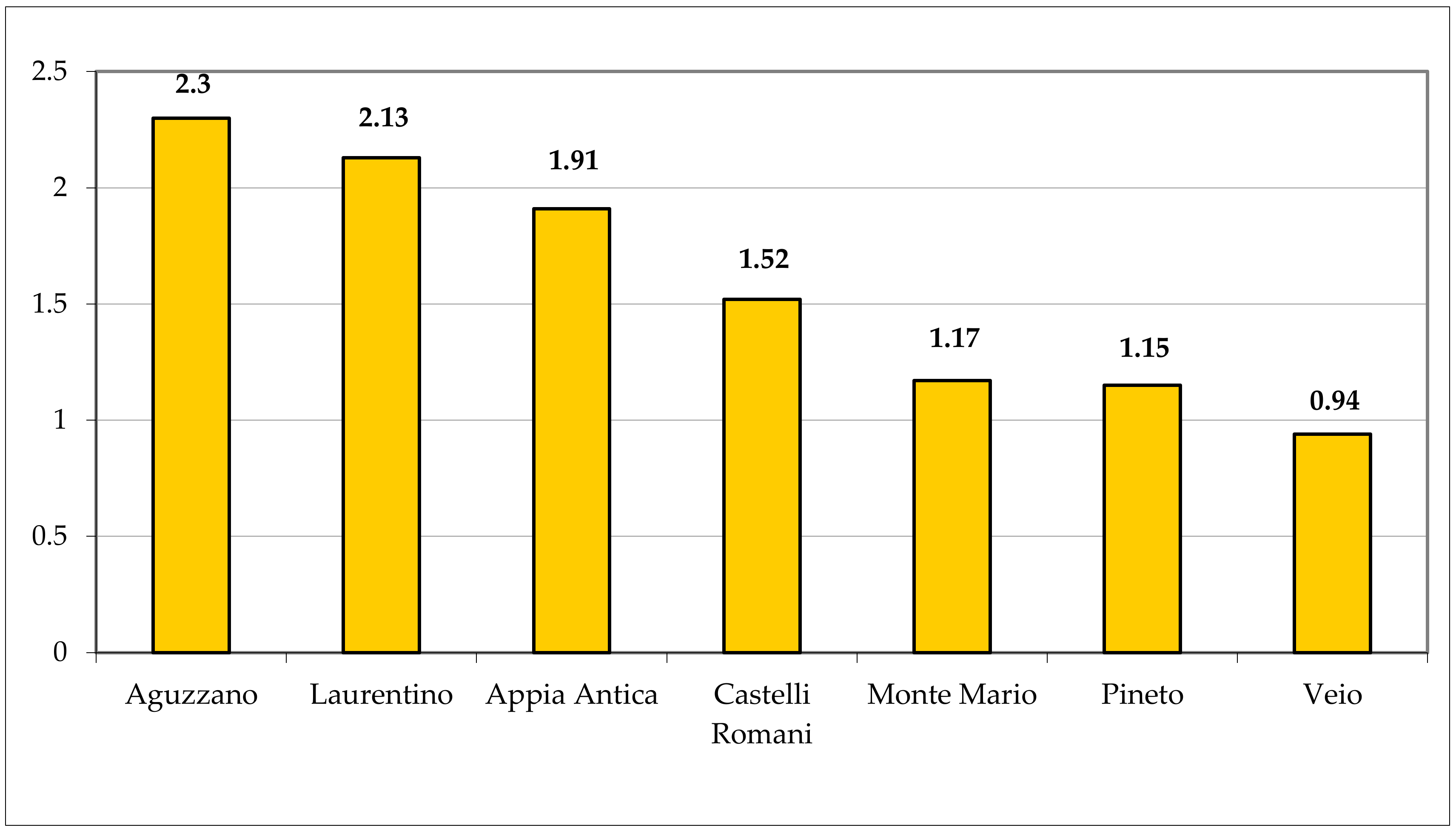
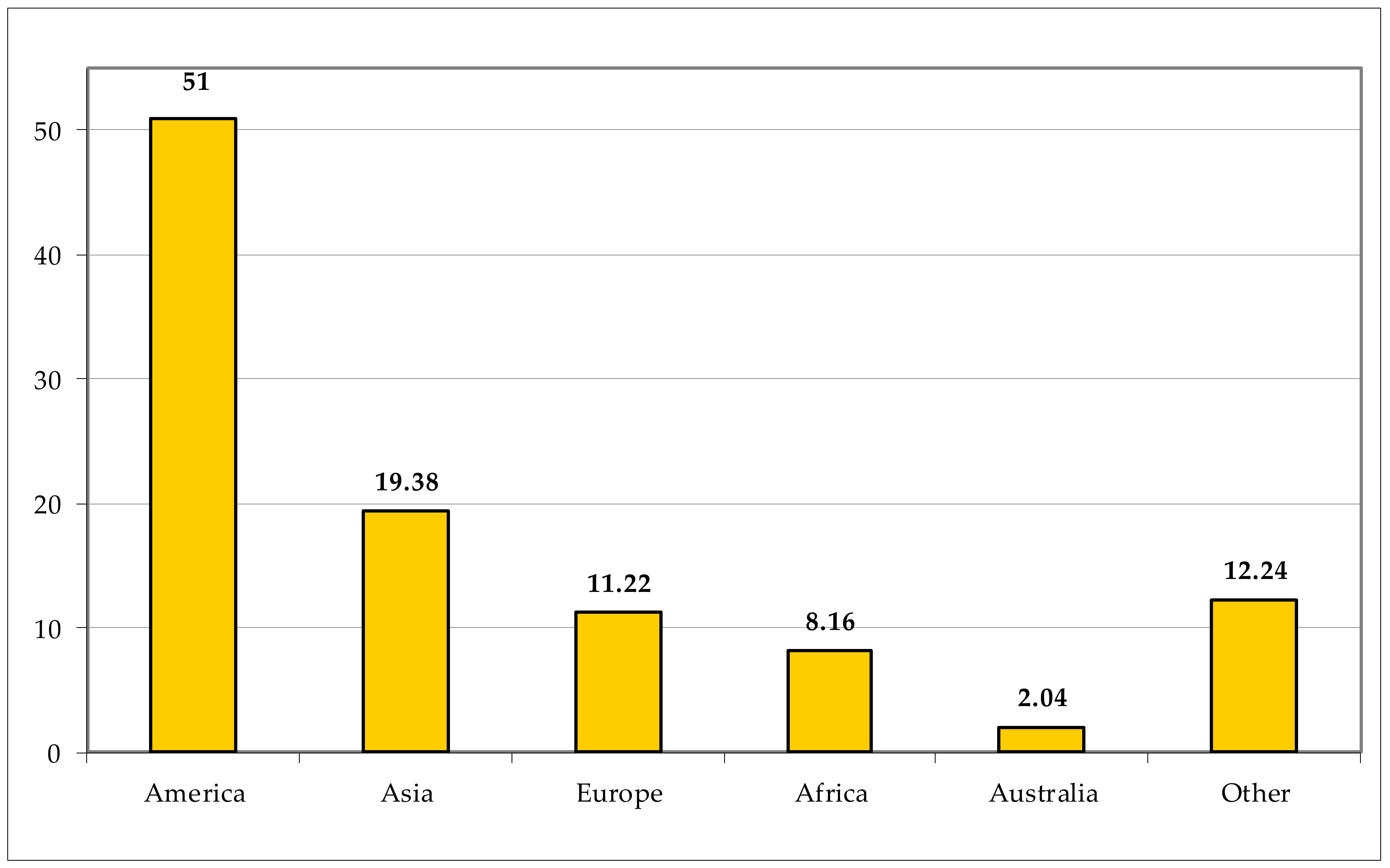
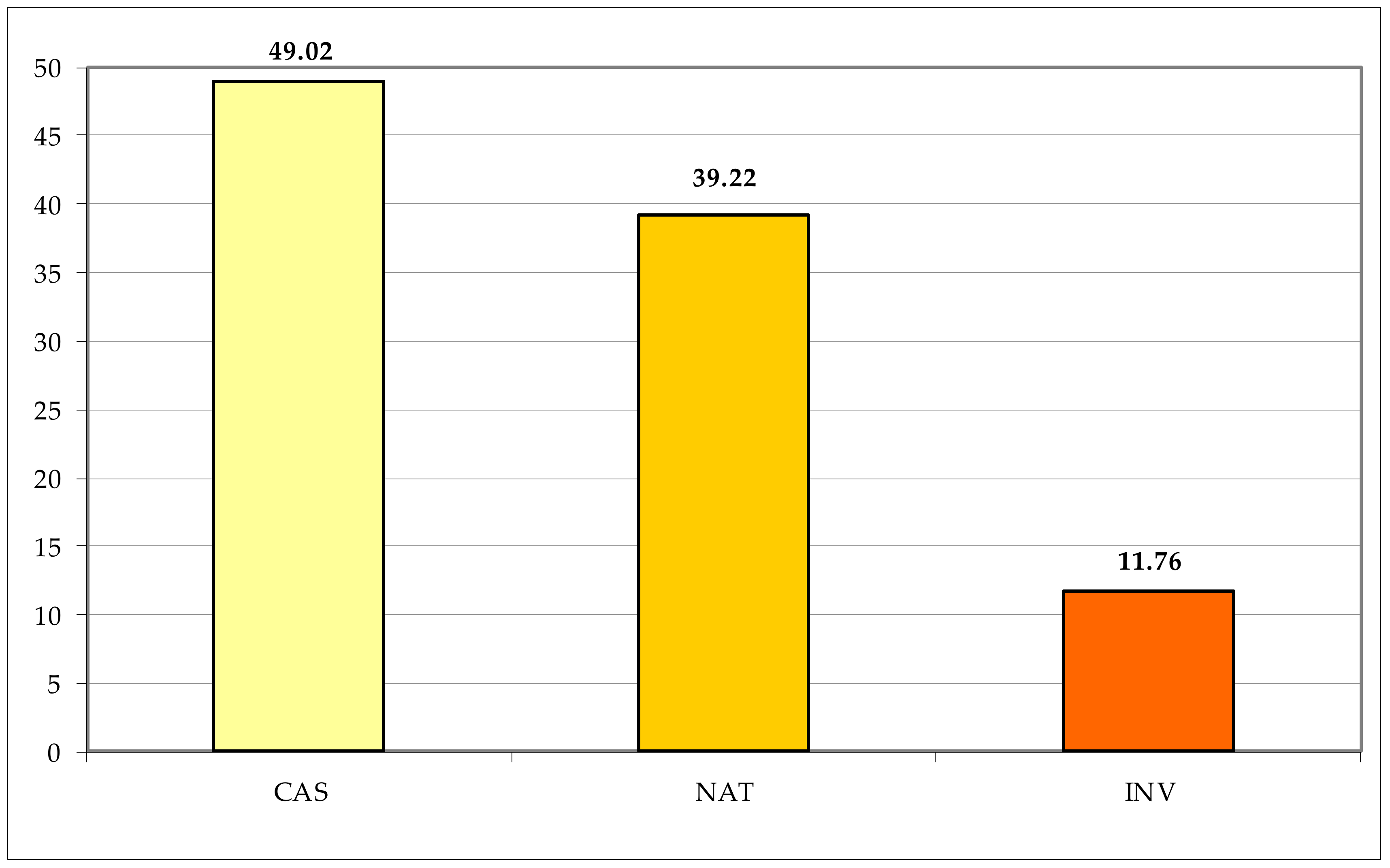
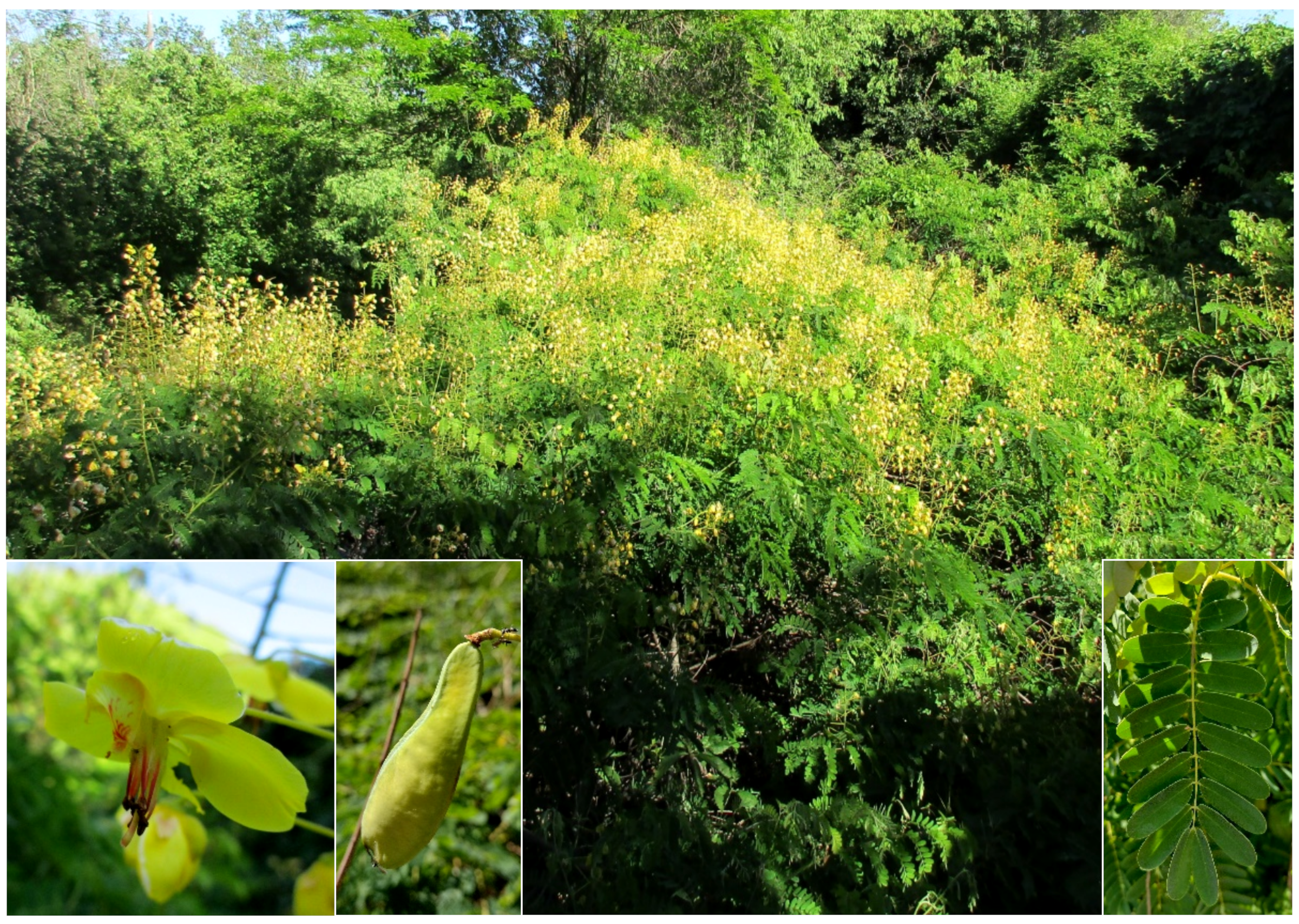

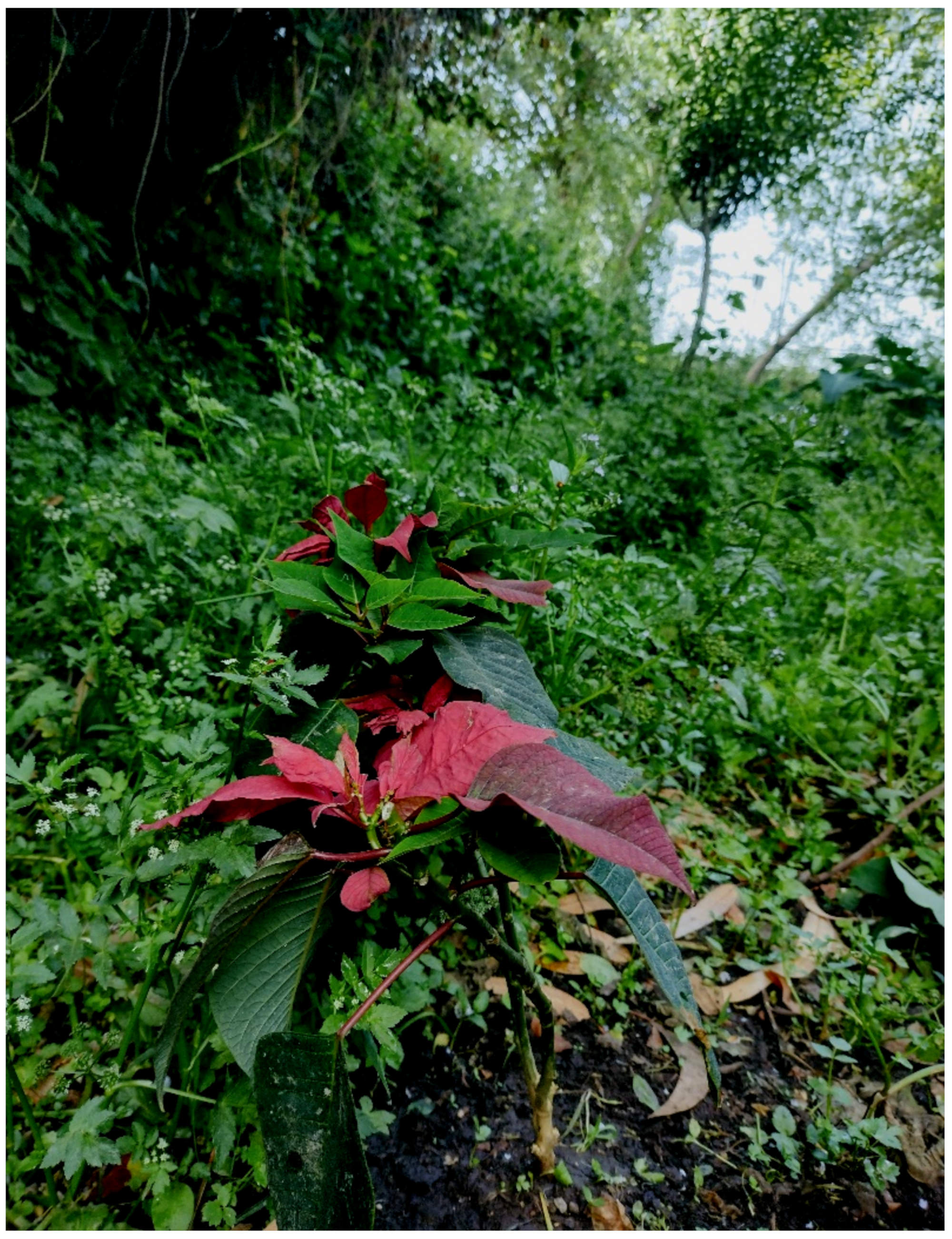
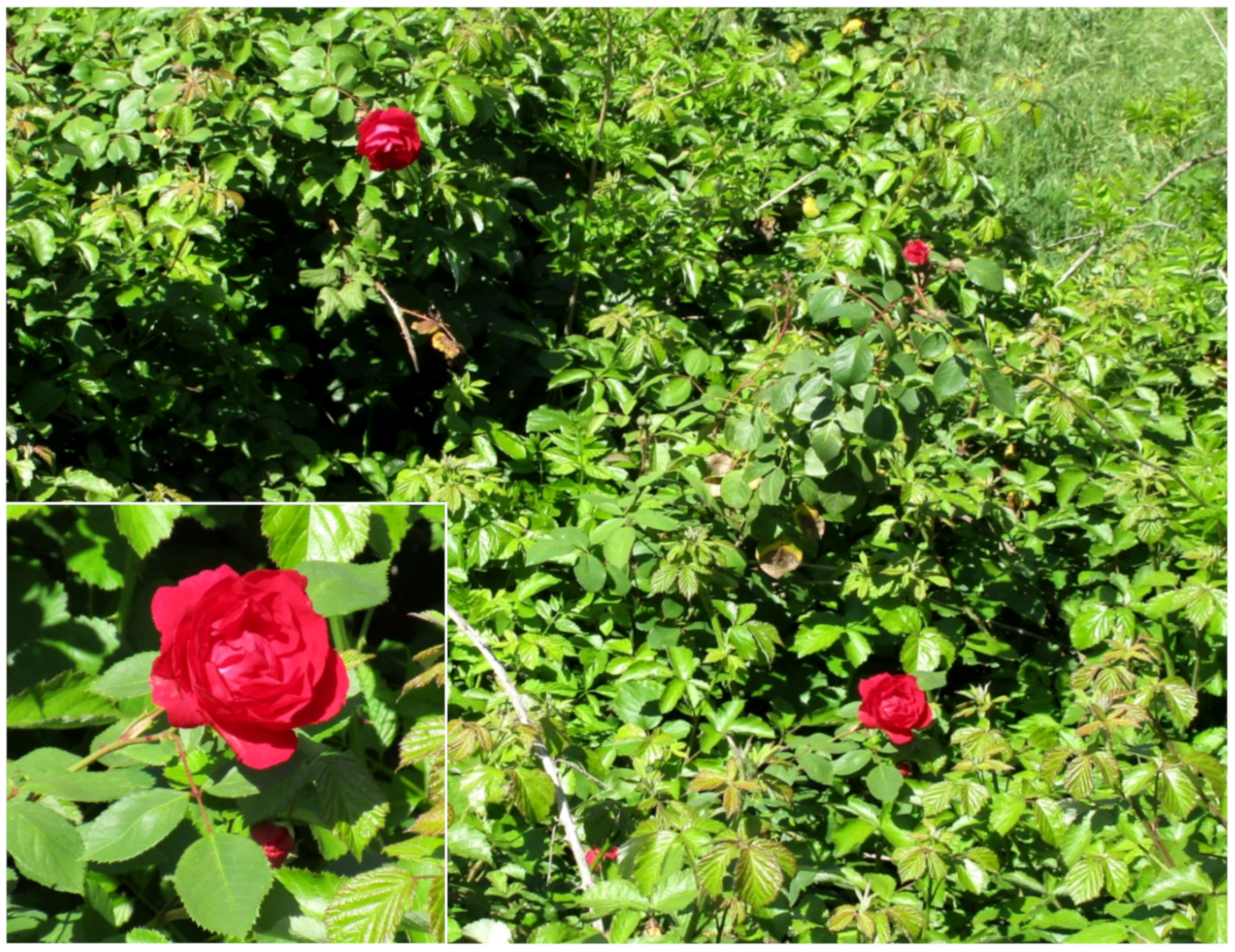
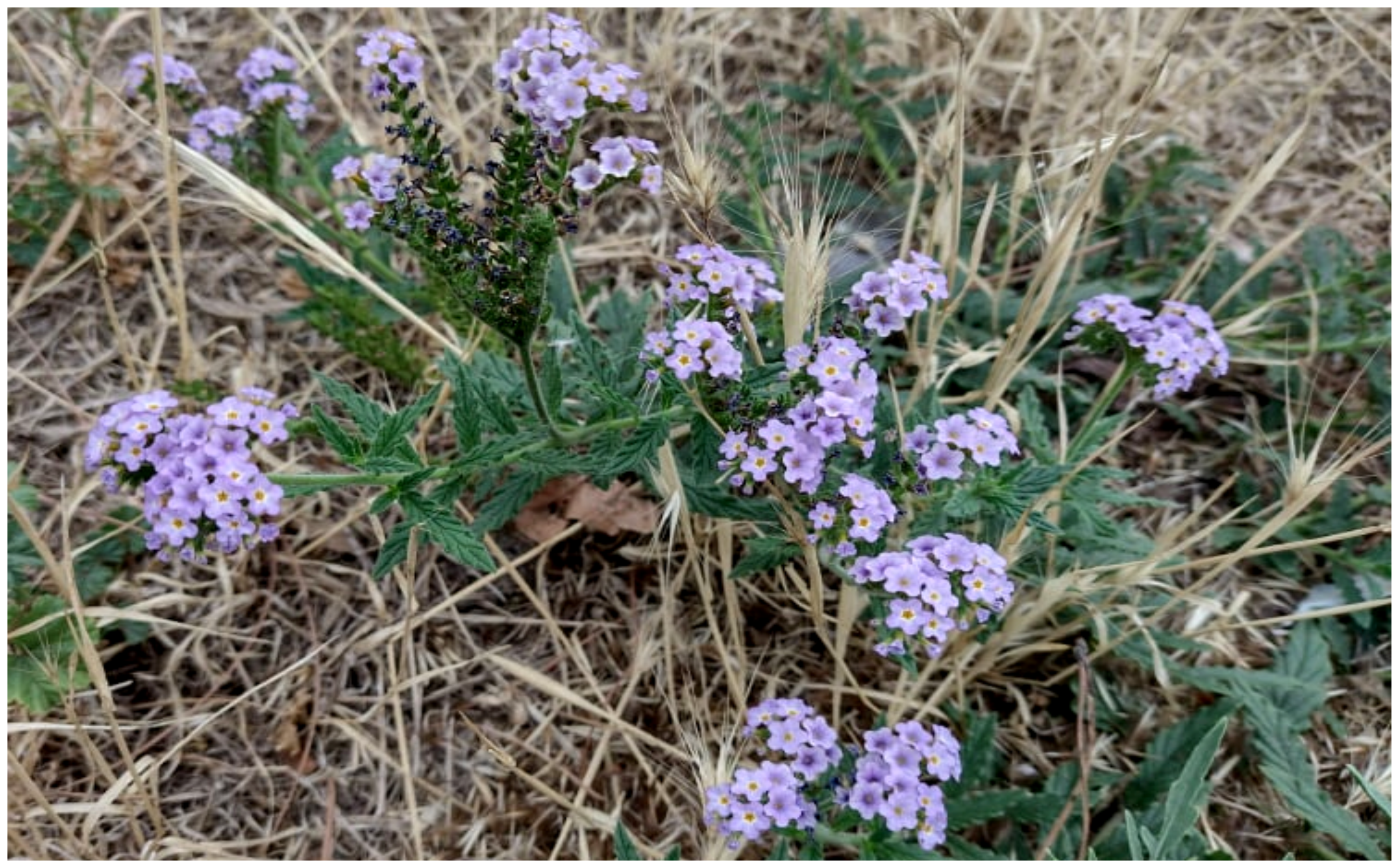

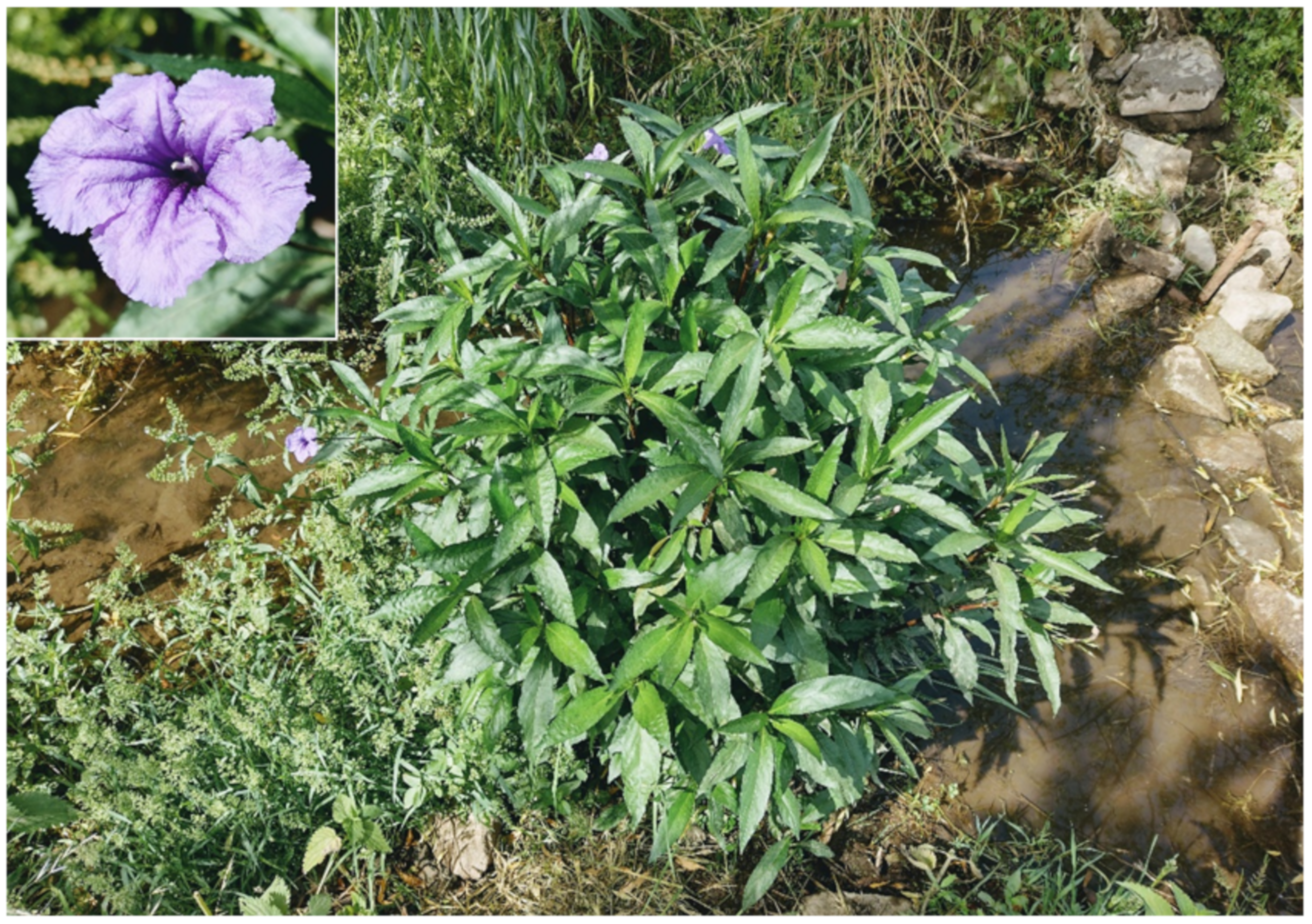

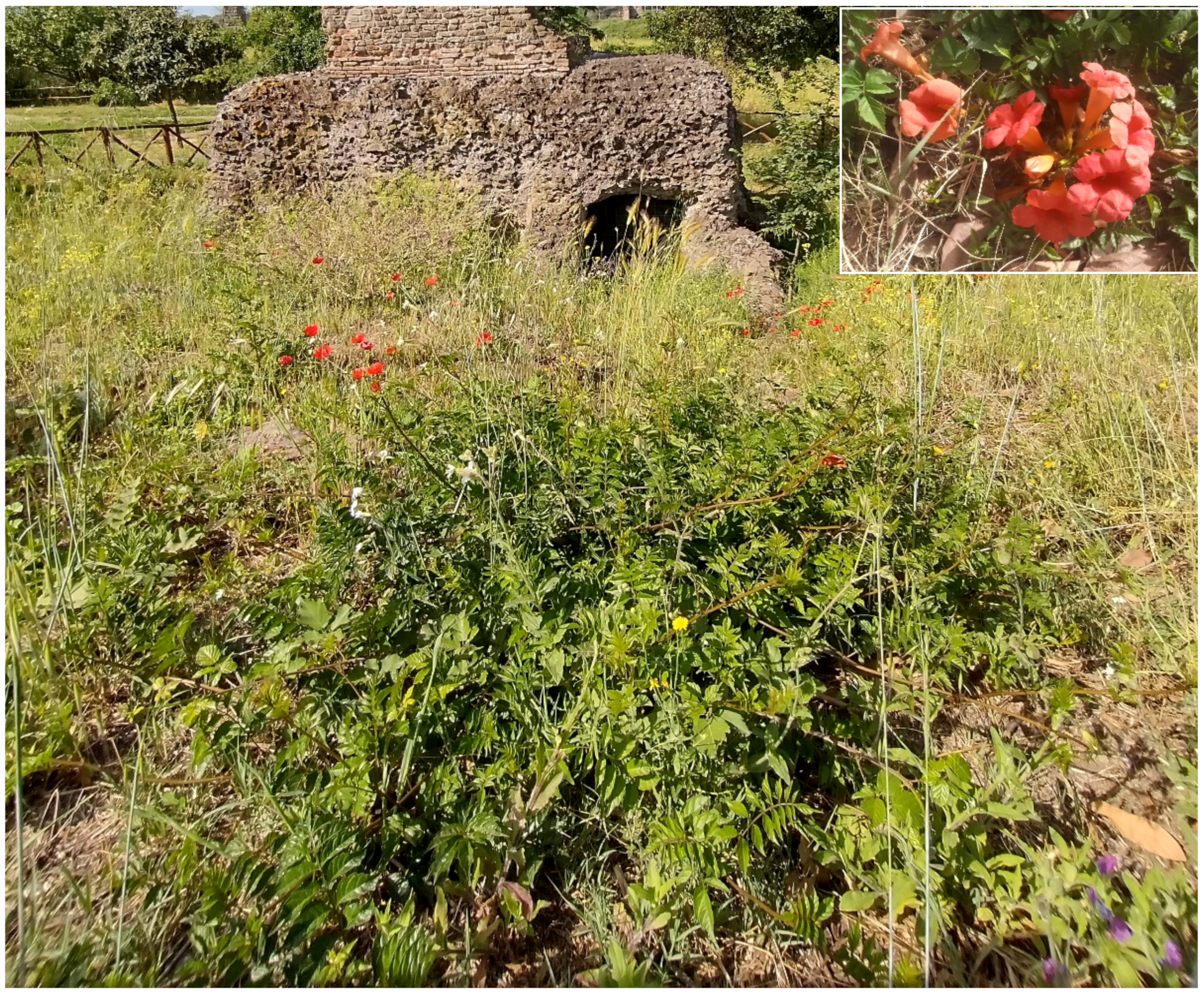

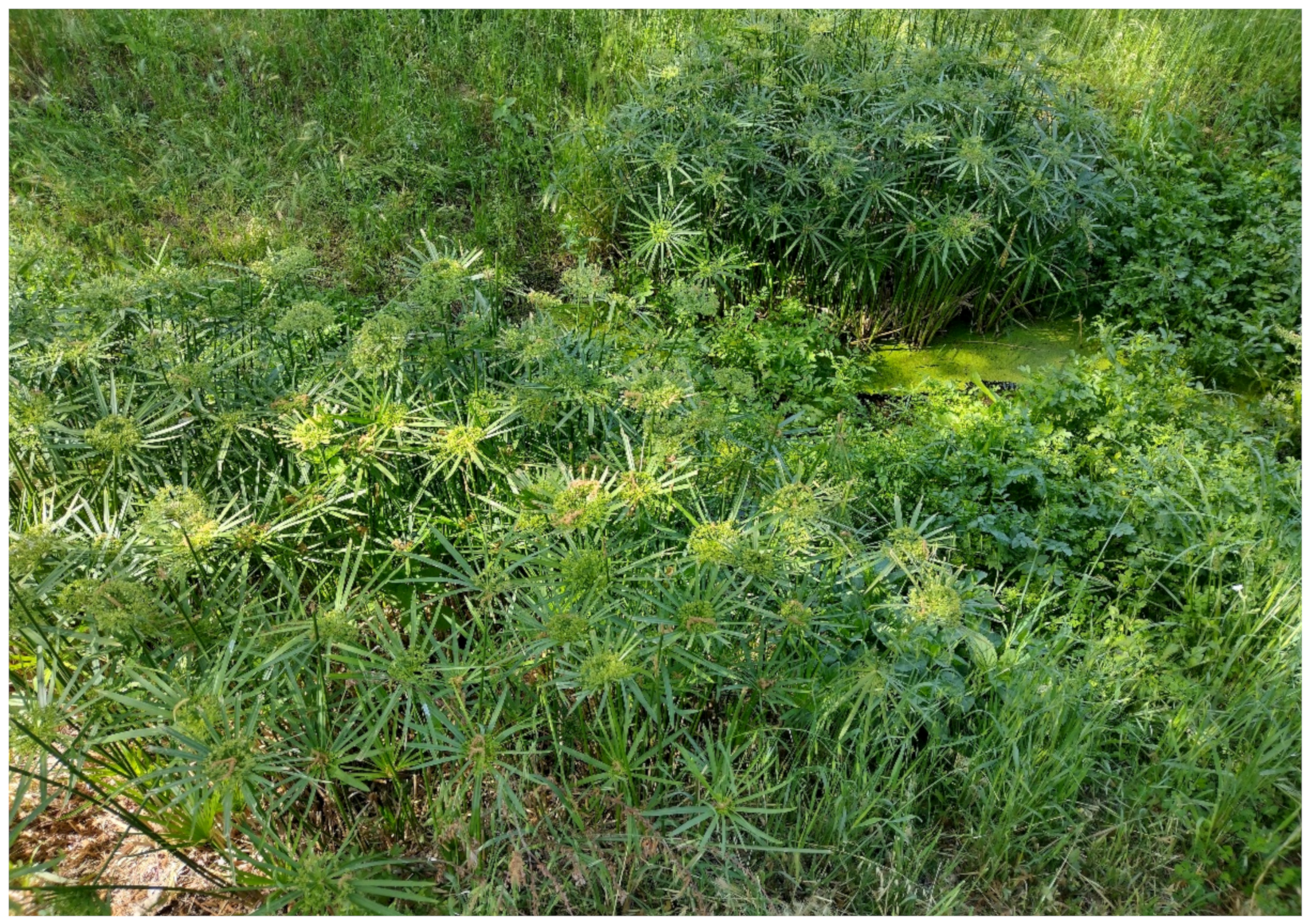
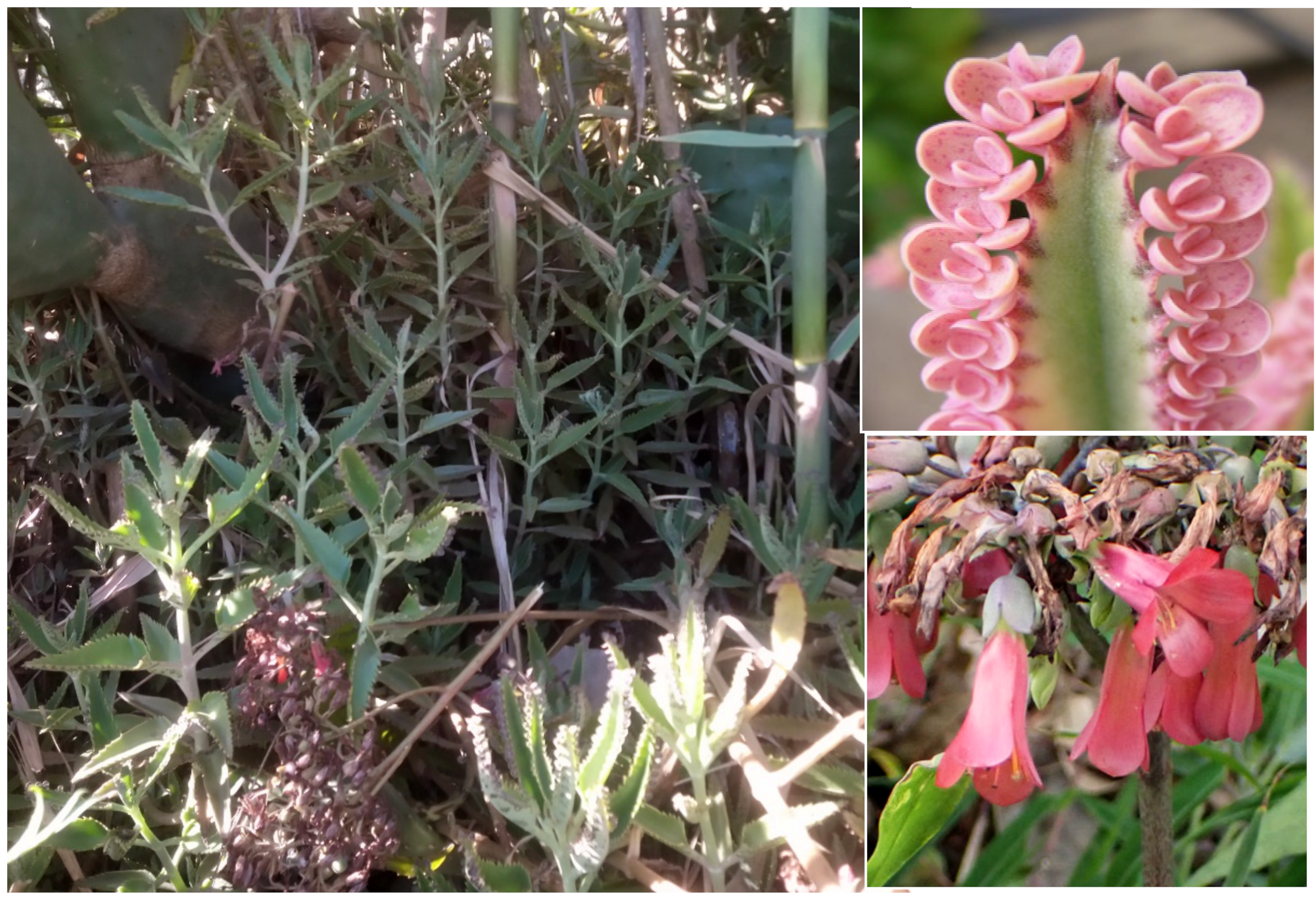
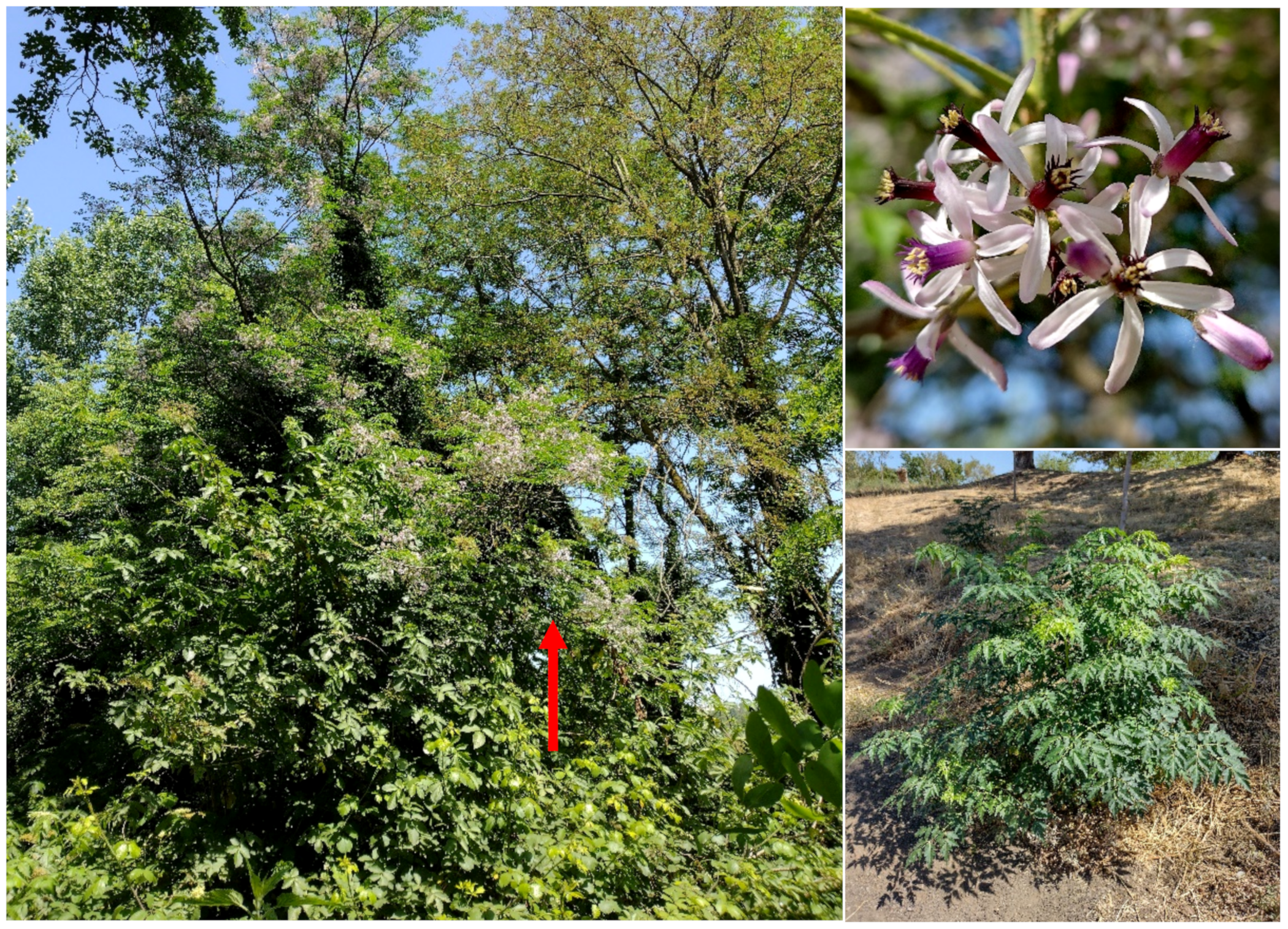

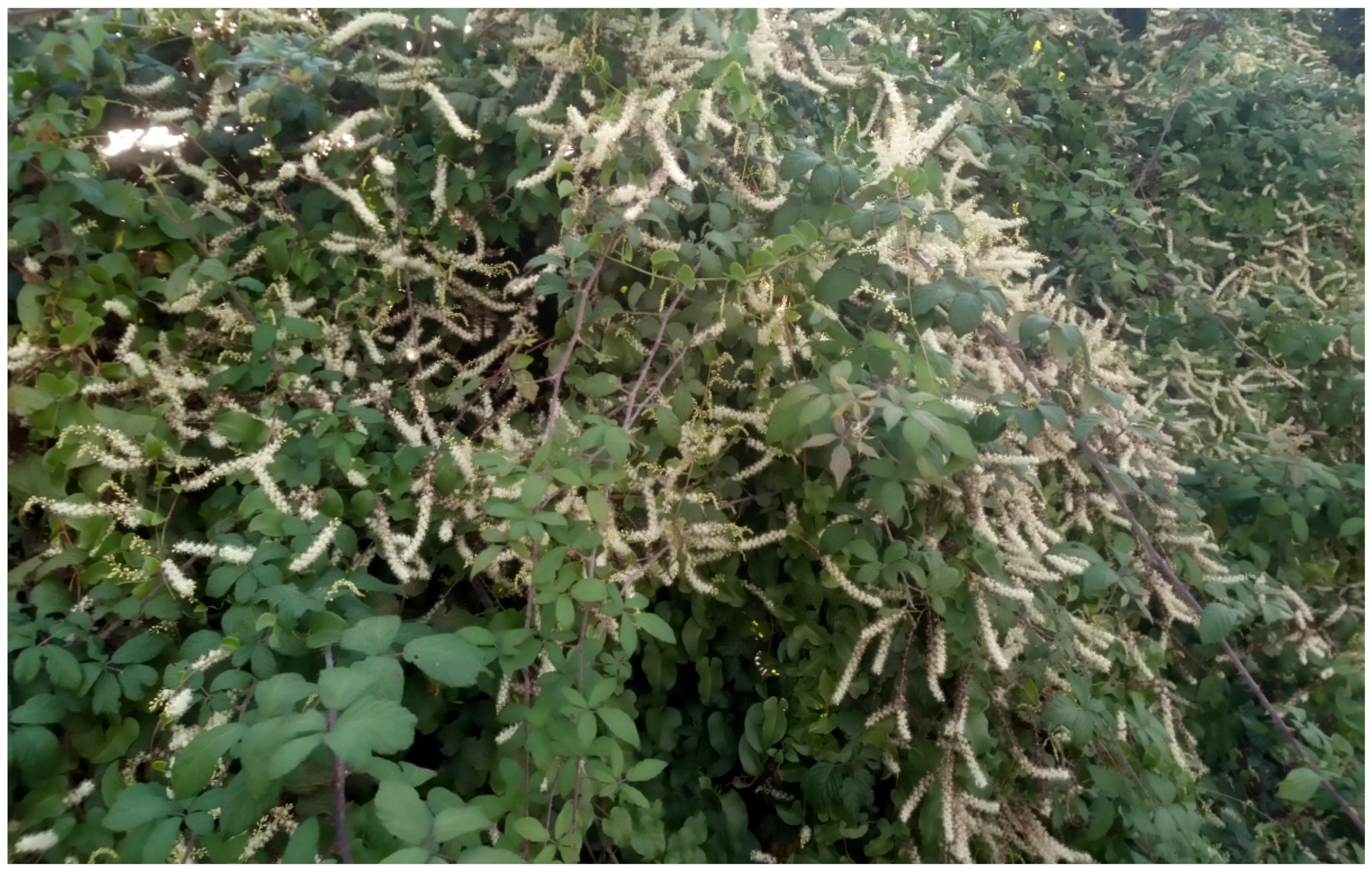
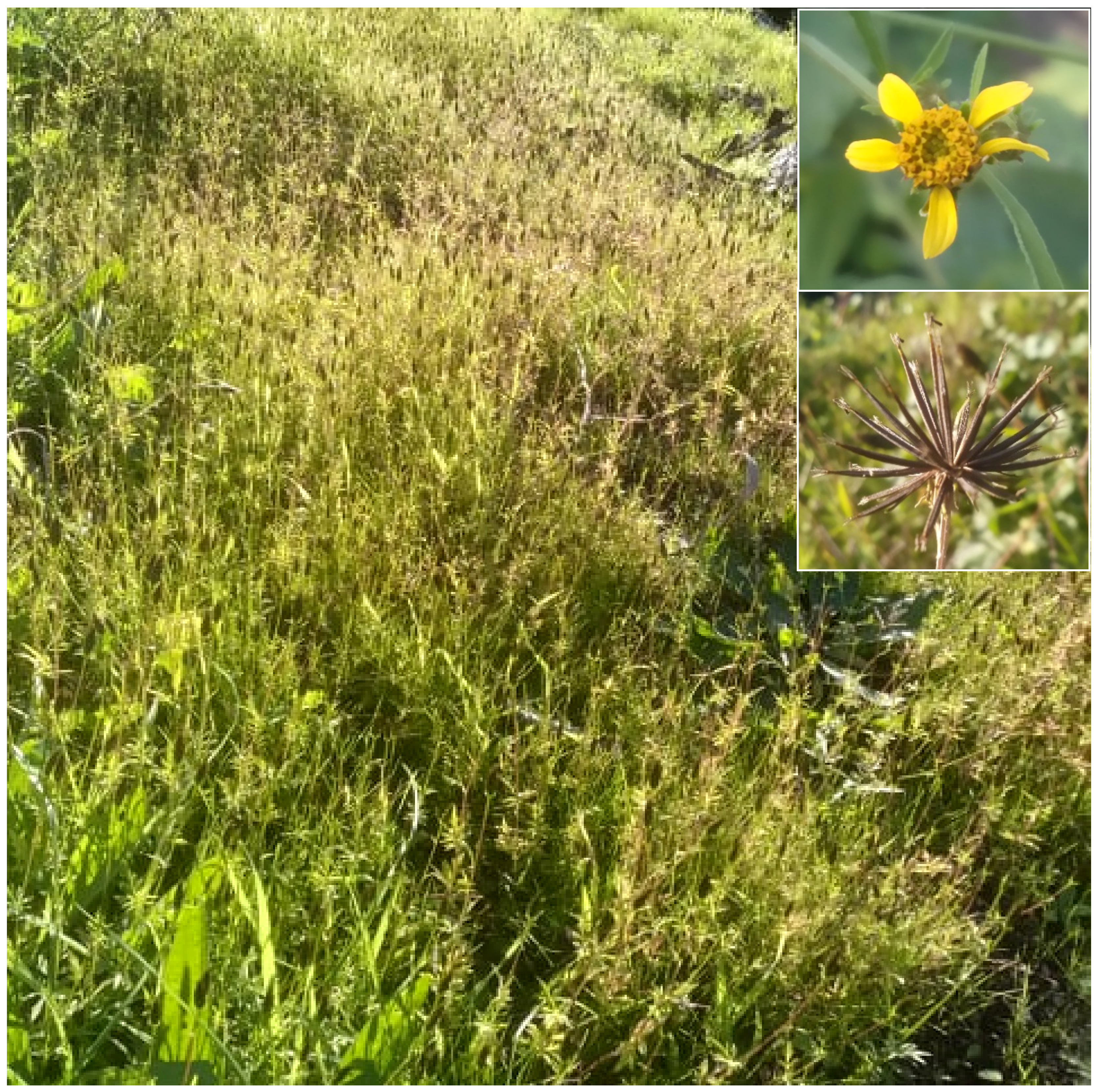
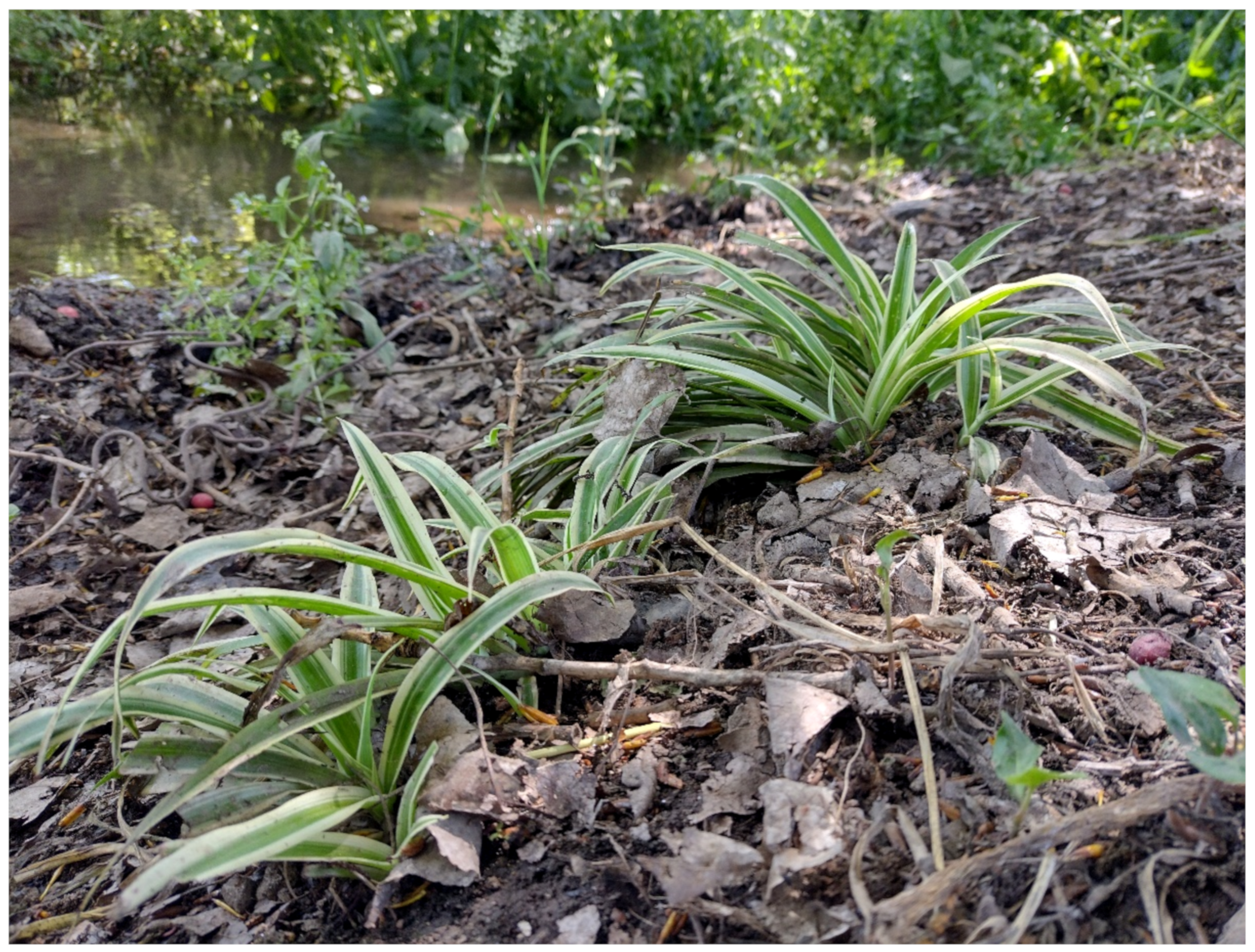




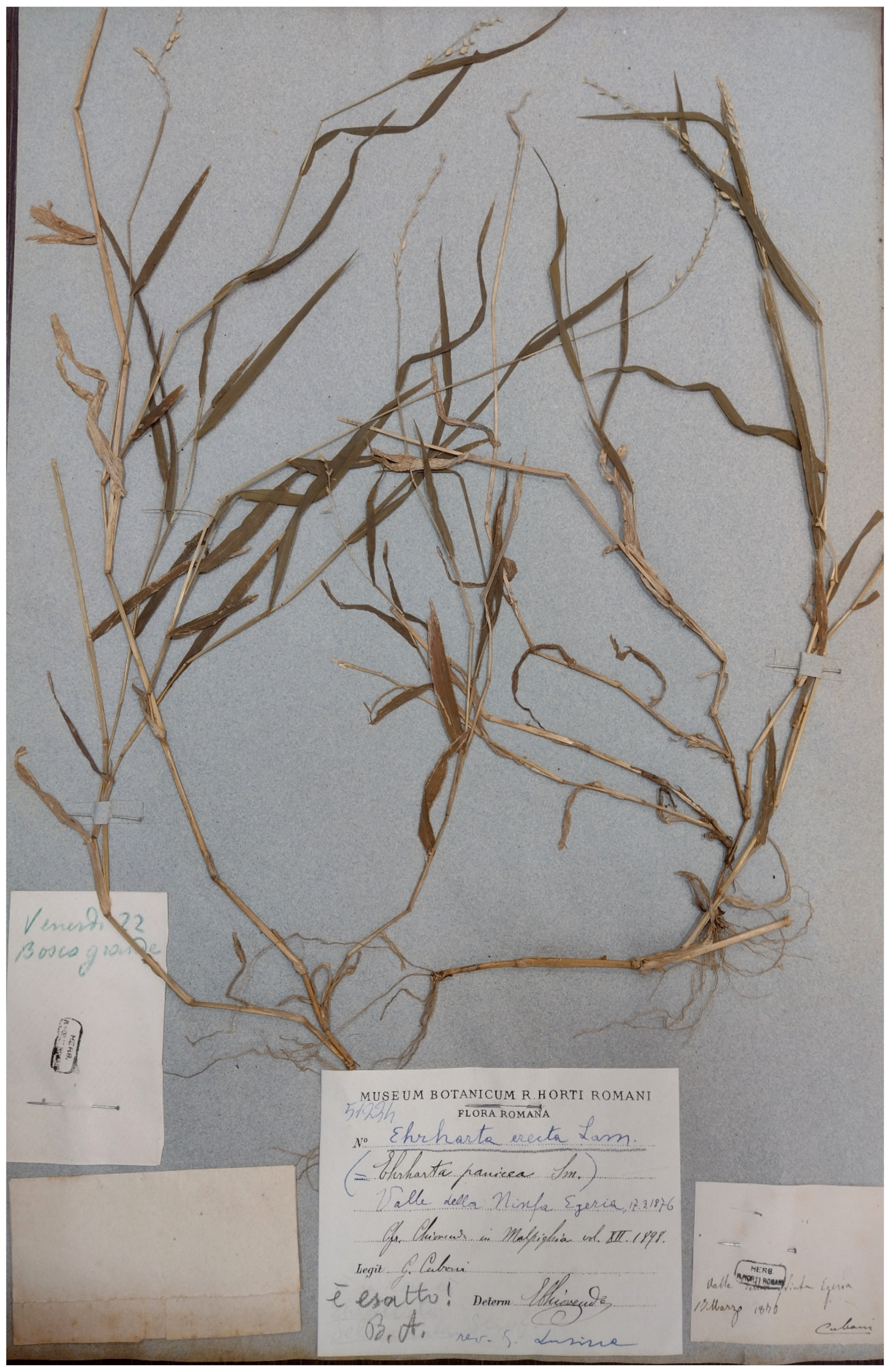
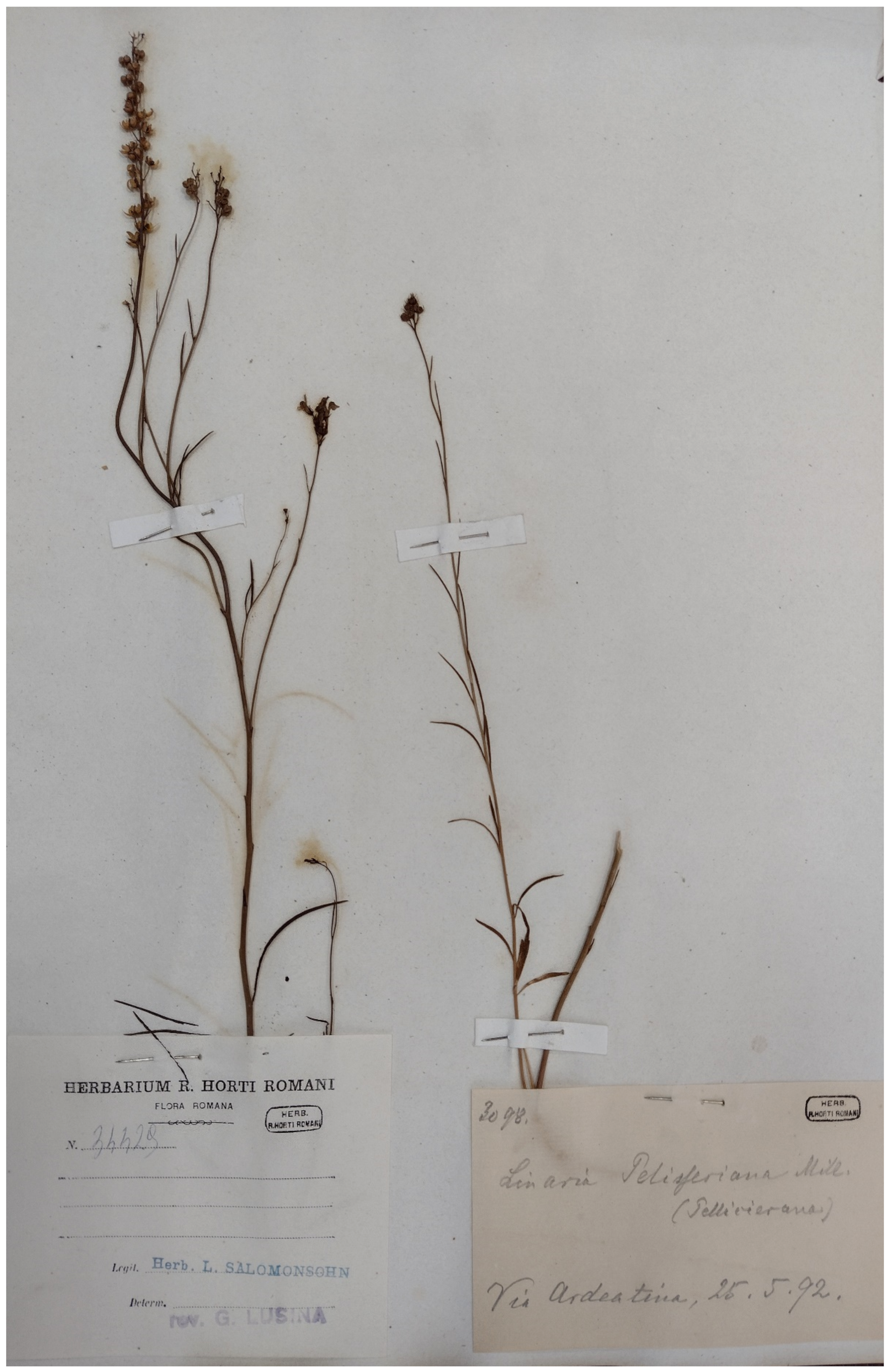
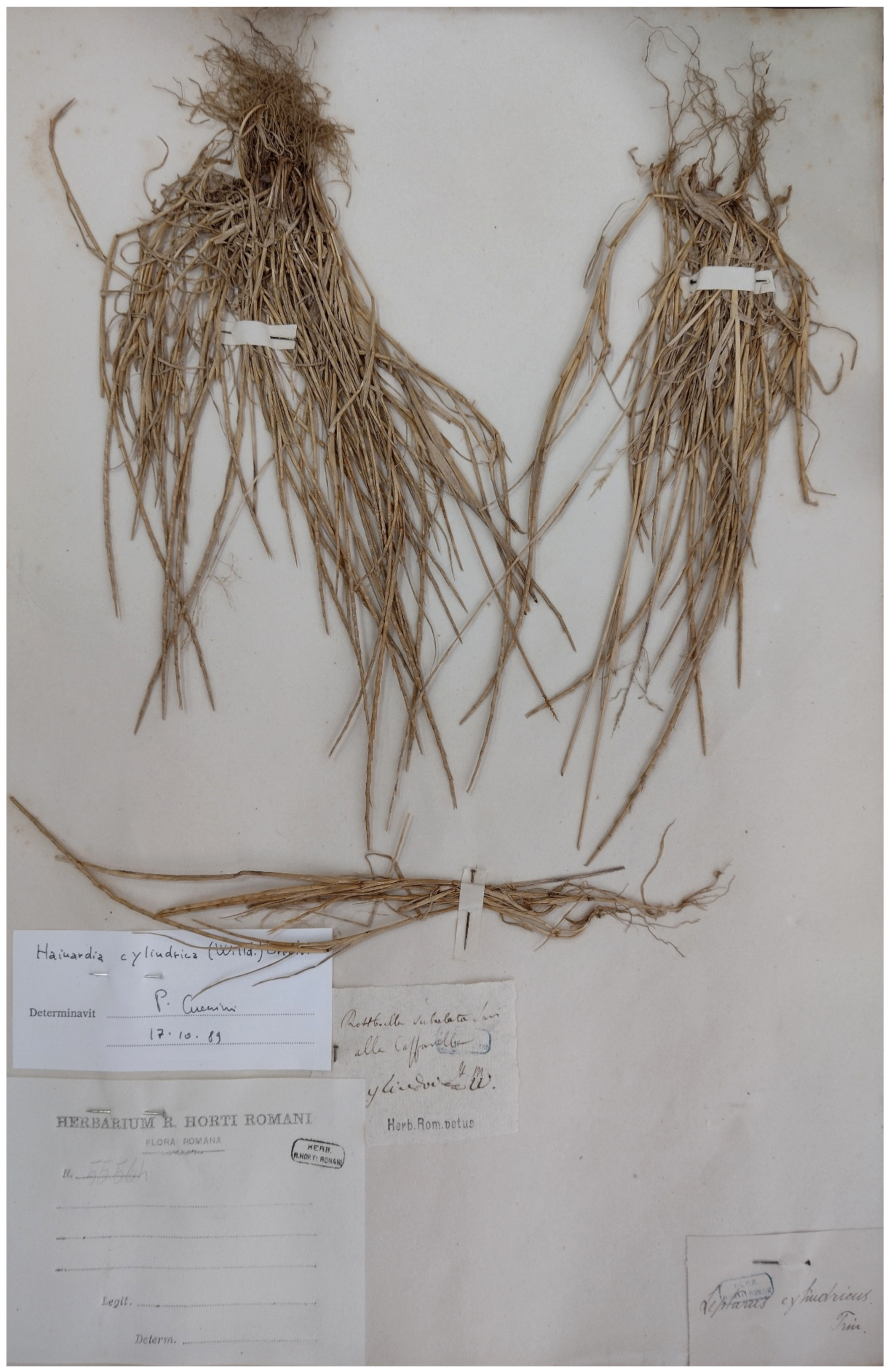
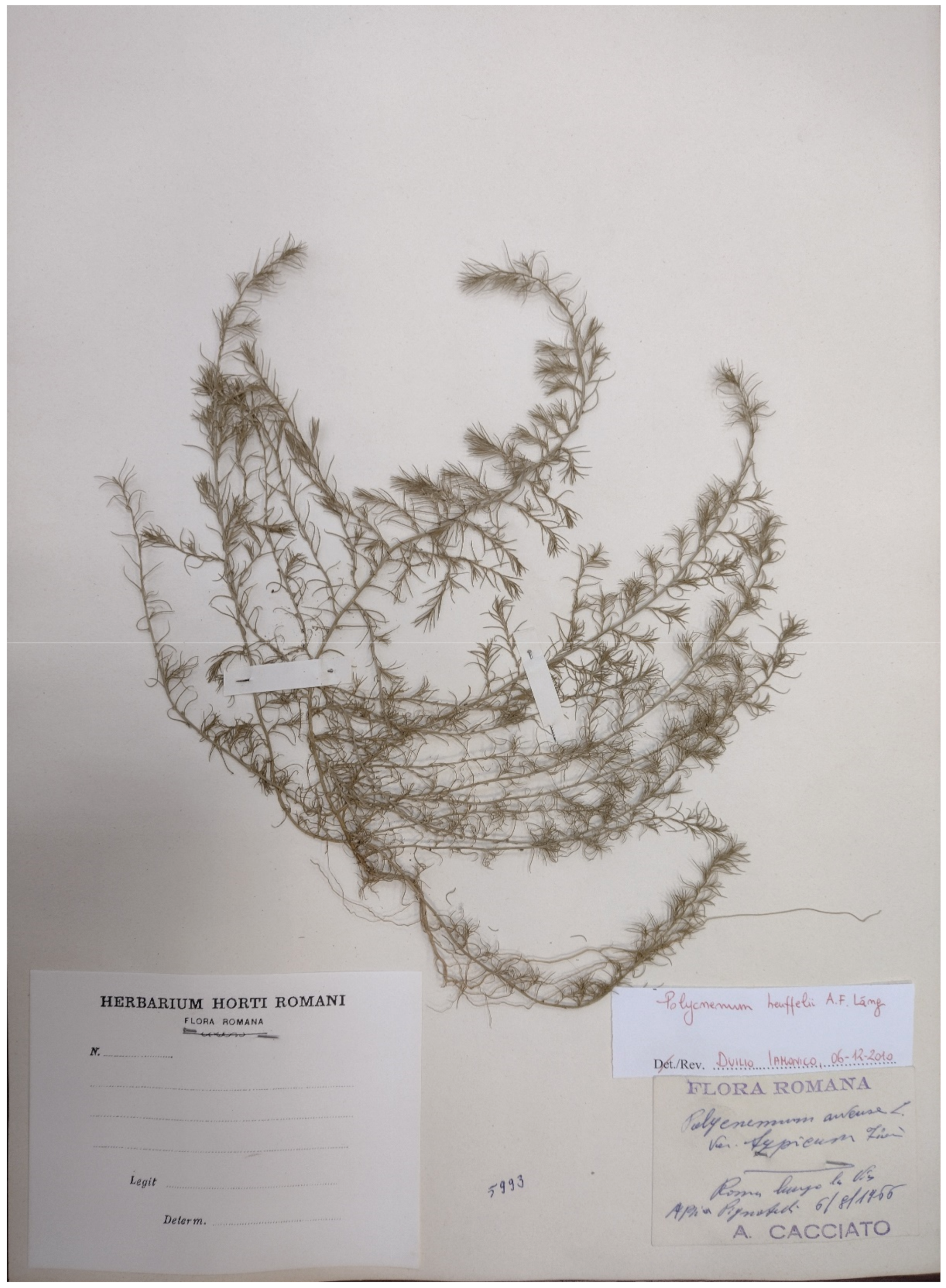
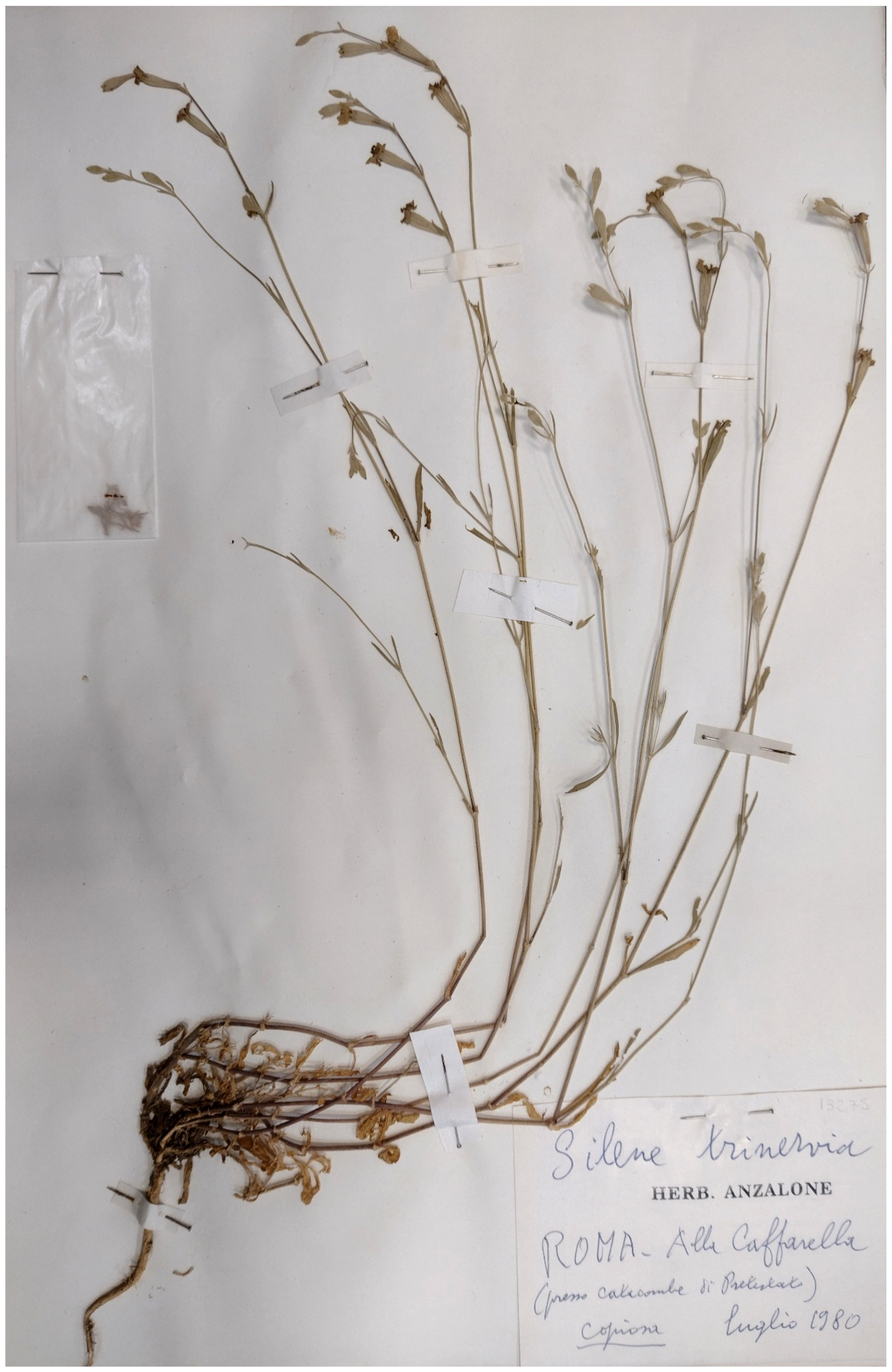
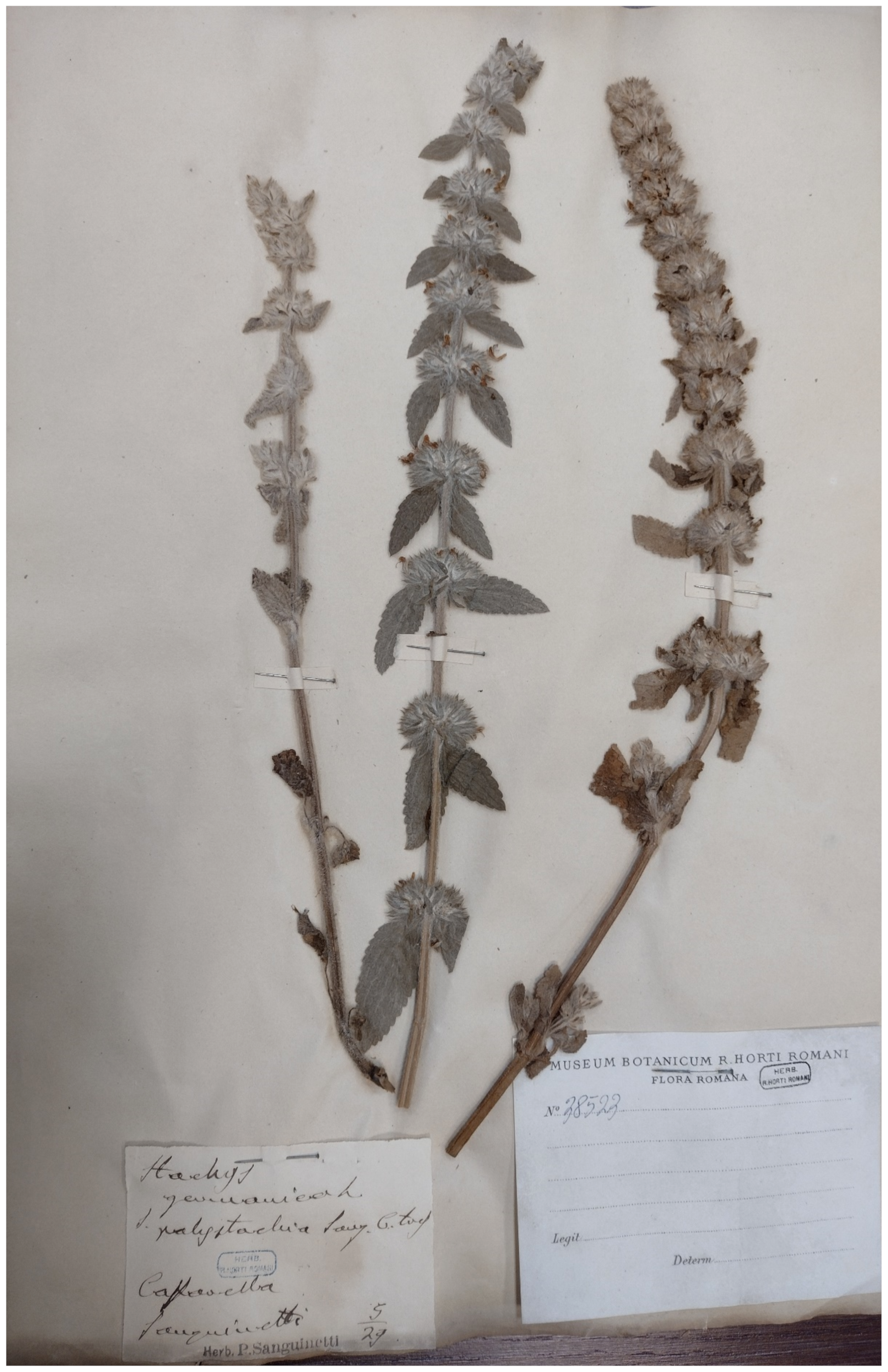

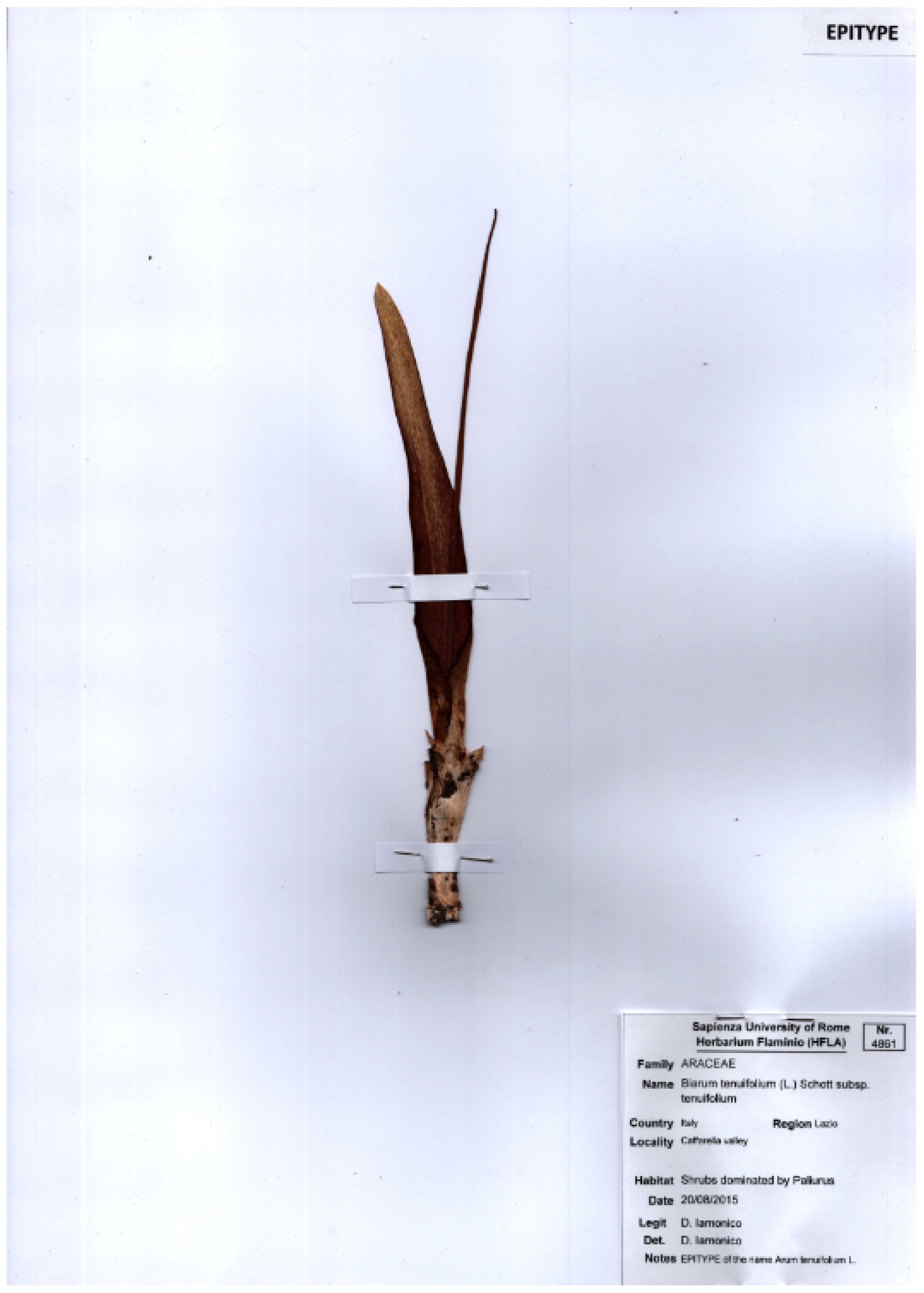

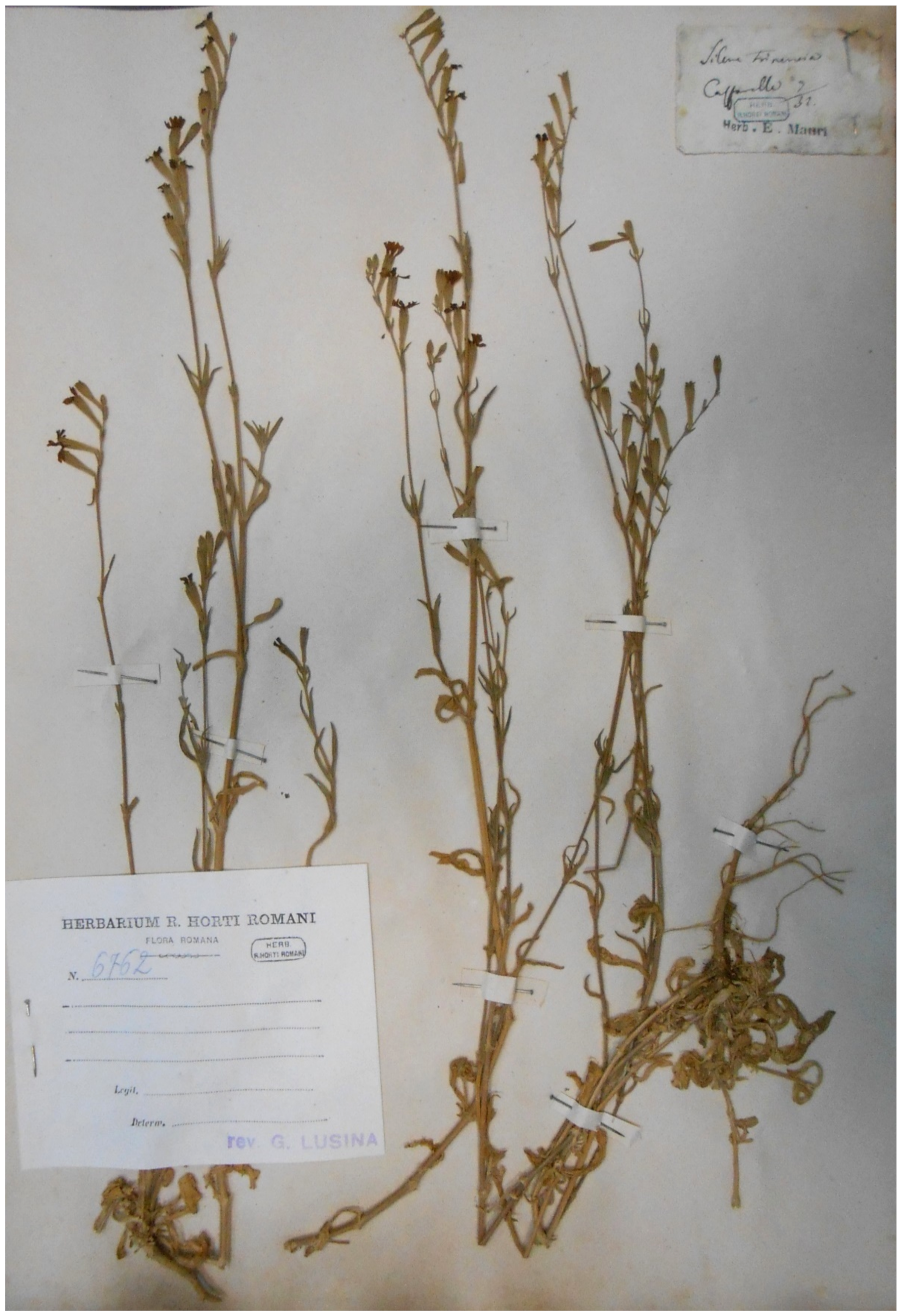
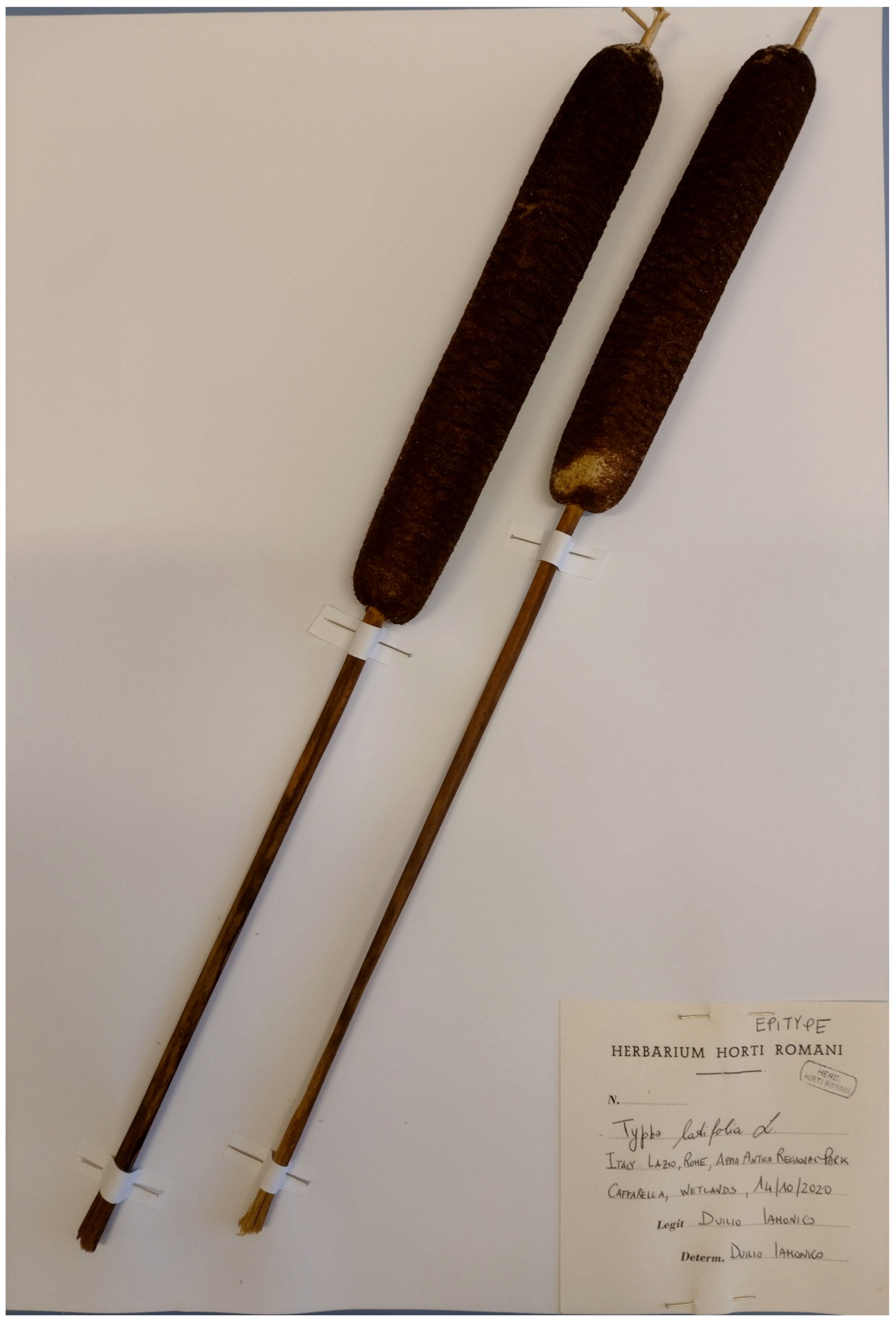
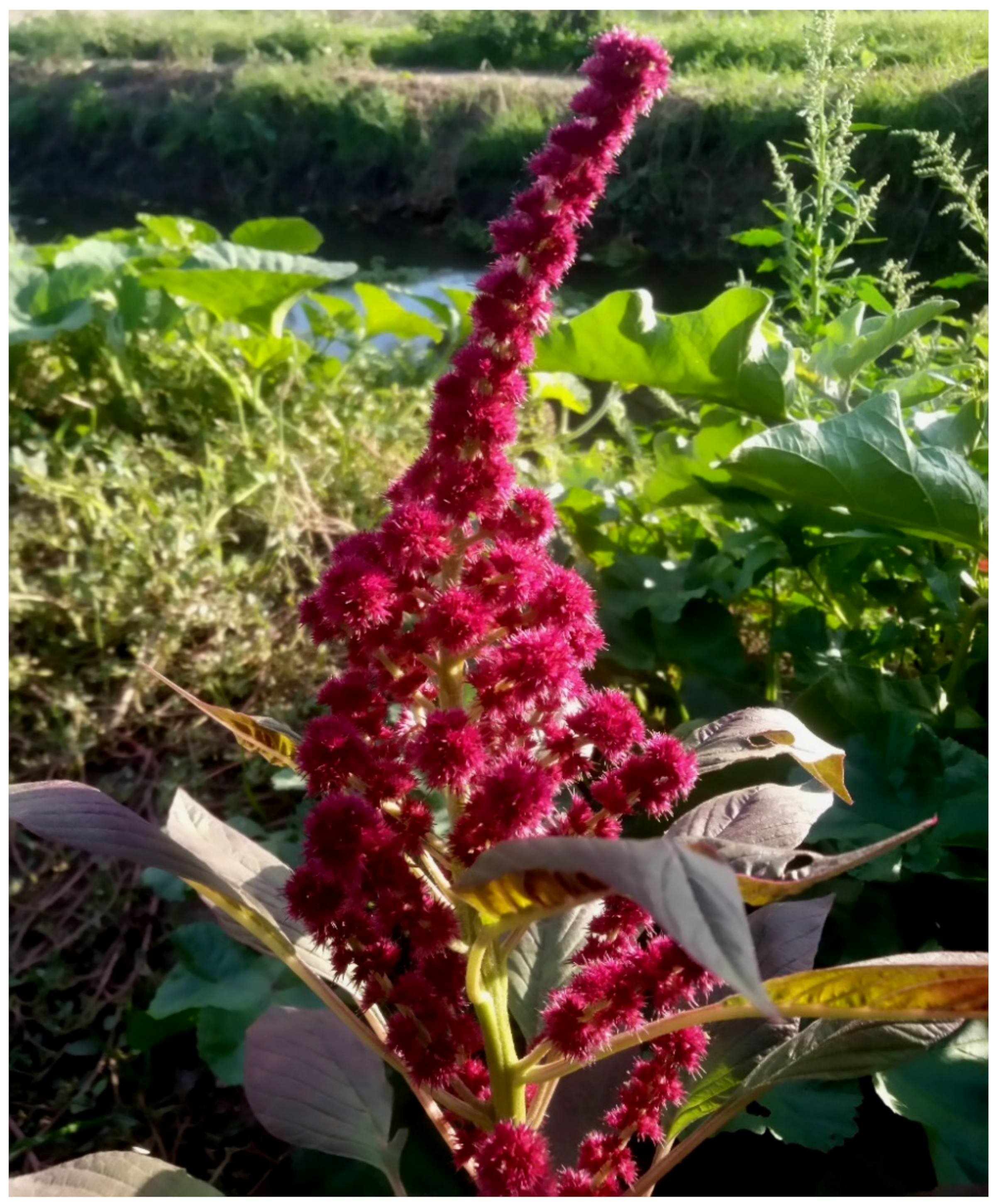

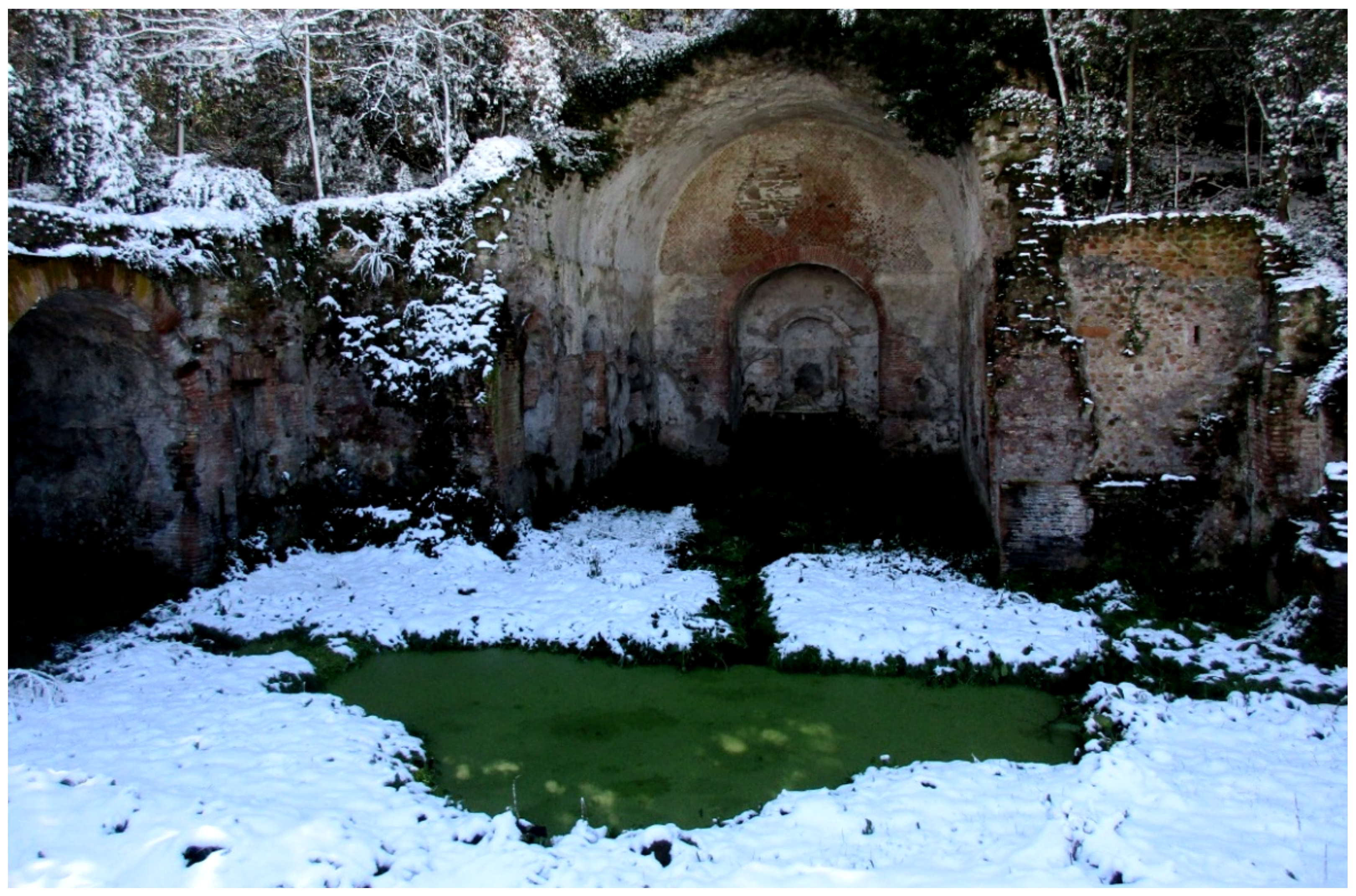
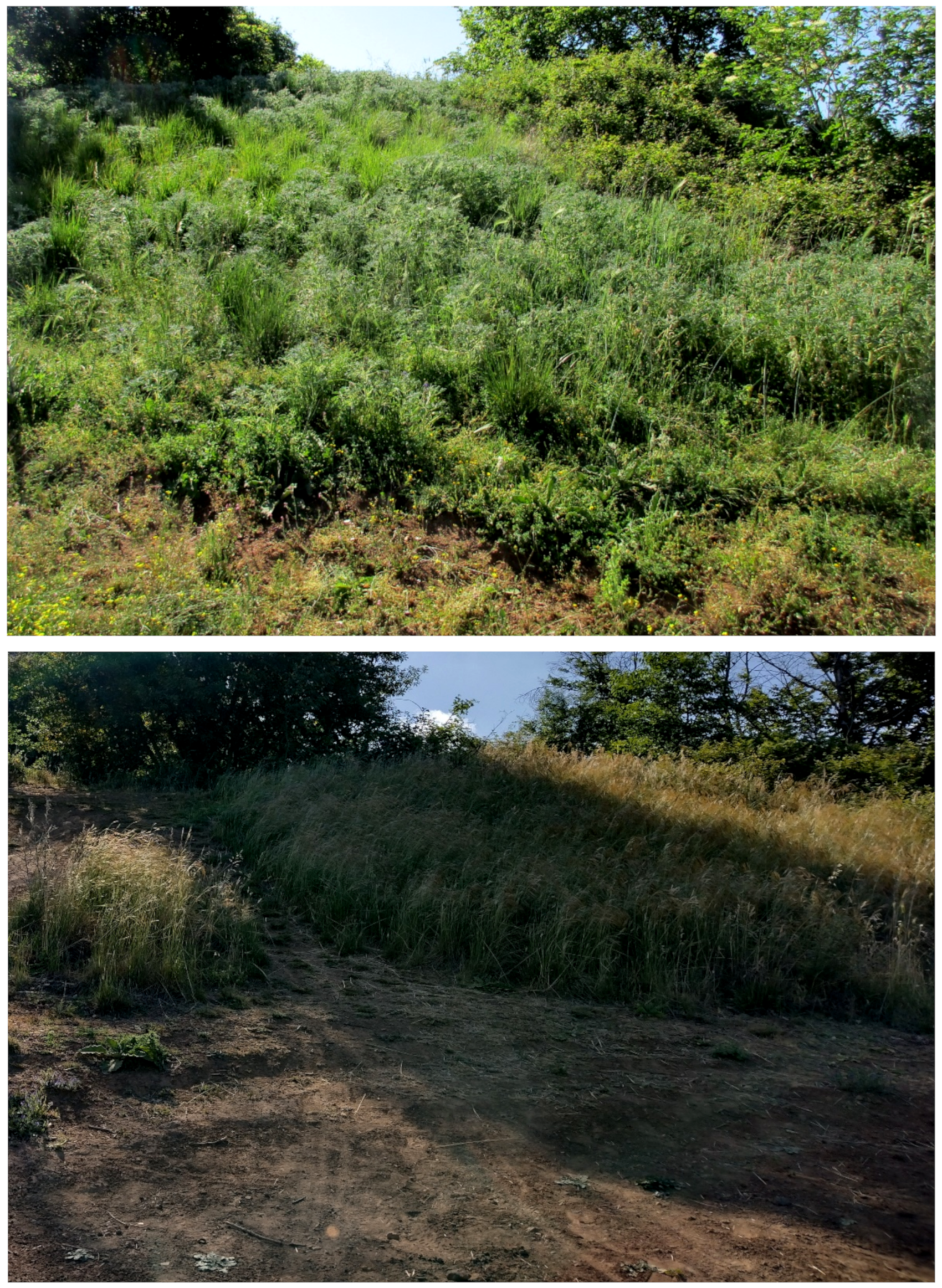
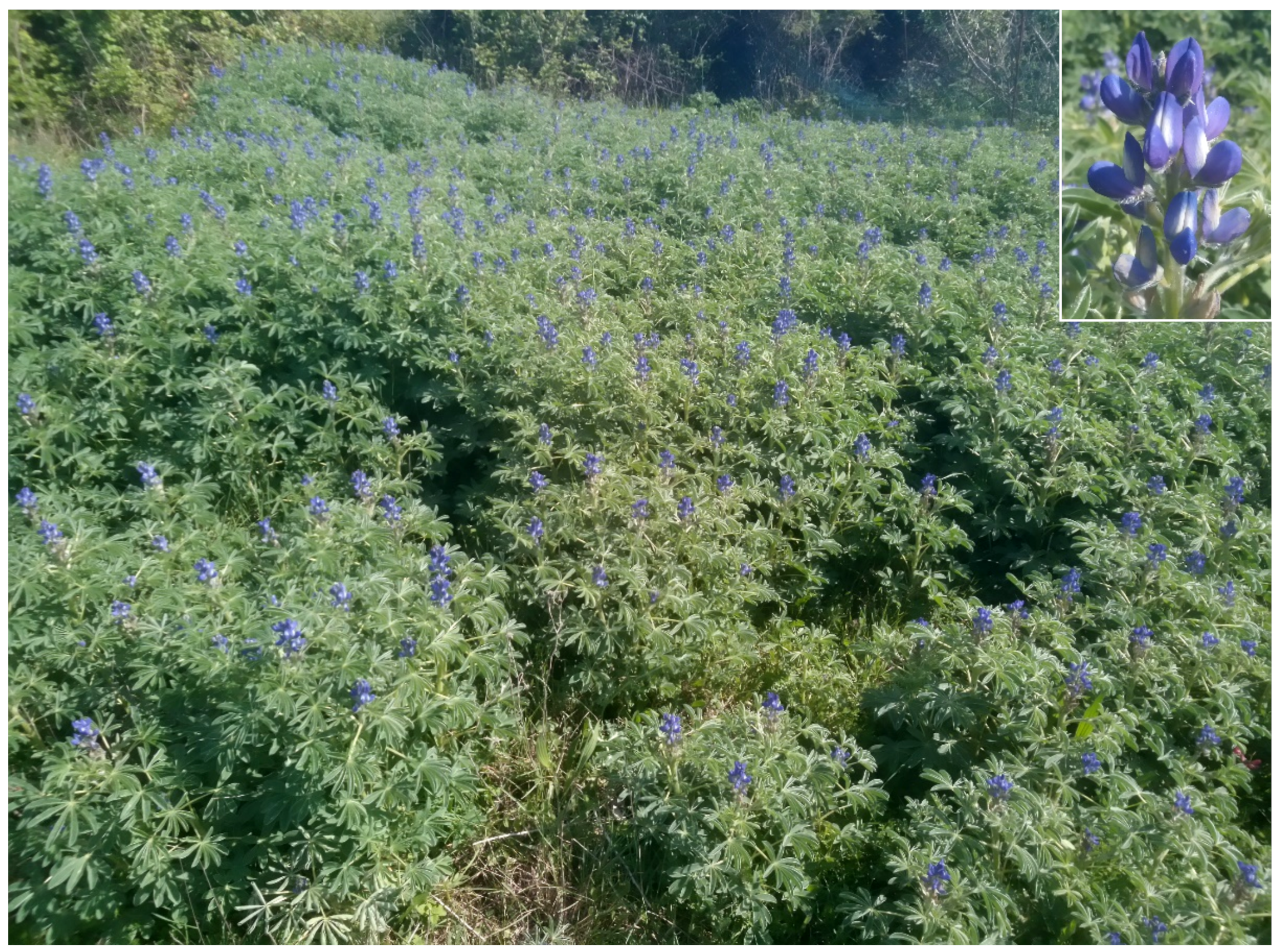
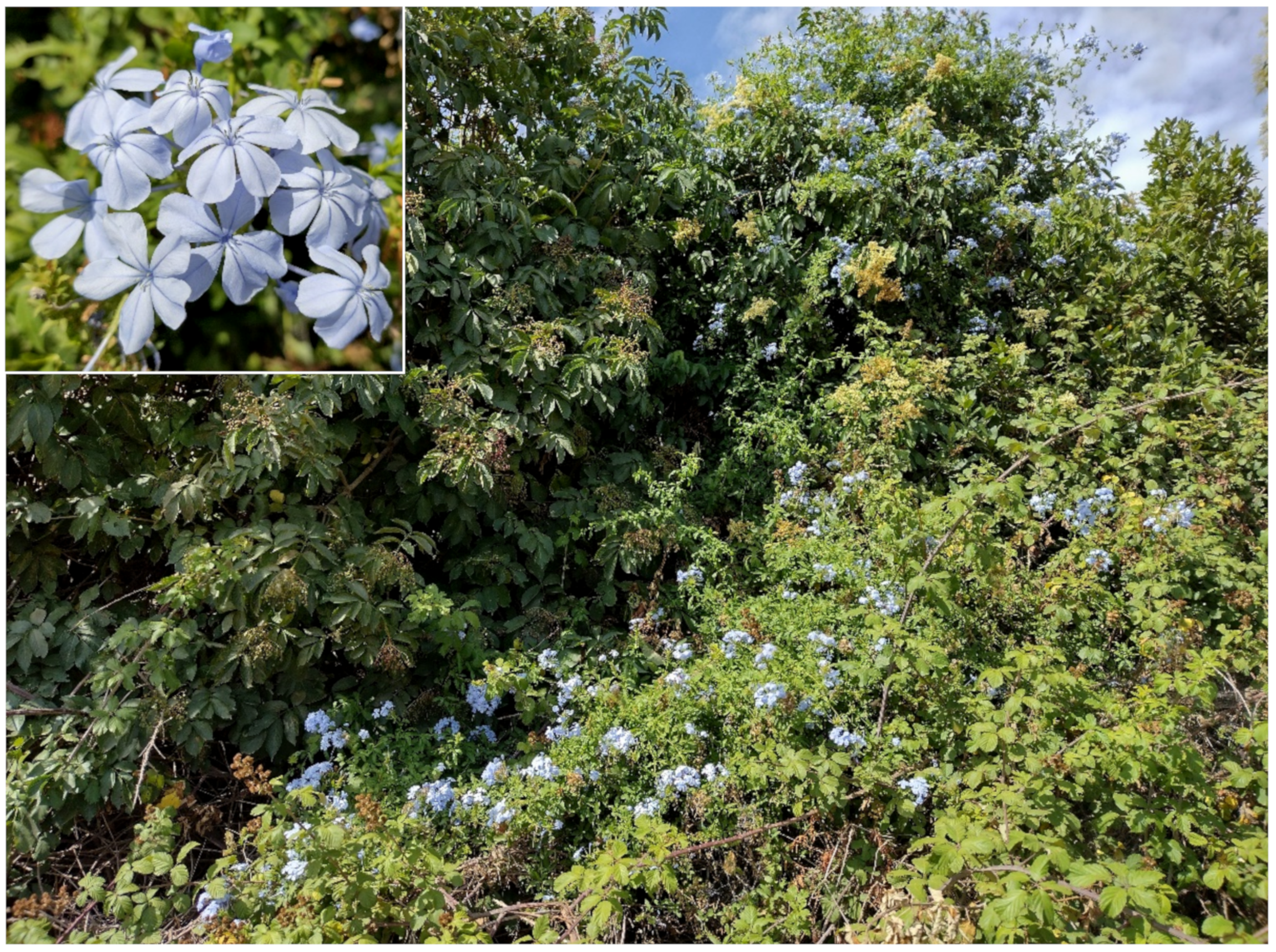


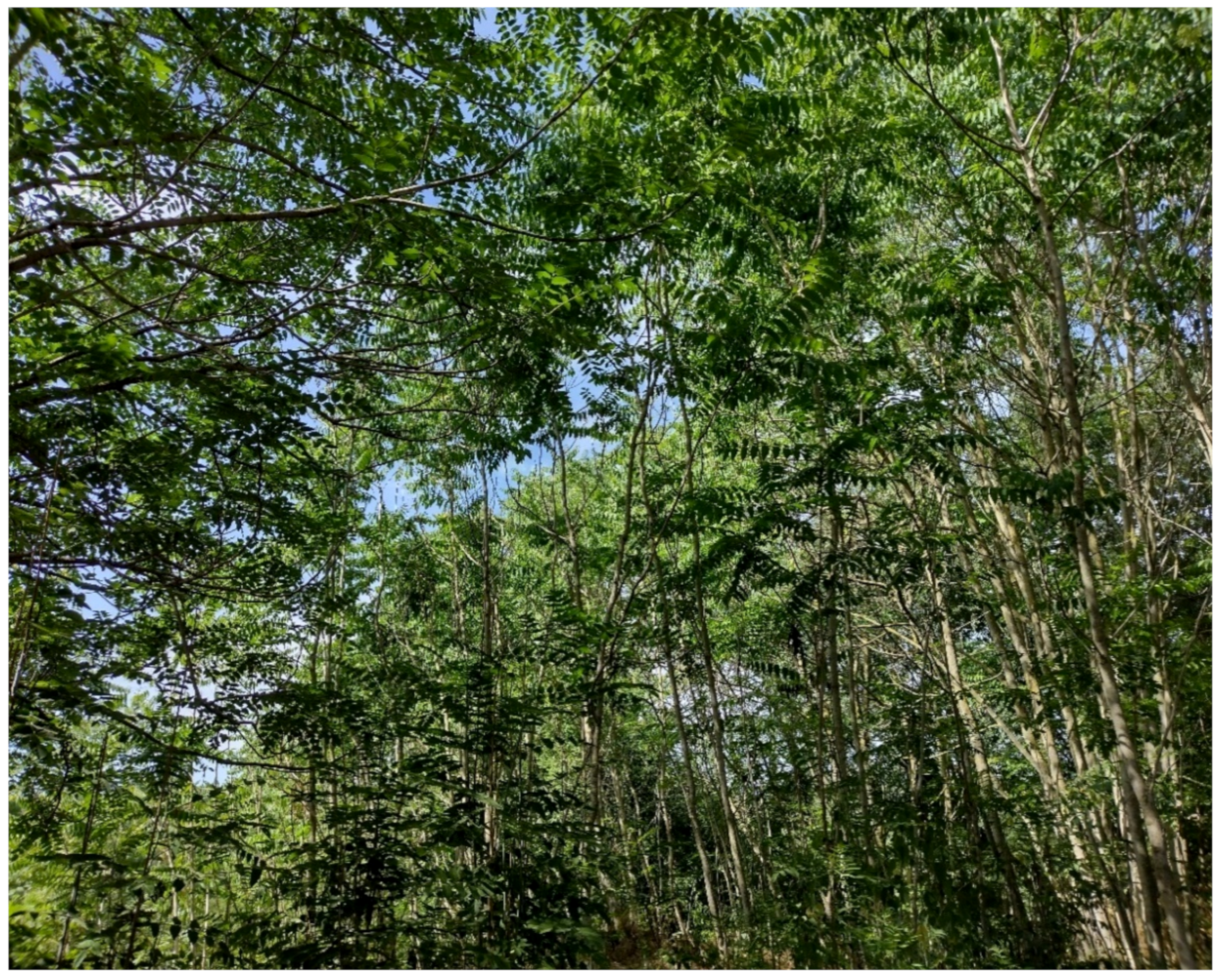
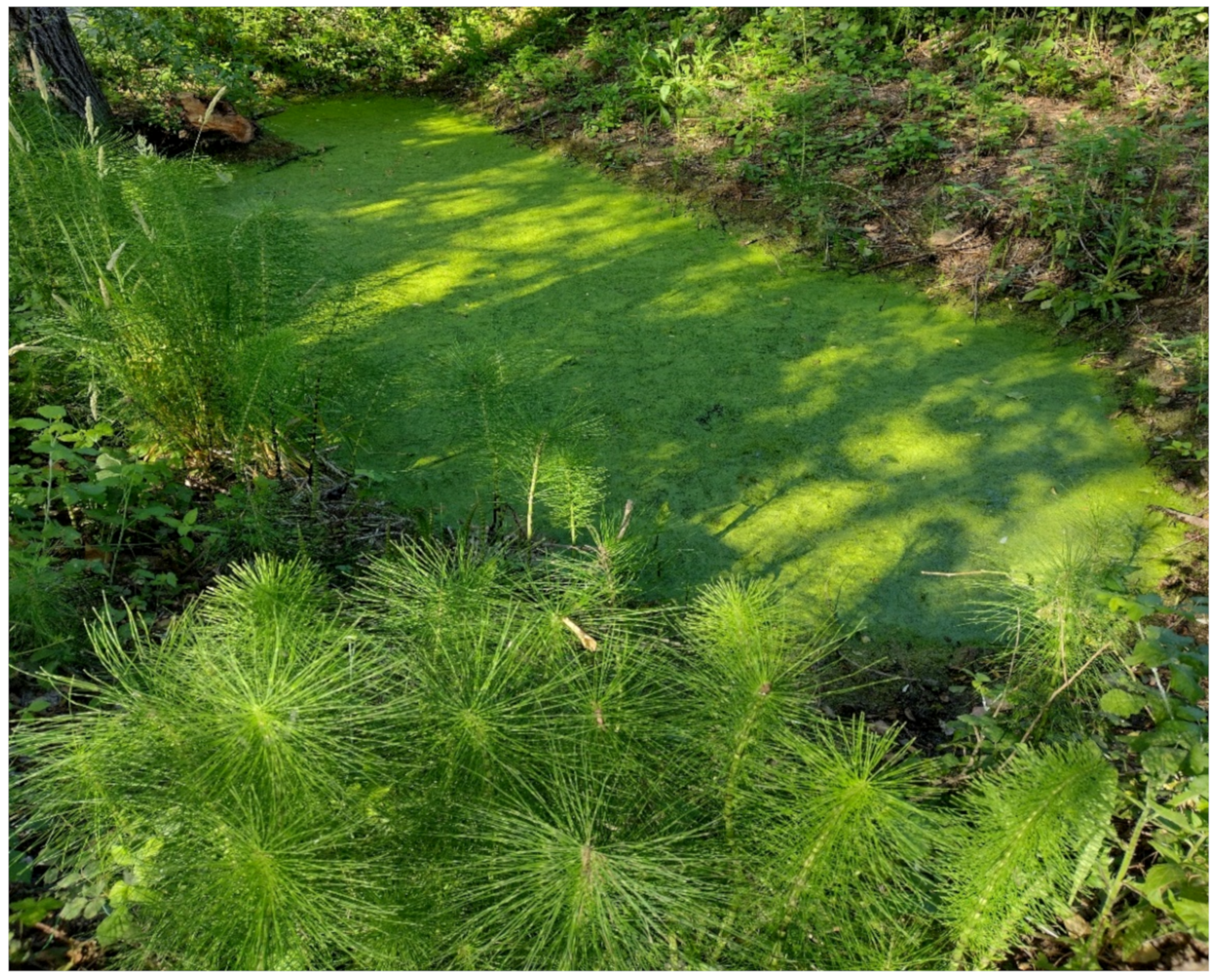


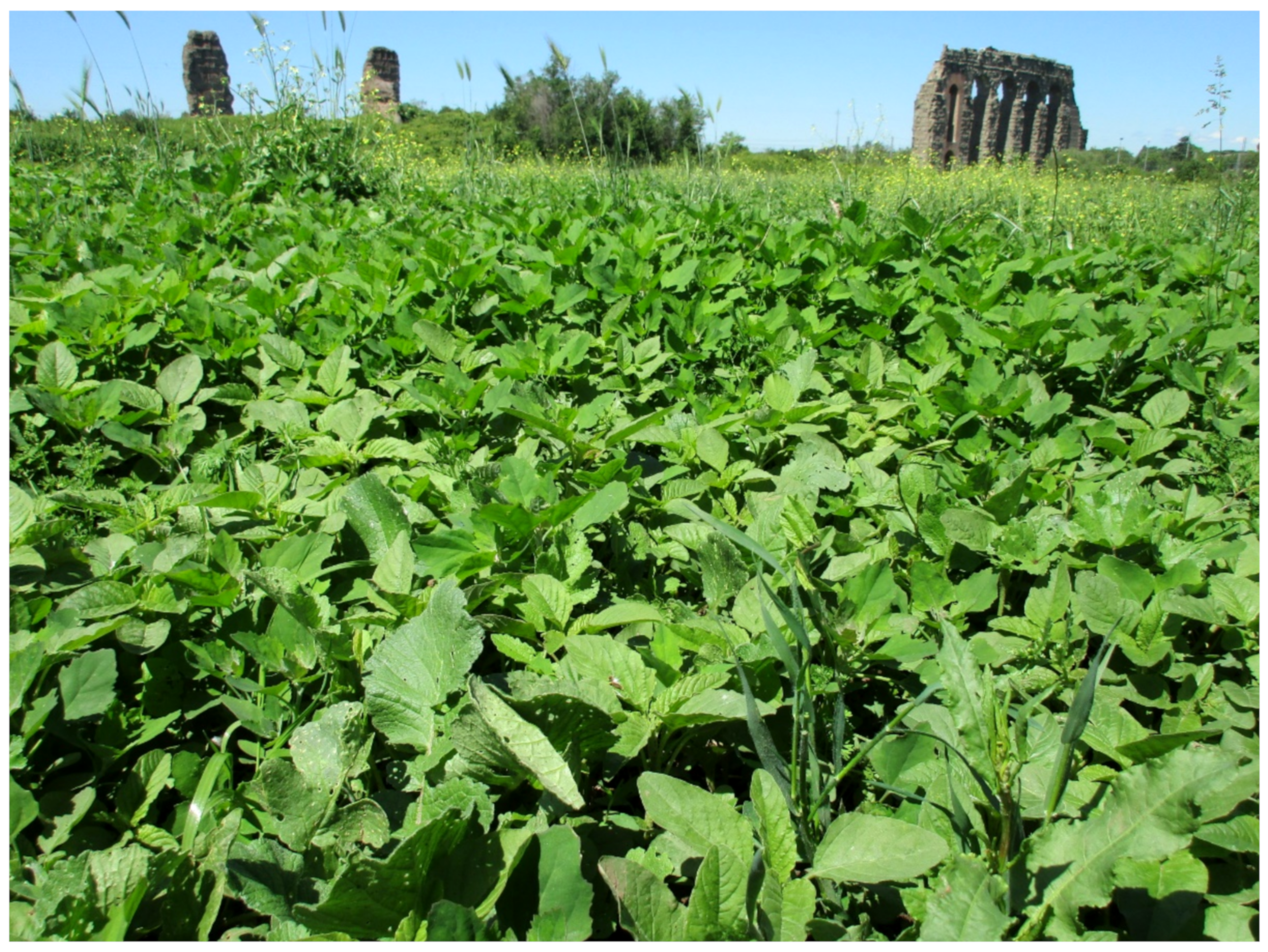
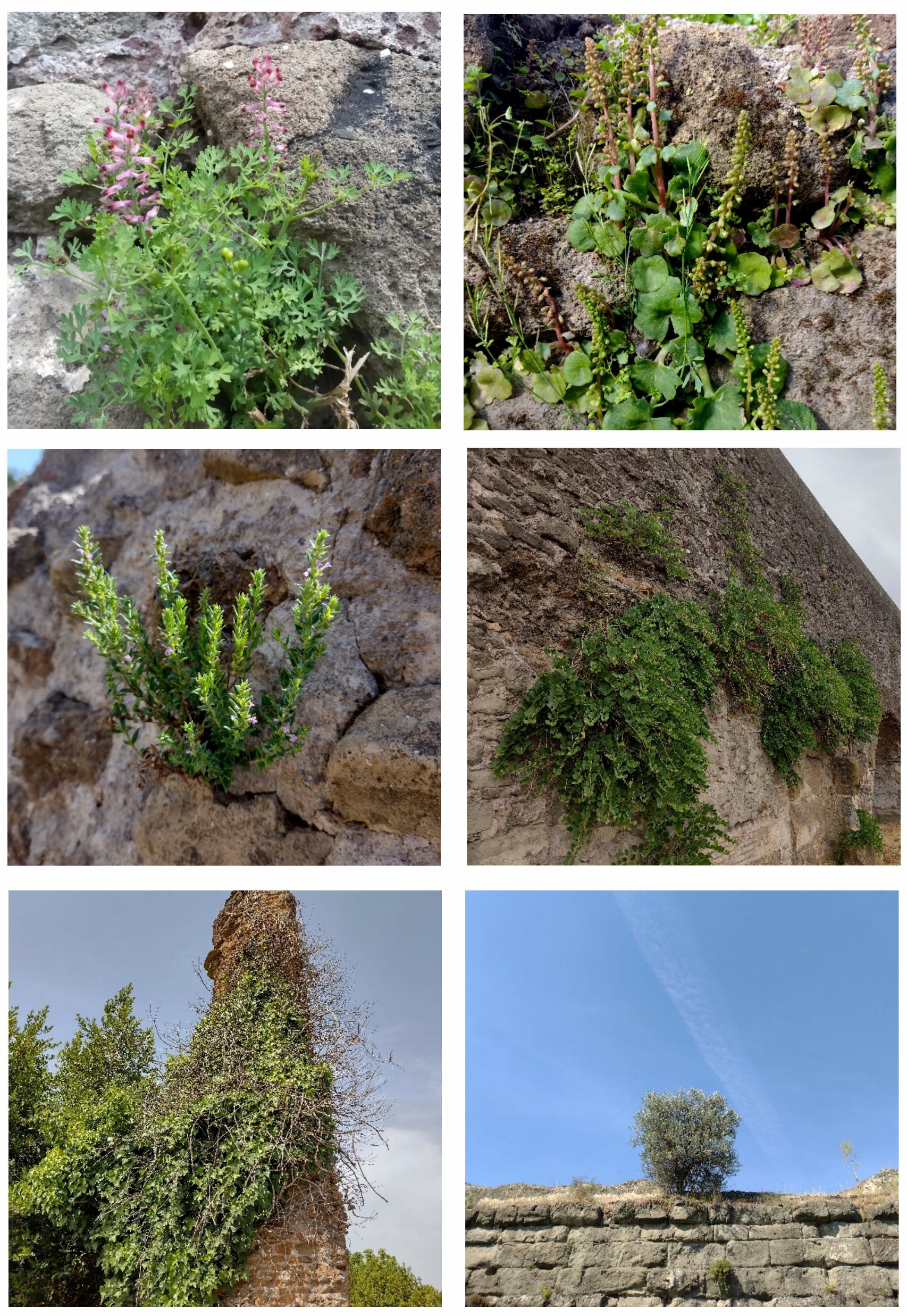

| * Alopecurus myosuroides Huds, subsp. myosuroides |
| Anisantha diandra (Roth) Tutin ex Tzvelev |
| Anthemis arvensis L. subsp. arvensis |
| Anthemis cotula L. |
| * Aphanes arvensis L. |
| Avena sterilis L. subsp. sterilis |
| * Ballota nigra L. subsp. meridionalis (Bég.) Bég. |
| Buglossoides arvensis (L.) I.M.Johnst. |
| * Cyanus segetum L. |
| * Delphinium consolida L. subsp. consolida |
| * Ervilia hirsuta (L.) Opiz |
| * Ervum tetraspermum L. |
| * Euphorbia exigua L. subsp. exigua |
| * Euphorbia falcata L. subsp. falcata |
| Filago germanica (L.) Huds. |
| Gladiolus italicus Mill. |
| Herniaria glabra L. |
| Herniaria hirsuta L. subsp. hirsuta |
| Lamium purpureum L. |
| Lathyrus annuus L. |
| Lathyrus aphaca L. subsp. aphaca |
| * Legousia speculum-veneris (L.) Chaix subsp. speculum-veneris |
| Lysimachia arvensis (L.) U.Manns & Anderb. subsp. arvensis |
| Matricaria chamomilla L. |
| Muscari comosum (L.) Mill. |
| Myosotis arvensis (L.) Hill subsp. arvensis |
| Neslia paniculata (L.) Desv. subsp. thracica (Velen.) Bornm. |
| Orobanche crenata Forssk. |
| * Papaver dubium L. |
| * Papaver hybridum L. |
| * Papaver rhoeas L. |
| Phalaris paradoxa L. |
| Rapistrum rugosum (L.) All. |
| Sinapis alba L. subsp. alba |
| Sinapis arvensis L. subsp. arvensis |
| * Spergula arvensis L. |
| Valerianella eriocarpa Desv. |
| Veronica arvensis L. |
| Veronica polita Fr. |
| Vicia bithynica (L.) L. |
| Native Taxa | Alien Taxa | |||
|---|---|---|---|---|
| Biological Form | N° of Taxa | Percentage | N° of Taxa | Percentage |
| P scapose | 30 | 4.20 | 11 | 1.54 |
| P caespitose | 22 | 3.08 | 10 | 1.40 |
| P lianose | 7 | 0.98 | 6 | 0.84 |
| P succulent | 0 | 0 | 1 | 0.14 |
| Nano-phanerophytes | 11 | 1.54 | 6 | 0.84 |
| Total | 70 | 9.80 | 36 | 5.04 |
| Type of Novelty | Scientific Name |
|---|---|
| First record for Europe and first one out of the native range | Denisophytum bessac (Choiv.) E.Gagnon & G.P.Lewis |
| First confirmed records for Italy | Euphorbia pulcherima Willd. ex Klotzsch Rosa chinensis Jacq. var. semperflorens (Curtis) Koehne |
| First naturalized occurrence for Italy | Aloe maculata All. subsp. maculata |
| First records for Latium region | Heliotropium amplexicaule Vahl. Hydrangea macrophylla (Thunb.) Ser. Ruellia simplex C.Wright Trachelospermum jasminoides (Lindl.) Lem. |
| Change in alien status for Latium region, from casual to naturalized | Campsis radicans (L.) Bureau Canna indica L. Cyperus alternifolius L. subsp. flabelliforme Kük. Kalanchoe daigremontiana Raym. |
| Confirmation as alien in Latium region | Melia azedarach L. Punica granatum L. |
| New records for the flora of Rome | Bidens subalternans DC. Chlorophytum comosum (Thumbs.) Jacques Zantedeschia aetiopica (L.) Spreng. |
| Confirmations for the flora of Rome | Anreedera cordifolia (Ten.) Steenis Diospyrus kaki L. Papaver somniferum L. Passiflora caerulea L. |
Publisher’s Note: MDPI stays neutral with regard to jurisdictional claims in published maps and institutional affiliations. |
© 2022 by the author. Licensee MDPI, Basel, Switzerland. This article is an open access article distributed under the terms and conditions of the Creative Commons Attribution (CC BY) license (https://creativecommons.org/licenses/by/4.0/).
Share and Cite
Iamonico, D. Biodiversity in Urban Areas: The Extraordinary Case of Appia Antica Regional Park (Rome, Italy). Plants 2022, 11, 2122. https://doi.org/10.3390/plants11162122
Iamonico D. Biodiversity in Urban Areas: The Extraordinary Case of Appia Antica Regional Park (Rome, Italy). Plants. 2022; 11(16):2122. https://doi.org/10.3390/plants11162122
Chicago/Turabian StyleIamonico, Duilio. 2022. "Biodiversity in Urban Areas: The Extraordinary Case of Appia Antica Regional Park (Rome, Italy)" Plants 11, no. 16: 2122. https://doi.org/10.3390/plants11162122
APA StyleIamonico, D. (2022). Biodiversity in Urban Areas: The Extraordinary Case of Appia Antica Regional Park (Rome, Italy). Plants, 11(16), 2122. https://doi.org/10.3390/plants11162122






